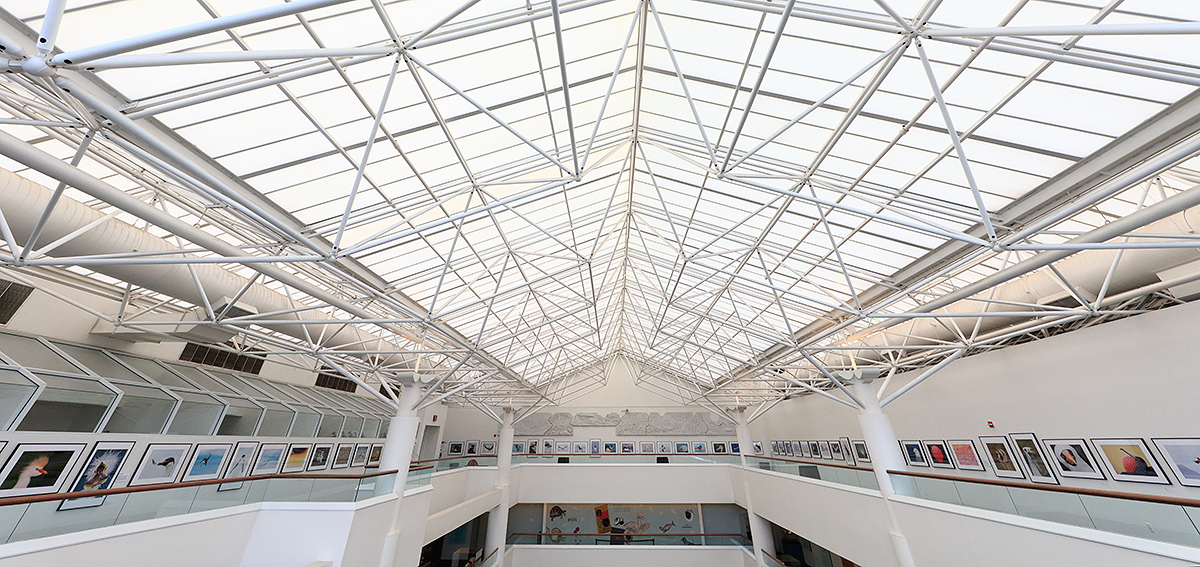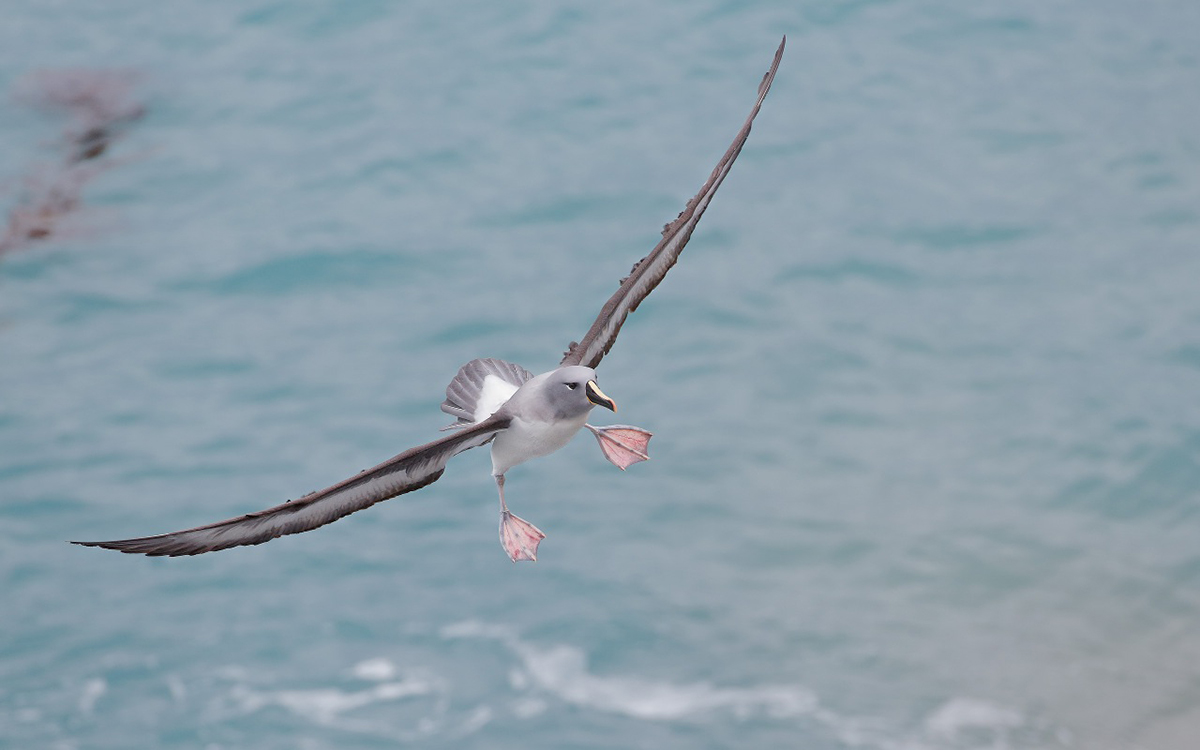January 27th, 2016 What’s Up?
I added about 50 images to the Southern Ocean Photography Guide, ordered some warm clothing for my upcoming Japan trip, and answered another zillion e-mails. Swim, core exercises, ice bath, and three healthy meals made for a perfect day.
Today’s blog post took nearly three hours to assemble, from soup to nuts.
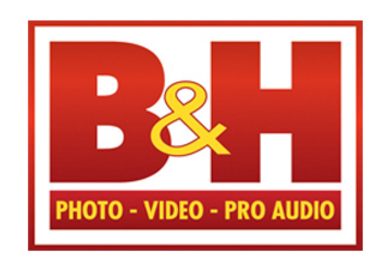
The Streak
In spite of having been buried by travel, teaching, the exhibit, and several major writing projects for the last two months, today’s blog post marks 86 days in a row with a new educational blog post. Again, please remember to use our B&H links for your major gear purchases. Your doing so is always greatly appreciated. 🙂
B&H
B&H was the primary sponsor of my solo, career retrospective, 67-image exhibit at the San Diego Natural History Museum. Thank them (and me, for the work I do on the blog) by clicking on the logo link above to shop for camera bodies and lenses.
Selling Your Used Gear Through BIRDS AS ART
Selling your used (or like-new) photo gear through the BAA Blog or via a BAA Online Bulletin is a great idea. We charge only a 5% commission. One of the more popular used gear for sale sites charges a minimum of 20%. Plus assorted fees! Yikes. The minimum item price here is $500 (or less for a $25 fee). If you are interested please e-mail with the words Items for Sale Info Request cut and pasted into the Subject line :). Stuff that is priced fairly–I offer free pricing advice, usually sells in no time flat. In the past few months, we have sold just about everything in sight. Do know that prices on some items like the EOS-1D Mark IV, the old Canon 500mm, the EOS-7D, and the original 400mm IS DO lens have been dropping steadily. You can see all current listings by clicking here or by clicking on the Used Photo Gear tab on the yellow-orange tab on the right side of the menu bar above.
Douglas Bolt sold his Tamron SP 150-600mm f/5-6.3 Di VC USD Zoom lens for Canon in like-new condition for $699, Diane Miller sold her 300mm f/2.8L IS lens, the old three, for $2899, and Roberta Olenick sold her Canon EOS-1D Mark IV camera body in excellent condition for $1279 USD, all within the last week. I learned last Wednesday that the sale of IPT veteran Brent Bridges’ 300mm f/2.8L IS lens for $4599 is pending. And I learned last Thursay that Mark Hodsgon’s 70-200mm f/4L IS lens became pending on the day that it was listed. More recently Walt Thomas sold his used Canon 100mm f/2.8L IS USM Macro lens in mint condition for $749 and just yesterday Erik Hagstrom sold his Canon EF 24-70mm f/2.8L II USM lens and Bill Condon sold his Canon 500mm f/4L IS USM lens in like-new, near-mint condition for the full asking price, $4199, in one day after getting three offers.
When I sent a follow-up e-mail asking that Bill check the listing, he sent this lovely e-mail in reply:
Artie, the listing was more than perfect. I had three offers in the first 36 hours and my lens was sold for asking price on the second day! I am grateful for your help: your added words gave true legitimacy to the value of my lens. Thank you, thank you, thank you! Bill
After all the work that I have put into the Used Gear Sales Page, I know how to price the stuff fairly so that it will sell fairly quickly. And for items that I am not familiar with I have taught myself how to come up with solid prices…
New Listing
Nikon D4 dSLR Professional Camera Body
Sash Dias is offering a used Nikon D4 body in excellent condition for $2399; the body is pristine except for a small rub mark near the mic button. It is a Nikon USA body, has been babied for its entire life, and has less than 30,000 actuations. The sale includes the Nikon D4 body, the front body cap, the original battery and battery charger and insured shipping via USPS Priority Mail. Your item will not ship until your check clears unless other arrangements are made.
Please contact Sash by e-mail or by phone at 508-439-1097 (Eastern time).
New Nikon Gear
Click here for a link to slew of new Nikon stuff.
|
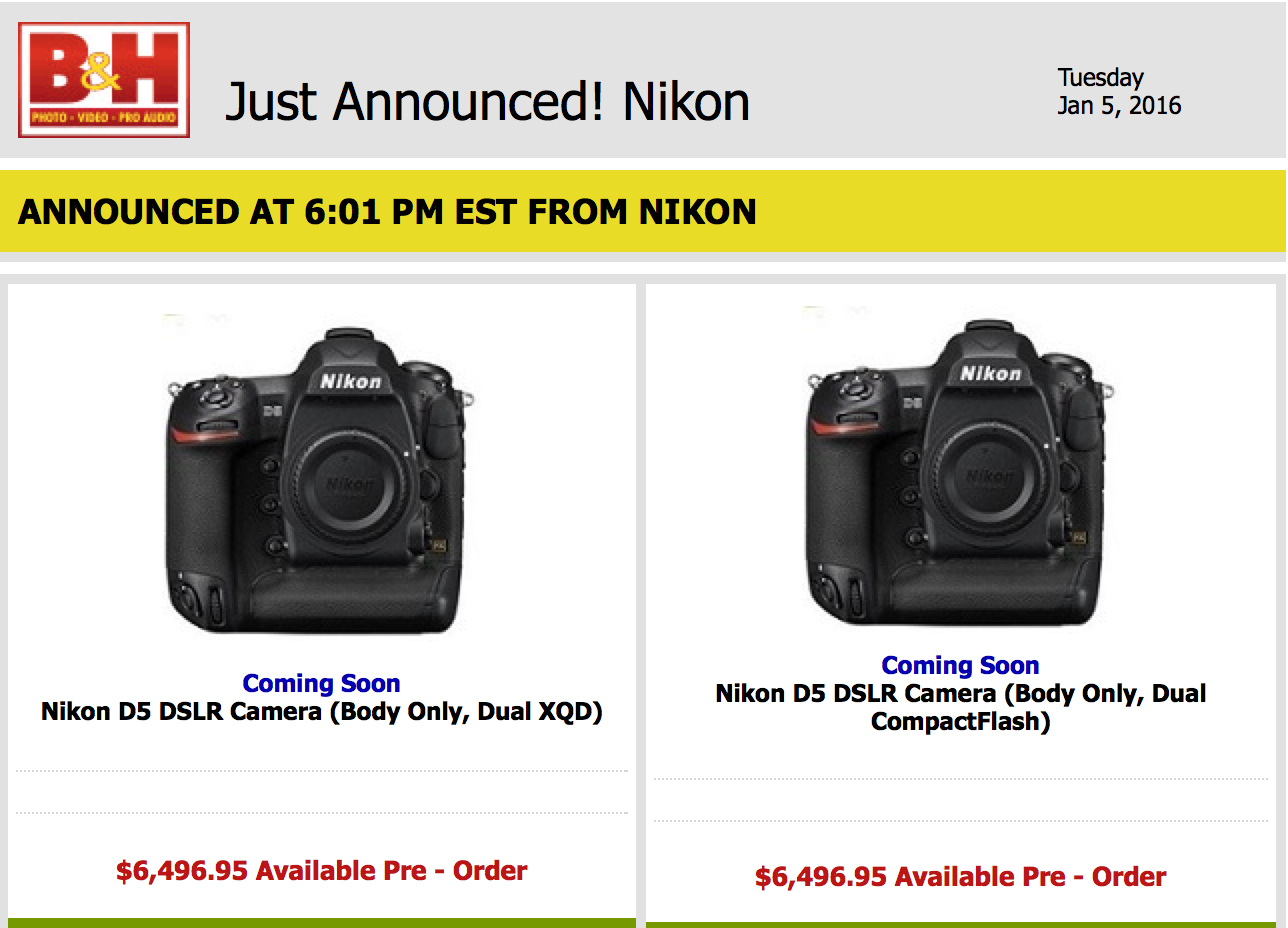
|
|
Nikon’s two new flagship bodies are available for pre-order now; if you want and need one of these, please use one of the two product specific links below to support my efforts here on the BAA Blog.
|
Nikon’s Two New Flagship DSLRs
About ten days ago Nikon introduced two flagship camera bodies, the Nikon D5 DSLR Camera (Dual CompactFlash) and the Nikon D5 DSLR Camera (Dual XQD). XQD is a new, faster type of card.
Canon EOS-1D X II
As for me, I can’t wait for the 1D X II to be announced…
|
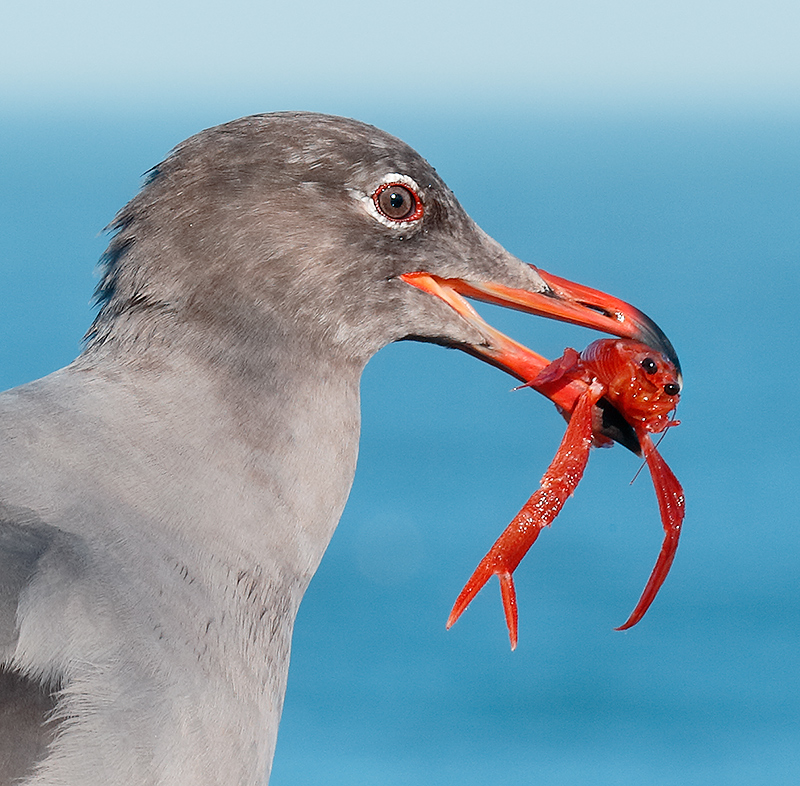
|
|
This is the original image (see photo next) from which this tight crop was created was made on the first morning of the 2015 San Diego IPT with the hand held Canon EF 100-400mm f/4.5-5.6L IS II USM lens and the Canon Extender EF 1.4X III with the rugged Canon EOS-1D X. ISO 400. Evaluative metering +1/3 stop: 1/160 sec. at f/18 in Manual mode was less than ideal.
Center AF point (by necessity)/AI Servo Expand/Rear Focus AF as originally framed was active at the moment of exposure (as is always best when hand holding). Click here to see the latest version of the Rear Focus Tutorial. Click on the image to see a larger version.
Tight crop of Heermann’s Gull with some sort of immature lobster as prey
|
The Amazing Answer to the Red Regurgitant Mystery…
I was “down in the hole” on the cliffs in late morning doing tight bill shots of the pelicans when I saw a winter adult Heermann’s Gull land on the sandstone ridge well above me and well to my right. Bummer. I screamed to the nearby group members as I snapped off two quick ones and then scrambled into position for a better shot but the gull had already removed the claws.
If anyone know the species of the prey item please leave a comment. Would it be properly classed a larvae or as an immature or as a baby? Or is it fully grown? I did some surfing and thought that it was a California Spiny Lobster until I got to the part about “no large claws on its legs.” (David Policansky, are you there?)
In any case, it was pretty neat. Several of the folks on the IPT were in perfect position. If anyone got anything great please shoot me a 1200 wide sharpened JPEG via e-mail.
Image Question
Why were the exposure setting less than ideal?
|
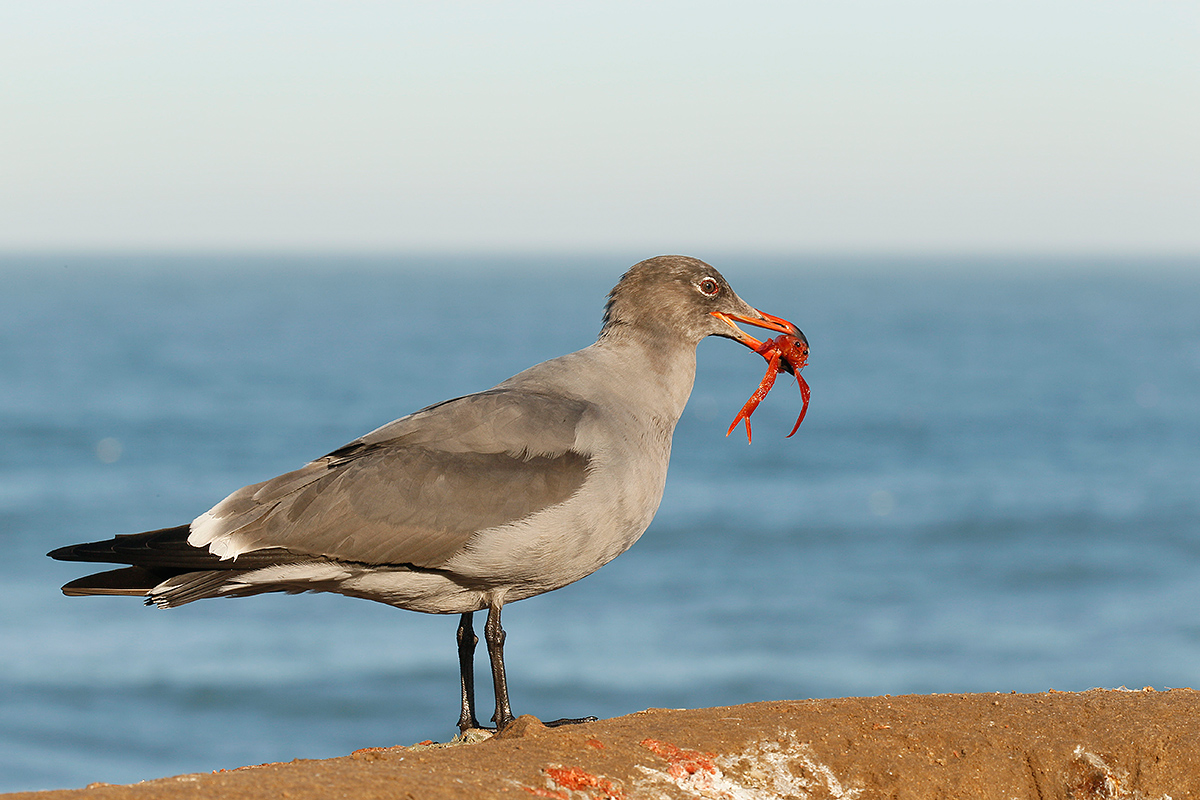
|
|
This JPEG represents the original capture.
|
Critique Please
In the follow-up to the hugely popular and somewhat controversial blog post here, Brendan left a comment that I have paraphrased here: One instructional thing I would love to see on this blog is a basic lesson on how to look critically look at one’s photos. About eight years ago I began saving series of similar images from which I planned to do an Evaluating Your Images guide. At some point, I lost that file. I started a new one and eventually lost that one too. 🙁
In the meantime we can start by looking at today’s featured image. It is sharp and it is well exposed and the bird is placed nicely back in the frame. Were it not for the baby lobster (or whatever it is) this photograph would have been deleted instantly for several reasons.
Please, please, pretty please leave a comment and let us know the major problems in this image. There are at least three major problems but two of those are closely related. Those problems are very common ones… (Folks have been getting lazy about leaving comments and keeping the blog interactive.)
BirdPhotographer’s.Net (BPN)
The very best way to learn to evaluate your images is to plunk down your forty bucks and join BPN. You post your images and have them critiqued by many of our fine moderators and lots of skilled members, and in turn, you get to learn a ton by commenting on the images of others. And best of all, it ain’t just birds! There are image critique forums that cover other areas. These include Wildlife, Macro and Flora, Landscapes, Cityscapes and Travel, Out Of The Box, In Camera and Post Processing Techniques, Framing Your Images With Words, and Story Sequences. In addition, beginning nature photographers can receive extra help in the Eager to Learn Forum. You can click here to access any of the aforementioned forums in addition to the Photography Discussion (and other) forums. If you join and post an image please e-mail me the link and I will be glad to stop by and comment.
|
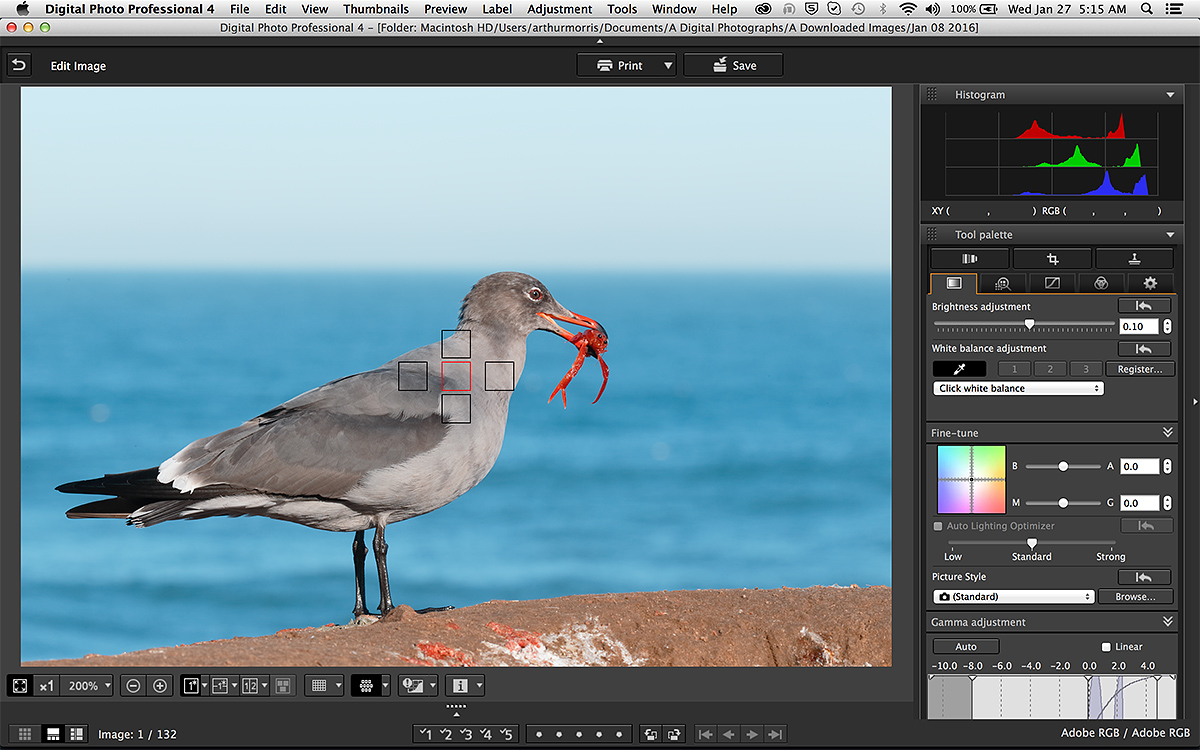
|
|
This is a DPP 4 Screen Capture for today’s featured image.
|
DPP 4 Screen Capture
The important thing to note here is that I used Click White Balance on the very white tail tip to eliminate the warm reddish cast that you can see in the JPEG that represents the original capture (today’s 2nd photo).
AF Question
Why was I limited to only the center AF point? I hear this about six times a day on most IPTs: My camera is broken; I can’t move my AF point!”
|
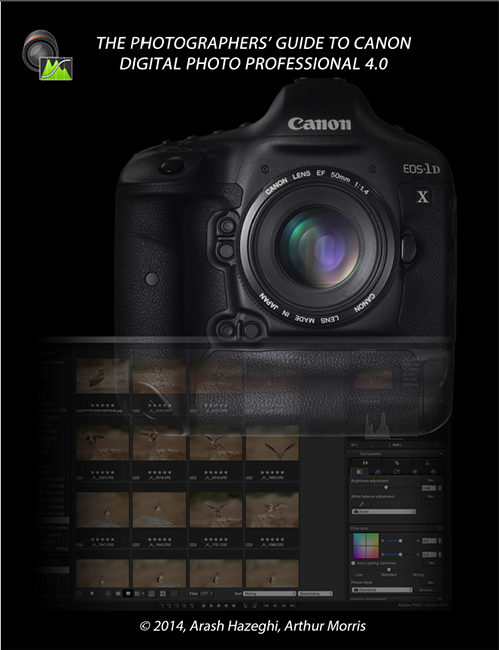
|
|
You can order your copy of “The Photographers’ Guide to Canon Digital Photo Professional 4.0” (aka the DPP 4 Raw Conversion eGuide) by Arash Hazeghi and Arthur Morris by clicking here.
|
The DPP 4 eGuide (PDF)
Learn how and why I and many other discerning photographers choose and use only DPP 4 to convert their Canon RAW files in the DPP 4 RAW Conversion Guide by Arash Hazeghi and yours truly. The latest version supports all of the newer Canon camera bodies and several older models including the EOS-7D and the EOS-1D Mark IV. The DPP IV Guide is the ideal companion to the 7D Mark II User’s Guide, a runaway best seller.
The DPP 4 eGuide (PDF) Updated for 1D Mark IV and the original 7D
The DPP 4 eGuide was recently updated to include the luminance and chrominance noise reduction values for both the 1D Mark IV and the original 7D. If you purchased your copy from BAA please e-mail Jim and request the DPP 4 1D IV/7D update. Please be sure to cut and paste page 1 of the guide into your e-mail as proof of purchase.
2017 San Diego 4 1/2-DAY BIRDS AS ART Instructional Photo-Tour (IPT) JAN 11 thru and including the morning session on JAN 15: 4 1/2 days: $1999.
(Limit: 10/openings 8)
Meet and Greet at 7:00pm on the evening before the IPT begins; Tuesday 1/10/17.
Join me in San Diego to photograph the spectacular breeding plumage Brown Pelicans with their fire-engine red and olive green bill pouches; Brandt’s and Double-crested Cormorants; breeding plumage Wood and Ring-necked Duck; other duck species possible including Lesser Scaup, Redhead, and Surf Scoter; a variety of gulls including Western, California, and the gorgeous Heerman’s, all in full breeding plumage; shorebirds including Marbled Godwit, Willet, Sanderling and Black-bellied Plover; many others possible including Least, Western, and Spotted Sandpiper, Whimbrel, Black and Ruddy Turnstone, Semipalmated Plover, and Surfbird; Harbor Seals (depending on the current regulations) and California Sea Lions; and Bird of Paradise flowers. And as you can see by studying the two IPT cards there are some nice bird-scape and landscape opportunities as well.
With gorgeous subjects just sitting there waiting to have their pictures taken, photographing the pelicans on the cliffs is about as easy as nature photography gets. With the winds from the east almost every morning there is usually some excellent flight photography. And the pelicans are almost always doing something interesting: preening, scratching, bill pouch cleaning, or squabbling. And then there are those crazy head throws that are thought to be a form of intra-flock communication.
Did I mention that there are wealth of great birds and natural history subjects in San Diego in winter?
For complete 2017 San Diego ITP info please click here.
Please Remember to use our Affiliate Links 🙂
To show your appreciation for my continuing efforts here, we ask, as always, that you get in the habit of using my B&H affiliate links on the right side of the blog for all of your photo and electronics purchases. Please check the availability of all photographic accessories in the BIRDS AS ART Online Store, especially the Mongoose M3.6 tripod heads, Gitzo tripods, Wimberley heads and plates, LensCoats and accessories, and the like. We sell only what I have used, have tested, and can depend on. We will not sell you junk. We know what you need to make creating great images easy and fun. And we are always glad to answer your gear questions via e-mail. I just learned that my account was suspended during my absence; it should be up and running by Monday at the latest.
I would of course appreciate your using our B&H affiliate links for all of your major gear, video, and electronic purchases. For the photographic stuff mentioned in the paragraph above we, meaning BAA, would of course greatly appreciate your business. Here is a huge thank you to the many who have been using our links on a regular basis and visiting the BAA Online store as well.
Facebook
Be sure to like and follow BAA on Facebook by clicking on the logo link upper right. Tanks a stack!
Typos
In all blog posts and Bulletins, feel free to e-mail or to leave a comment regarding any typos or errors. Just be right 🙂
January 26th, 2016 What’s Up?
Most of Monday was spent putting photographs in the Southern Ocean Photography Guide. And answering a zillion e-mails as always.
Though the pool has been quite chilly, I have been swimming every day. It was in the mid-thirties on Sunday evening and the pool was down to 68 degrees when I checked early on Monday morning. By the time I got in the pool it was up to 70. I did some core exercises and enjoyed a nice ice bath; the water was 59 degrees when I got out.
I learned yesterday that Walt Thomas sold his Canon 100mm f/2.8L IS macro lens and that Erik Hagstrom sold his Canon 24-70 f/2.8L lens as well. Both had recently lowered their prices; it is all a matter of supply and demand. You can see all the current listings here; there are some truly amazing values…
|
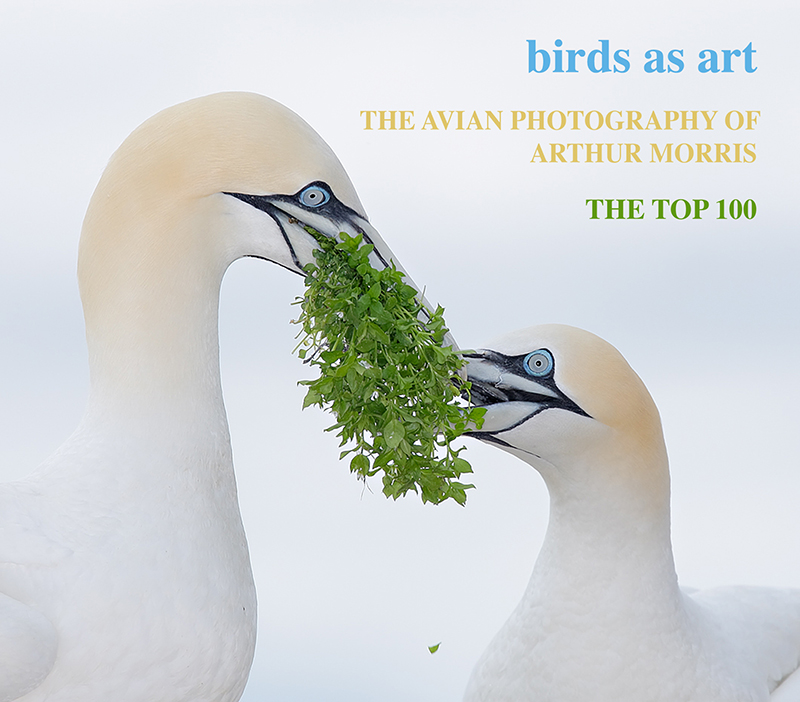
|
birds as art: The Avian Photography of Arthur Morris/The Top 100
The companion e-book to the solo exhibit at TheNat, San Diego, California
The new e-book on CD is available here. The new e-book via is also available via convenient download for $20 by clicking here.
|
What They Are Saying
The new e-book has received only rave reviews. By phone, BAA-friend Bill Goodhew advised that I should raise the price to a more realistic $50. We have heard from a few folks as below and would love to hear from more of you.
Jim Amato via comment at yesterday’s blog post
Betidings birders, Arthur’s CD, The Avian Photography of Arthur Morris, arrived today. It is a magnificent album of beautiful birds captured in their wonderful habitats. You gotta have this compilation of astounding work. Arthur has presented many, maybe all, of these images on this blog and as striking as they are on the blog, they blast off the screen on my 27 inch iMac. They will create neighborhood hysteria if shown on the new OLED 70 inch televisions. Click on the link and order a copy now! I am not related to, do not work for or volunteer with Arthur or BAA. This is one excellent CD of our feathered friends.
From Multiple IPT Veteran Doug West
I just received The Top 100 CD! I felt like a kid checking the mailbox to see if it had come! Here’s my review:
The first thing I fell in love with was the packaging. At first I didn’t think that the CD was in there due to the photo on the CD blending in with the background photo; I think my heart stopped for a second. The images of course are gorgeous. Art could’ve picked his bottom 100 images and those would still be my top 100. How in the world this man picked 100 images from roughly 32 years of doing this is amazing.
If I had to pick my favorite image, it would be on the displaying frigatebird on Page 14 – Showing Off. This one really threw my head back. I think it was due to the fact it almost looks like three different birds: the bird displaying and the two different ways the layers of feathers are laid out. The background making it pop out is the kicker.
Reading the notes and details is always fun, but I also like to read between the lines. There might be a few people who will bring up that there isn’t a year listed for each image. An estimate can be figured out if you pay attention to the camera body that was used. I counted at ‘least’ 12 different bodies by the way.
This CD is a fantastic teaching tool for those who study the images. Remember to look carefully at the head angles and the composition, the behavior, or the action. Then try to apply it yourself the next time you go out. Doug
From Multiple IPT Veteran Stephen Leimberg
Art, this is the most beautiful book on bird photography I’ve ever seen! What an inspiration! A visual feast! Bravo! Warmest, Steve
From Mike Moore via e-mail
The top 100 collection is almost too overwhelming to absorb at once. I will be looking at it many, many times to be able to drink it all in. I will say I never really appreciated blurs, but Cottonwood Morning Wave is one of my favorite images. The colors and the composition are superb. There is a real feeling of being present at a live event that a sharp photo would not have conveyed, so maybe you won me over. You give a 100 great examples of something for us to strive for. I especially appreciated that you annotated every image to get a sense of what it took to capture it. Brilliant. Congratulations and thanks for sharing and making it so affordable to own this collection of some of the world’s greatest bird images.
From IPT Veteran Larry Master via e-mail
I just downloaded your new collection of 100 images! Wow! I’ve seen many before in your posts but to view as one collection it is amazing. Larry
Additional Feedback Requested
If you ordered via download or have already received your CD, I would love to hear what you think. Please do leave a comment or shoot me an e-mail.
|
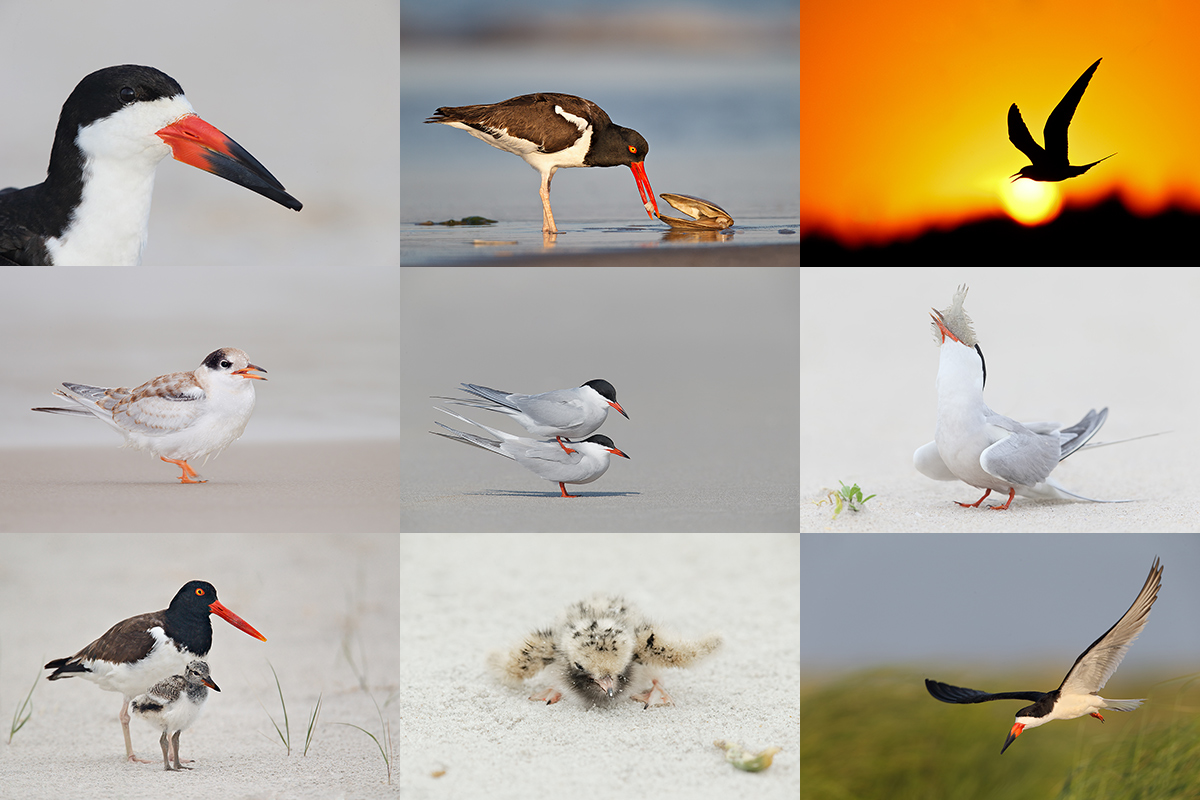
|
|
From upper left clockwise to center: Black Skimmer head portrait, American Oystercatcher dining on surf clam flesh, Common Tern at sunset, Common Tern adult swallowing flatfish, Black Skimmer in flight, newborn Common Tern chick, American Oystercatcher with chick, fresh juvenile Common Tern (with fill flash), and Common Terns copulating.
|
Nickerson Beach Terns/Skimmers/Oystercatchers Instructional Photo-Tour (IPT): July 18-22, 2016. 4 1/2 DAYS: $1899.
Meet and greet at 3pm on the afternoon of Monday, July 18. Limit 10.
The primary subject species of this IPT will be the nesting Common Terns. The trip is timed so that we will get to photograph tiny chicks as well as fledglings. There will be lots of flight photography including adults flying with baitfish. Creating great images of the chicks being fed is a huge challenge. In addition to the terns we will get to photograph lots of Black Skimmers courting, setting up their nesting territories, and in flight (both singles and large pre-dawn flocks blasting off). Midair battles are guaranteed on sunny afternoons. And with luck, we might even see a few tiny chicks toward the end of the trip. We will also get to photograph the life cycle of American Oystercatcher. This will likely include nests with eggs and tiny chicks, young being fed, and possibly a few fledglings.
Nesting Piping Plover is also possibly. There will be lots of gulls to photograph; most years I am able to find a few Lesser Black-backed Gulls of varying ages in addition to the Herring, Ring-billed, and Great Black-backed Gulls. You will learn to identify and age the various gull species. There will likely be some Willets feeding along the surf and with luck we might get to photograph a handsome juvenile or two. In addition to the locally breeding shorebirds, we will likely get to see some southbound migrant arctic-and sub-arctic breeding shorebird species such as Sanderling, Semipalmated Plover, and maybe even Red Knot.
|
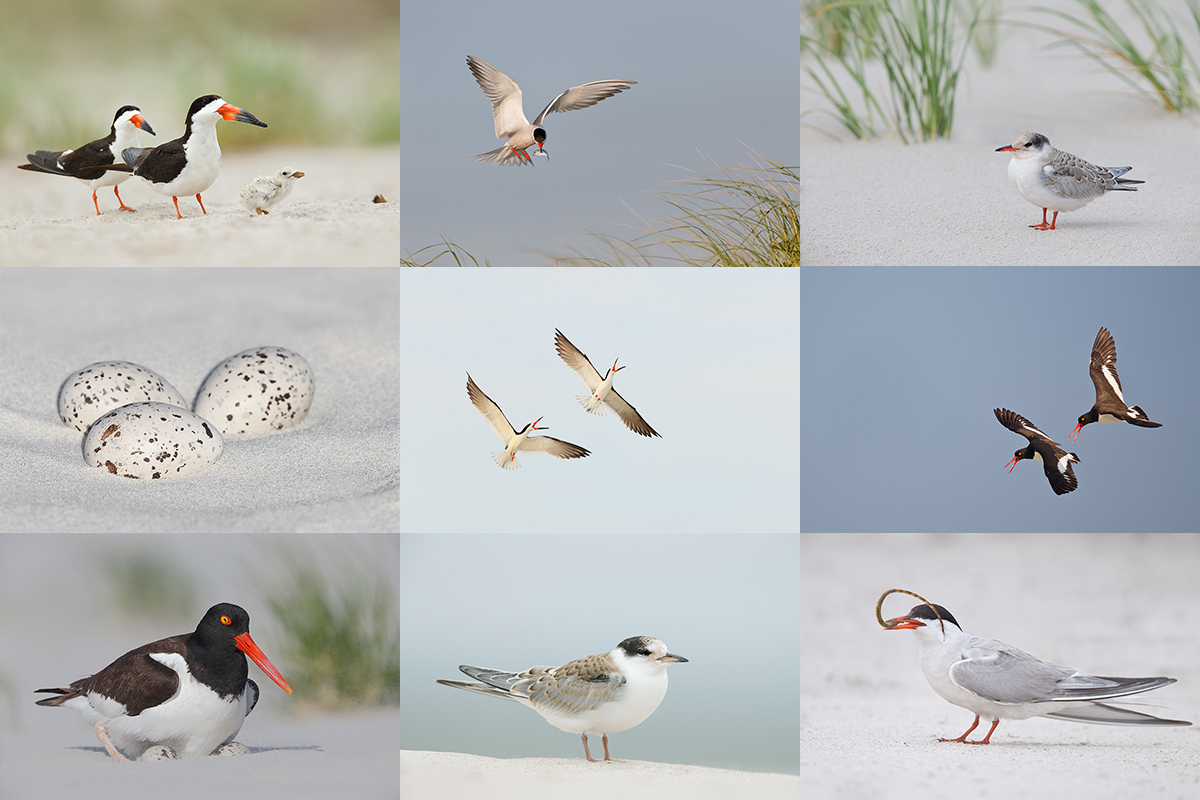
|
|
From upper left clockwise to center: Black Skimmers with tiny chick, Common Tern landing with baitfish for young, fledged Common Tern chick in dunes, American Oystercatchers/display flight, adult Common Tern with pipefish for chick, Common Tern fledgling in soft light, American Oystercatcher on nest with eggs, American Oystercatcher 3-egg clutch, battling Black Skimmers.
|
The IPT Logistics
The tour will begin with our meet and greet on the afternoon of Monday, July 18, 2016. That will be followed by our first shooting session at the beach. From Tuesday through and including all of Friday we will have two photography sessions daily. Our morning sessions will start very early so that we are on the beach well before sunrise. We usually photograph for about four hours. Then we will enjoy a group brunch. We will always have a midday break that will include a nap for me. That followed by our daily afternoon classroom sessions that will include image review, workflow and Photoshop, and a review/critique of five of your trip images. Folks are always invited to bring their laptops to brunch for image sharing. I always have mine with me but heck, I am a big show-off. Afternoon in-the-field sessions generally run from 5pm through sunset.
Breakfasts are grab what you can. Four brunches are included. Dinners (if at all) will be on your own as we will often get back to the hotel at about 9pm. There is a fridge in every room and a supermarket within walking distance of the hotel so nobody should starve. You will learn a ton during the nine shooting sessions, the four in-classroom sessions, and even at lunch. Early morning and late afternoon parking is free. If we want to head back to the beach early we will need to arrange tight carpools and share the $30/vehicle parking fee. Non-photographer spouses, friends, or companions are welcome for $100/day, $450 for the whole IPT.
Save a space by calling Jim or Jen at the office at 863-692-0906 and arranging to leave your deposit of $599–credit cards are accepted for deposits only. Your balance will be due on April 18, 2016. I hope that you can join me for what will be an exciting and educational IPT.
Card Image Question
Click on each IPT card to enlarge it. Then leave a comment letting us know which is your very favorite image. And do let us know why. While I love ’em all, I will share my three favorites with you here soon.

B&H
B&H contributed generously as the primary SDNHM exhibition sponsor. Thank them (and me for the blog) by clicking on the logo link above to shop.
Please Remember to use our Affiliate Links 🙂
To show your appreciation for my continuing efforts here, we ask, as always, that you get in the habit of using my B&H affiliate links on the right side of the blog for all of your photo and electronics purchases. Please check the availability of all photographic accessories in the BIRDS AS ART Online Store, especially the Mongoose M3.6 tripod heads, Gitzo tripods, Wimberley heads and plates, LensCoats and accessories, and the like. We sell only what I have used, have tested, and can depend on. We will not sell you junk. We know what you need to make creating great images easy and fun. And we are always glad to answer your gear questions via e-mail. I just learned that my account was suspended during my absence; it should be up and running by Monday at the latest.
I would of course appreciate your using our B&H affiliate links for all of your major gear, video, and electronic purchases. For the photographic stuff mentioned in the paragraph above we, meaning BAA, would of course greatly appreciate your business. Here is a huge thank you to the many who have been using our links on a regular basis and visiting the BAA Online store as well.
Facebook
Be sure to like and follow BAA on Facebook by clicking on the logo link upper right. Tanks a stack!
Typos
In all blog posts and Bulletins, feel free to e-mail or to leave a comment regarding any typos or errors. Just be right 🙂
January 25th, 2016 What’s Up?
I was thrilled that the Denver Bronco defense consistently put Pretty Boy Tom Brady on his ass in the big playoff game yesterday; the Broncos and class-act Peyton Manning are on the way to the Super Bowl. Don’t get me wrong, I have great resect for Brady and what he and Bellicek have accomplished. That last touchdown with Brady under constant pressure and Gronkowski injured yet again was heroic. But justice was served as their two-point conversion attempt failed. What really bothers me about the Patriots is that for the past ten years or so the media always wants to give the Super Bowl rings to New England even before the season starts…
As much as I would like to see Peyton join his kid brother Eli as a two-time Super Bowl winner–both of Eli’s wins of course coming against the highly favored Patriots–it is hard to conceive that Denver can prevent the eventual and inevitable supremacy of the young, strong, and talented Carolina Panthers and their Superman QB, Cam Newton. But heck, as New England finds out often, that’s why they play the games…
And lets’s not forget that the Patriots’ Super Bowl win last year was made possible only by Pete Carroll’s gift via the inane call on first and goal from the one yard line…

B&H
B&H was the primary exhibition sponsor of my solo, career retrospective, 67-image exhibit at the San Diego Natural History Museum. Thank them (and me, for the work I do on the blog) by clicking on the logo link above to shop for camera bodies and lenses.
|
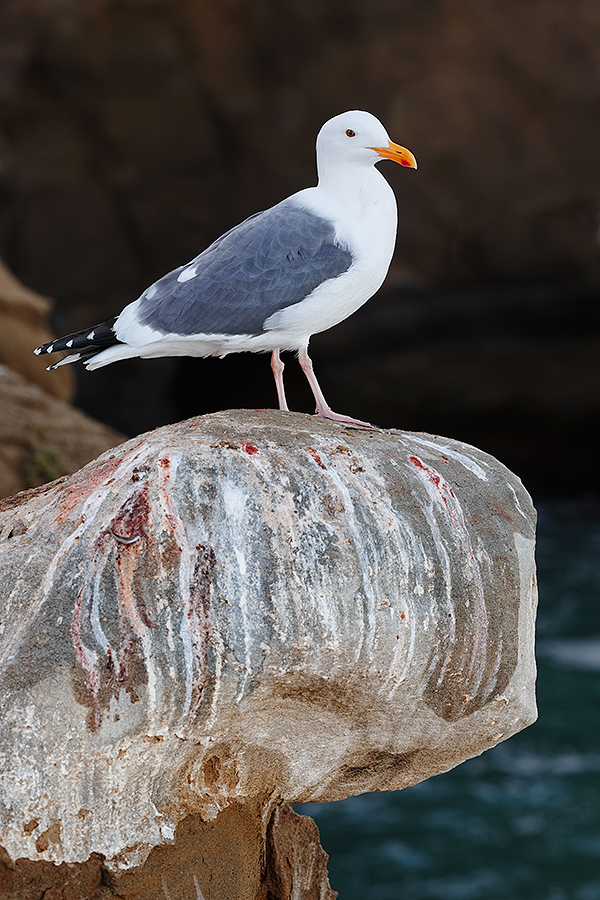
|
|
This image was created at La Jolla, CA on the 2015 San Diego IPT with the hand held Canon EF 100-400mm f/4.5-5.6L IS II USM lens (at 200mm) and the rugged Canon EOS-1D X. ISO 400. Evaluative metering -2/3: 1/125 sec. at f/9. AWB.
The AF point that was three AF points up from the center AF point/AI Servo/Expand/Rear Focus AF as framed was active at the moment of exposure (as is always best when hand holding). The selected AF point fell on the bend of the wing just above the front leg where the dark gray of the wing met the white flank. Click here to see the latest version of the Rear Focus Tutorial. Click on the image to see a larger version.
Adult Western Gull on whitewashed sandstone rock
|
Crappy Image…
I loved the whitewash on the rock at first sight. I had actually photographed the rock alone the day before. But the adult Western Gull was the icing on the frame. After figuring the correct exposure via histogram check, it took me about 20 tries to fine tune the composition. The image design here is the great strength of this photograph. Notice the following:
- The borders in front of and below the whitewashed rock; the trick was to choose an AF point that would get the bird high enough up in the frame to allow for the border below the rock.
- Four and one-times more room from the tip of the bird’s bill to the right frame-edge than from the tip of the bird’s tail to the left frame-edge.
- Choosing my side-to-side perspective so as to include the most pleasing background possible.
- There is more than twice as much brown above the bird’s head as there is below the whitewash on the rock.
The versatility of the 100-400 II continues to amaze me. All intermediate telephoto zooms lens give you almost unlimited framing options; the amazing close focus and he 4-stop IS system of the 1-4 II place it head and shoulders above all including the Nikon AF-S NIKKOR 80-400mm f/4.5-5.6G ED VR lens. Close focus for the Nikon is 5.74′ (or 1.75 meters). For the Canon it is an incredible 3.2′ (or .98 meters). To be fair, I am sure that the extra 20 mms at the short end of the Nikon 80-400 comes in handy at times but the quasi-macro capabilities of the Canon 100-400II better fits my style: clean, tight, and graphic.
Learning about image design…
I added this to the post after replying to Gary Axten’s comment below:
While I am generally not a big fan of hard and fast rules for bird photography, the fact is that there are many guidelines for designing pleasing images. I wrote lots of them (as immediately above) but they are all pretty much based on common sense :). That said the best place to learn them is in the section on Advanced Composition and Image Design in the often over-looked ABP II. later and love, artie
Image Question
If you think you know the identity of the red stuff that is mixed in with the whitewash, please let us know by leaving a comment.
|
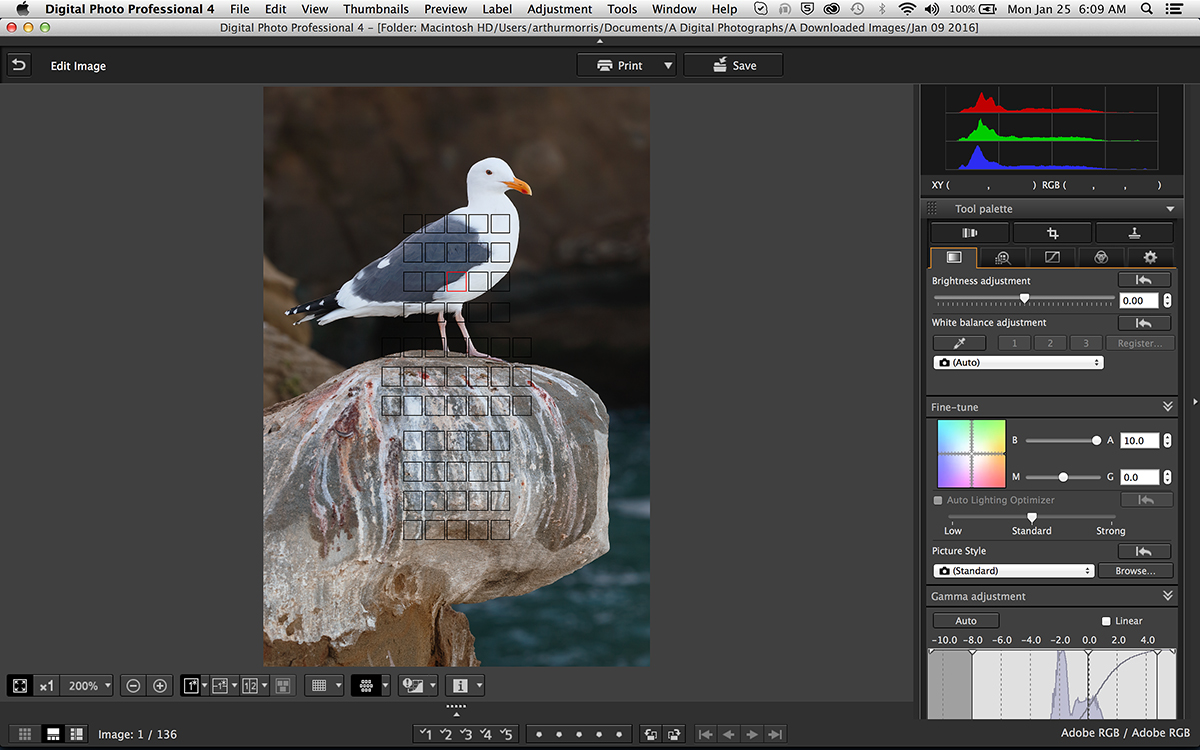
|
This is the DPP 4 screen capture for today’s featured image.
|
DPP 4 Color Balance Fine-Tune Tip
Captured with AWB, today’s featured image had a big blue color cast as expected as the subject and the whole scene were in the shade. Rather than trying Click White Balance or adjust the Color Temperature slider, I simply moved the B/A (Blue/Aqua) slider all the way to the right toward Aqua. This pretty much balanced the R, the G, and the B in the histogram and thus, the results were quite pleasing.
Note also the location of the carefully chosen AF point that is illuminated in red. Learning to move the AF point around quickly and efficiently will help you immeasurably to improve the design of your images.
|

|
|
You can order your copy of “The Photographers’ Guide to Canon Digital Photo Professional 4.0” (aka the DPP 4 Raw Conversion eGuide) by Arash Hazeghi and Arthur Morris by clicking here.
|
The DPP 4 eGuide (PDF)
Learn how and why I and many other discerning photographers choose and use only DPP 4 to convert their Canon RAW files in the DPP 4 RAW Conversion Guide by Arash Hazeghi and yours truly. The latest version supports all of the newer Canon camera bodies and several older models including the EOS-7D and the EOS-1D Mark IV. The DPP IV Guide is the ideal companion to the 7D Mark II User’s Guide, a runaway best seller.
The DPP 4 eGuide (PDF) Updated for 1D Mark IV and the original 7D
The DPP 4 eGuide was recently updated to include the luminance and chrominance noise reduction values for both the 1D Mark IV and the original 7D. If you purchased your copy from BAA please e-mail Jim and request the DPP 4 1D IV/7D update. Please be sure to cut and paste page 1 of the guide into your e-mail as proof of purchase.
2017 San Diego 4 1/2-DAY BIRDS AS ART Instructional Photo-Tour (IPT) JAN 11 thru and including the morning session on JAN 15: 4 1/2 days: $1999.
(Limit: 10/openings 8)
Meet and Greet at 7:00pm on the evening before the IPT begins; Tuesday 1/10/17.
Join me in San Diego to photograph the spectacular breeding plumage Brown Pelicans with their fire-engine red and olive green bill pouches; Brandt’s and Double-crested Cormorants; breeding plumage Wood and Ring-necked Duck; other duck species possible including Lesser Scaup, Redhead, and Surf Scoter; a variety of gulls including Western, California, and the gorgeous Heerman’s, all in full breeding plumage; shorebirds including Marbled Godwit, Willet, Sanderling and Black-bellied Plover; many others possible including Least, Western, and Spotted Sandpiper, Whimbrel, Black and Ruddy Turnstone, Semipalmated Plover, and Surfbird; Harbor Seals (depending on the current regulations) and California Sea Lions; and Bird of Paradise flowers. And as you can see by studying the two IPT cards there are some nice bird-scape and landscape opportunities as well.
With gorgeous subjects just sitting there waiting to have their pictures taken, photographing the pelicans on the cliffs is about as easy as nature photography gets. With the winds from the east almost every morning there is usually some excellent flight photography. And the pelicans are almost always doing something interesting: preening, scratching, bill pouch cleaning, or squabbling. And then there are those crazy head throws that are thought to be a form of intra-flock communication.
Did I mention that there are wealth of great birds and natural history subjects in San Diego in winter?
For complete 2017 San Diego ITP info please click here.
Please Remember to use our Affiliate Links 🙂
To show your appreciation for my continuing efforts here, we ask, as always, that you get in the habit of using my B&H affiliate links on the right side of the blog for all of your photo and electronics purchases. Please check the availability of all photographic accessories in the BIRDS AS ART Online Store, especially the Mongoose M3.6 tripod heads, Gitzo tripods, Wimberley heads and plates, LensCoats and accessories, and the like. We sell only what I have used, have tested, and can depend on. We will not sell you junk. We know what you need to make creating great images easy and fun. And we are always glad to answer your gear questions via e-mail. I just learned that my account was suspended during my absence; it should be up and running by Monday at the latest.
I would of course appreciate your using our B&H affiliate links for all of your major gear, video, and electronic purchases. For the photographic stuff mentioned in the paragraph above we, meaning BAA, would of course greatly appreciate your business. Here is a huge thank you to the many who have been using our links on a regular basis and visiting the BAA Online store as well.
Facebook
Be sure to like and follow BAA on Facebook by clicking on the logo link upper right. Tanks a stack!
Typos
In all blog posts and Bulletins, feel free to e-mail or to leave a comment regarding any typos or errors. Just be right 🙂
January 24th, 2016 What’s Up?
Scoff at Cold Thermogenesis and ice baths if you like, but the facts are that while I was in San Diego I was getting up every 45 minutes to an hour for a pit stop and sleeping–if you could even call it that–only five to six hours. Last night, after my fourth day in a cold pool–about 73 degrees, and after four 6pm ice baths, I slept eight full hours with just one pit stop.
I spent most of yesterday working on a South Georgia article for Nature Photographer magazine. After I finish that up this morning I will be doing some more work on my coming soon Southern Ocean Photography Guide and working a bit on the After-Conversion Photoshop Guide that I will be doing with Arash Hazeghi. (See more on that below.)
I am looking forward to the two NFL games today. I am hoping that Carolina wins but would be OK if the Cardinals beat them. I will be investing all of my rooting energy against the hated Patriots. Just why did Pretty Boy Tom Brady destroy his cell phone before being investigated by the league??? Go Peyton!

B&H
B&H was the primary exhibition sponsor of my solo, career retrospective, 67-image exhibit at the San Diego Natural History Museum. Thank them (and me, for the work I do on the blog) by clicking on the logo link above to shop for camera bodies and lenses.
|
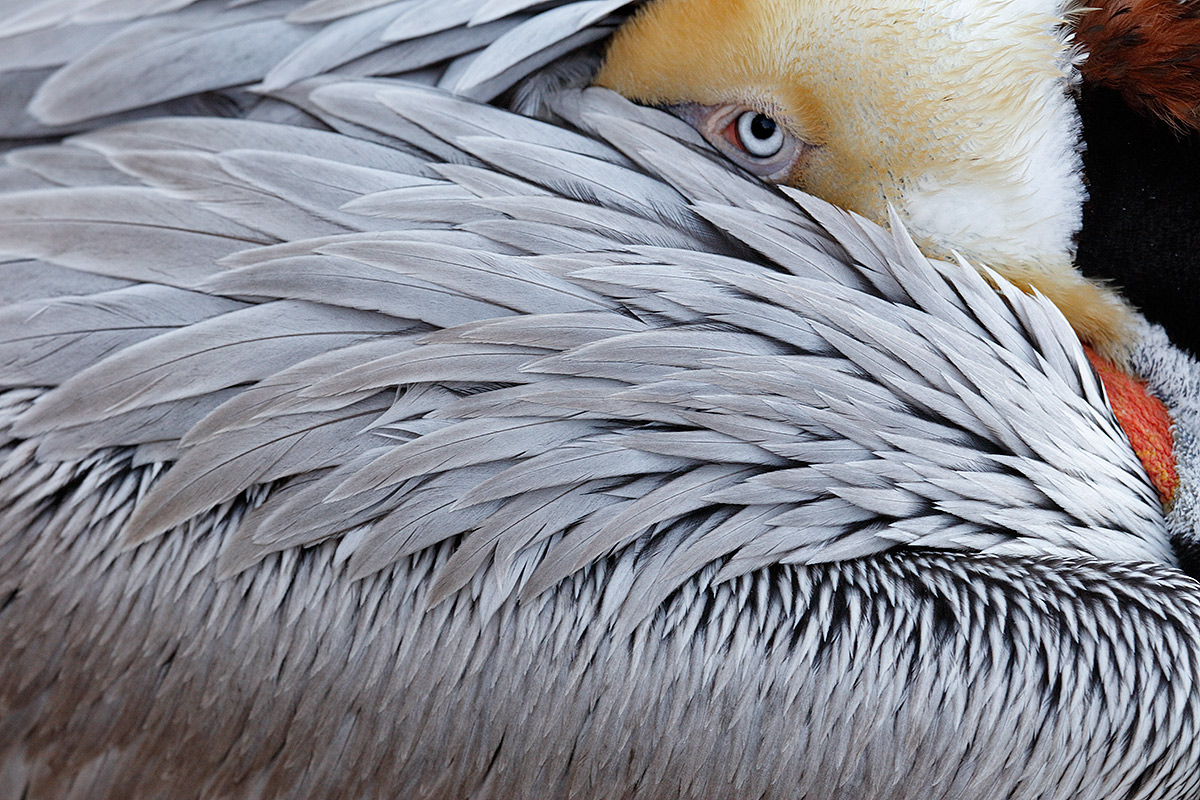
|
|
This image was created at La Jolla, CA with the Induro GIT 304L/Mongoose M3.6-mounted Canon EF 500mm f/4L IS II USM lens, the Canon Extender EF 1.4X III, and the Canon EOS 5DS R. ISO 1600. Evaluative metering +1/3 stop: 1/60 sec. at f/8. AWB. Should have been +1 stop…
Center AF point/AI Servo Expand/Rear Focus AF as framed was active at the moment of exposure. Click here to see the latest version of the Rear Focus Tutorial. Click on the image to see a larger version.
Brown Pelican scapulars viewed from overhead with eye visible
|
ISO 1600 5DS R Noise
Before scrolling down to look at the three tight crops below, consider the noise levels that you see at ISO 1600 in the image as presented above–please click on the image to view it larger if you wish. The only obvious noise that I am seeing is in the rather “mushy” area in the lower left corner. That “mushy” look may not be noise at all as that area is somewhat shadowed and thus a bit underexposed… Please leave a comment and let us know what you are seeing as far as noise in the image as presented above.
Full Frame
The challenge for me here while shooting almost straight down from above the pelican was to completely fill the frame with feathers while totally eliminating any evidence of the reddish cliff background in the corners. This image is full frame: I was able to get what I wanted.
Thanks Carlotta for Teaching an Old Dog a New Trick
I first met Carlotta Grenier on one of the 2015 Bosque IPTs. She had so much fun that she signed up for the San Diego IPT that turned out to be a blast. During the image critiquing session she shared one image that captivated me. She had shot straight down at the head and back of a sleeping pelican. Over the years I had done some similar stuff in the same general area but had not shot straight down as she had. So thanks Carlotta for opening my eyes.
Rather than rear focusing on the bird’s eye, I went with the active AF point on the scapulars as I wanted those feathers absolutely sharp. I figured that t f/8 that I had a chance of getting the eye sharp. I succeeded half way but a Contrast Mask rendered the eye more than sharp enough for me. With the eye somewhat in a shaded area I did some Eye Doctor work by making the pupil blacker and making the iris whiter, all via small Quick Masks followed by Curves on a Layer (Control + M). The Eye Doctor work really brought the image to life.
You say Car-LOT-uh…
At the beginning of the IPT I kept mispronouncing Carlotta’s name by saying Car-LOW-tah. Once she corrected me a few times (in good fun I might add), I had it down pat, Car-LOT-uh. The problem was that others had become confused. Folks who had gotten her name right at first were now calling her Car-LOW-tah and even Car-LEE-tah. Everyone, including Carlotta, had a good laugh. And a great time on the IPT.
|
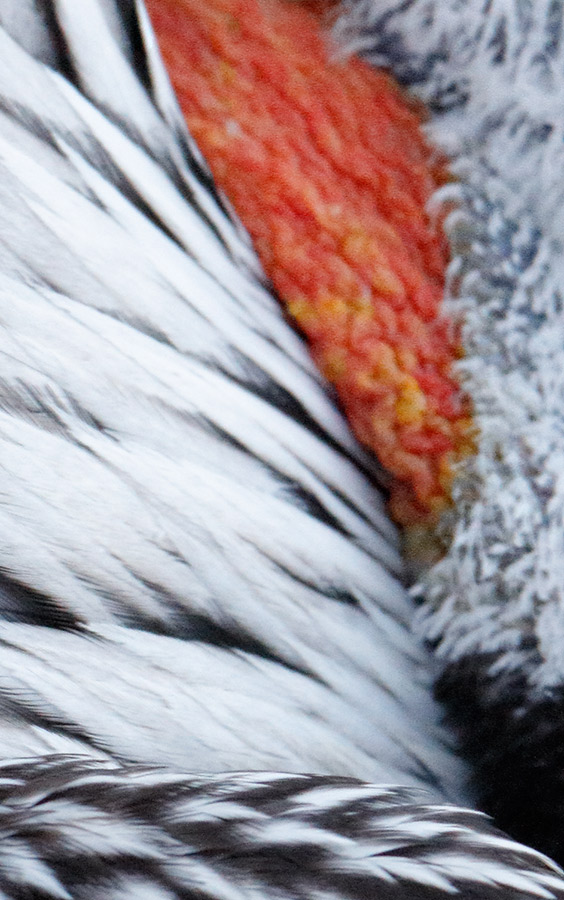
|
Tight crop #1: The unsharpened crop here approximates a 100% crop. It was downsized just a bit to 900 pixels tall. The 850kb file was optimized to < 395 kb and is presented here at 466 pixels wide.
|
|
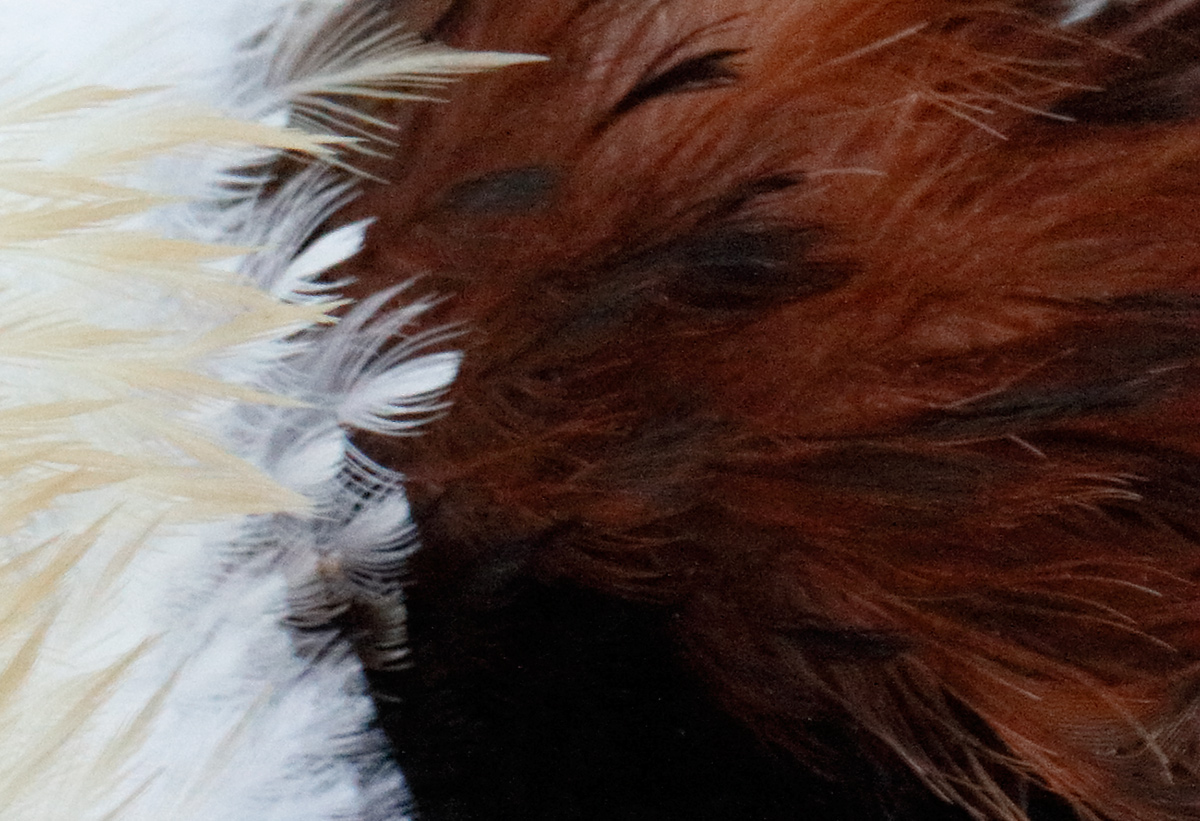
|
Tight crop #2: The unsharpened crop here approximates a 100% crop. That was cropped to 1200 pixels wide. The approximately 600 kb file was optimized to < 395 kb. It is presented here at 800 pixels wide.
|
|
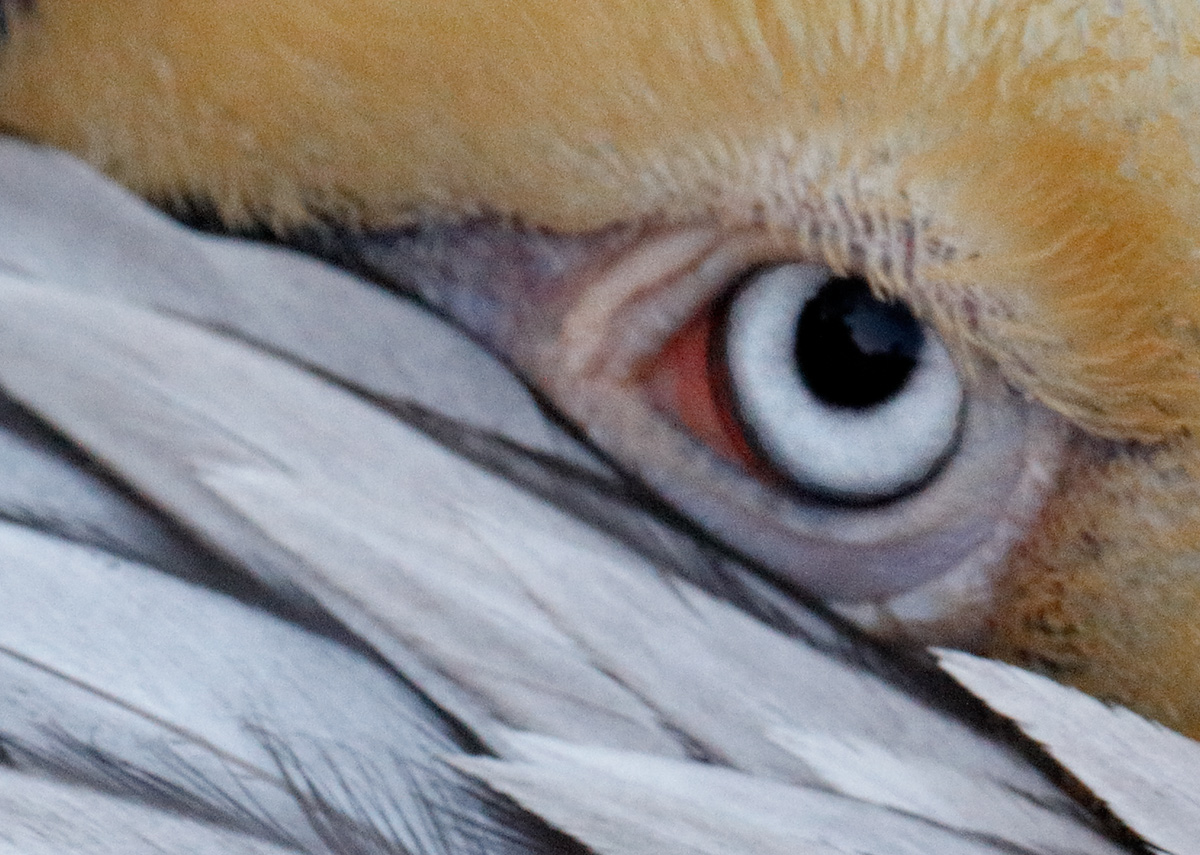
|
Tight crop #3: The unsharpened crop here also approximates a 100% crop. It was downsized just a bit to 1200 pixels wide. The 600kb file was optimized to < 395 kb and is presented here at 800 pixels wide.
|
First, My Comments on Noise
I must admit that since I began doing my conversions in DPP 4 and using the Chrominance and Luminance Noise Reduction Values developed by Arash Hazeghi as summarized on page 28 of the DPP 4 RAW Conversion Guide. Heck, I was never really concerned about noise even before I started using DPP. That may–in part–be due to the fact that I have long minimized noise by pushing my exposure far to the right in the field.
Right now I am editing Arash’s “After-Conversion Photoshop Guide” (my working title) and am learning a lot more about noise and about the Neat Image noise reduction plug-in. Arash recommends Neat Image Pro so that is what I installed on my MacBook Pro yesterday. I still have lots of work to do in that area so I will say succinctly that I am no expert in the noise department (even though I often peek at big enlargements of small areas of an image).
Fine Feather Detail, Image Quality, and Noise Questions
If and only if you are familiar with looking at 100% crops you are invited to comment on image quality, chrominance (color) noise, luminance noise, and on the fine feather detail that you are seeing in the three tight crops above.
2017 San Diego 4 1/2-DAY BIRDS AS ART Instructional Photo-Tour (IPT) JAN 11 thru and including the morning session on JAN 15: 4 1/2 days: $1999.
(Limit: 10/openings 8)
Meet and Greet at 7:00pm on the evening before the IPT begins; Tuesday 1/10/17.
Join me in San Diego to photograph the spectacular breeding plumage Brown Pelicans with their fire-engine red and olive green bill pouches; Brandt’s and Double-crested Cormorants; breeding plumage Wood and Ring-necked Duck; other duck species possible including Lesser Scaup, Redhead, and Surf Scoter; a variety of gulls including Western, California, and the gorgeous Heerman’s, all in full breeding plumage; shorebirds including Marbled Godwit, Willet, Sanderling and Black-bellied Plover; many others possible including Least, Western, and Spotted Sandpiper, Whimbrel, Black and Ruddy Turnstone, Semipalmated Plover, and Surfbird; Harbor Seals (depending on the current regulations) and California Sea Lions; and Bird of Paradise flowers. And as you can see by studying the two IPT cards there are some nice bird-scape and landscape opportunities as well.
With gorgeous subjects just sitting there waiting to have their pictures taken, photographing the pelicans on the cliffs is about as easy as nature photography gets. With the winds from the east almost every morning there is usually some excellent flight photography. And the pelicans are almost always doing something interesting: preening, scratching, bill pouch cleaning, or squabbling. And then there are those crazy head throws that are thought to be a form of intra-flock communication.
Did I mention that there are wealth of great birds and natural history subjects in San Diego in winter?
For complete 2017 San Diego ITP info please click here.
Please Remember to use our Affiliate Links 🙂
To show your appreciation for my continuing efforts here, we ask, as always, that you get in the habit of using my B&H affiliate links on the right side of the blog for all of your photo and electronics purchases. Please check the availability of all photographic accessories in the BIRDS AS ART Online Store, especially the Mongoose M3.6 tripod heads, Gitzo tripods, Wimberley heads and plates, LensCoats and accessories, and the like. We sell only what I have used, have tested, and can depend on. We will not sell you junk. We know what you need to make creating great images easy and fun. And we are always glad to answer your gear questions via e-mail. I just learned that my account was suspended during my absence; it should be up and running by Monday at the latest.
I would of course appreciate your using our B&H affiliate links for all of your major gear, video, and electronic purchases. For the photographic stuff mentioned in the paragraph above we, meaning BAA, would of course greatly appreciate your business. Here is a huge thank you to the many who have been using our links on a regular basis and visiting the BAA Online store as well.
Facebook
Be sure to like and follow BAA on Facebook by clicking on the logo link upper right. Tanks a stack!
Typos
In all blog posts and Bulletins, feel free to e-mail or to leave a comment regarding any typos or errors. Just be right 🙂
January 23rd, 2016 What’s Up?
After receiving several dire reports of “no birds at all at Bosque” from blog regular David Policansky last week, I scrapped my idea for a January 2017 Bosque IPT. Having had such a blast in San Diego and with the 2016 San Diego IPT having been such a huge success, I decided to put together another visit in January 2017. It is very possible that my 21-season streak at Bosque may come to an inglorious end…
I do hope that you can join me in San Diego next January for the pelicans and more. With my 30+ years experience photographing there it would be hard to find anyone who knows the birds, the locations, the tides, and the winds better than me.

B&H
B&H was the primary exhibition sponsor of my solo, career retrospective, 67-image exhibit at the San Diego Natural History Museum. Thank them (and me, for the work I do on the blog) by clicking on the logo link above to shop.
|

|
|
San Diego offers a wealth of very attractive natural history subjects. With annual visits spanning more than three decades I have lot of experience there….
|
2017 San Diego 4 1/2-DAY BIRDS AS ART Instructional Photo-Tour (IPT) JAN 11 thru and including the morning session on JAN 15: 4 1/2 days: $1999.
(Limit: 10/openings 8)
Meet and Greet at 7:00pm on the evening before the IPT begins; Tuesday 1/10/17.
Join me in San Diego to photograph the spectacular breeding plumage Brown Pelicans with their fire-engine red and olive green bill pouches; Brandt’s and Double-crested Cormorants; breeding plumage Wood and Ring-necked Duck; other duck species possible including Lesser Scaup, Redhead, and Surf Scoter; a variety of gulls including Western, California, and the gorgeous Heerman’s, all in full breeding plumage; shorebirds including Marbled Godwit, Willet, Sanderling and Black-bellied Plover; many others possible including Least, Western, and Spotted Sandpiper, Whimbrel, Black and Ruddy Turnstone, Semipalmated Plover, and Surfbird; Harbor Seals (depending on the current regulations) and California Sea Lions; and Bird of Paradise flowers. And as you can see by studying the two IPT cards there are some nice bird-scape and landscape opportunities as well.
With gorgeous subjects just sitting there waiting to have their pictures taken, photographing the pelicans on the cliffs is about as easy as nature photography gets. With the winds from the east almost every morning there is usually some excellent flight photography. And the pelicans are almost always doing something interesting: preening, scratching, bill pouch cleaning, or squabbling. And then there are those crazy head throws that are thought to be a form of intra-flock communication.
Did I mention that there are wealth of great birds and natural history subjects in San Diego in winter?
|

|
|
Though the pelicans will be the stars of the show on this IPT there will be many other handsome and captivating subjects in wonderful settings.
|
The San Diego Details
This IPT will include five 3 1/2 hour morning photo sessions, four 2 1/2 hour afternoon photo sessions, four lunches, and after-lunch image review and Photoshop sessions. To ensure early starts, breakfasts will be your responsibility.
A $599 non-refundable deposit is required to hold your slot for this IPT. You can send a check (made out to “Arthur Morris) to us at BIRDS AS ART, PO Box 7245, Indian Lake Estates, FL, 33855. Or call Jim or Jennifer at the office with a credit card at 863-692-0906. Your balance, payable only by check, will be due on 9/11//2016. If we do not receive your check for the balance on or before the due date we will try to fill your spot from the waiting list. Please print, complete, and sign the form that is linked to here and shoot it to us along with your deposit check. If you register by phone, please print, complete and sign the form as noted above and either mail it to us or e-mail the scan. If you have any questions, please feel free to contact me via e-mail.
Please Remember to use our Affiliate Links 🙂
To show your appreciation for my continuing efforts here, we ask, as always, that you get in the habit of using my B&H affiliate links on the right side of the blog for all of your photo and electronics purchases. Please check the availability of all photographic accessories in the BIRDS AS ART Online Store, especially the Mongoose M3.6 tripod heads, Gitzo tripods, Wimberley heads and plates, LensCoats and accessories, and the like. We sell only what I have used, have tested, and can depend on. We will not sell you junk. We know what you need to make creating great images easy and fun. And we are always glad to answer your gear questions via e-mail. I just learned that my account was suspended during my absence; it should be up and running by Monday at the latest.
I would of course appreciate your using our B&H affiliate links for all of your major gear, video, and electronic purchases. For the photographic stuff mentioned in the paragraph above we, meaning BAA, would of course greatly appreciate your business. Here is a huge thank you to the many who have been using our links on a regular basis and visiting the BAA Online store as well.
Facebook
Be sure to like and follow BAA on Facebook by clicking on the logo link upper right. Tanks a stack!
Typos
In all blog posts and Bulletins, feel free to e-mail or to leave a comment regarding any typos or errors. Just be right 🙂
January 22nd, 2016

B&H
B&H was the primary exhibition sponsor of my solo, career retrospective 67-image exhibit. Thank them (and me, for the work I do on the blog) by clicking on the logo link above to shop.
What’s Up with Used Gear Info Requests?
I spent a good part of this past week catching up on Used Gear-related e-mails. I think that I am pretty much caught up now. If I missed yours, please shoot me an e-mail reminding me of what I missed, and do include a copy of your original e-mail.
Selling Your Used Gear Through BIRDS AS ART
Selling your used (or like-new) photo gear through the BAA Blog or via a BAA Online Bulletin is a great idea. We charge only a 5% commission. One of the more popular used gear for sale sites charges a minimum of 20%. Plus assorted fees! Yikes. The minimum item price here is $500 (or less for a $25 fee). If you are interested please e-mail with the words Items for Sale Info Request cut and pasted into the Subject line :). Stuff that is priced fairly–I offer free pricing advice, usually sells in no time flat. In the past few months, we have sold just about everything in sight. Do know that prices on some items like the EOS-1D Mark IV, the old Canon 500mm, the EOS-7D, and the original 400mm IS DO lens have been dropping steadily. Even the prices on the new 600 II and the 200-400 with Internal Extender have been plummeting. You can see all current listings by clicking here or by clicking on the Used Photo Gear tab on the right side of the yellow-orange menu bar above.
Douglas Bolt sold his Tamron SP 150-600mm f/5-6.3 Di VC USD Zoom lens for Canon in like-new condition for $699, Diane Miller sold her 300mm f/2.8L IS lens, the old three, for $2899, and Roberta Olenick sold her Canon EOS-1D Mark IV camera body in excellent condition for $1279 USD, all within the last week. I learned on Wednesday that the sale of IPT veteran Brent Bridges’ 300mm f/2.8L IS lens for $4599 is pending. And I learned today that the sale of Mark Hodsgon’s 70-200mm f/4L IS lens became pending on the day that it was listed.
Crazy Multiple Price Reductions
Canon EF 24-70mm f/2.8L II USM Lens
Another Lowest-ever-by-a-mile BAA Price!
Price Reduced another $150 on January 22, 2106.
Erik Hagstrom is offering a used Canon EF 24-70mm f/2.8L II USM lens in excellent condition for a ridiculous $1275. The sale includes the lens hood (EW-88C), the front and rear Canon lens caps, the original lens case LP1219, the instruction manual, both US & Canada warranty cards, the original box (less the UPC code that was used for a rebate), and insured shipping via FED-EX Ground. Your item will not ship until your check clears unless other arrangements are made.
Please contact Erik by e-mail or by phone at 206-999-1507 (Pacific time).
The new 24-70 II is a favorite of all serious landscape photographers. It is currently selling new for $1799. artie
More New Listings!
Canon 500mm f/4L IS USM Lens
Bill Condon is offering a Canon 500mm f/4L IS USM lens in like-new, near-mint condition for $4199. There are no scratches, chips, or other signs of wear. The date code is UX1133 and the Serial Number is 37206. The sale includes the lens trunk with keys, the manual, the original lens cover and hood, an AquaTech ASHM Soft Hood, an AquaTech Lens Cover, a Wimberly P-40 Lens Plate, and insured shipping via UPS Ground. Your item will not ship until your check clears unless other arrangements are made.
Please contact Bill by e-mail or call him at 401.524.2454 (Eastern time).
The 500 f/4s have been the world’s most popular telephoto lenses for birds, nature, wildlife, and sports for many decades. I owned and used and loved my “old five” for many years. We have sold more than a few recently for $3999 and even two for $3799. Bill’s lens is priced a bit higher as it is in pristine condition. If you don’t have the cash for the 500 II and can handle the additional 1 1/2 pounds (exactly) then this is your next best option. The 500 II goes for $8999 so you will be saving a cool $4,800 and getting a virtually brand new lens to boot. artie
Canon EOS 7D Camera Body
Robert Doster is offering a used Canon EOS 7D body in excellent condition for $469. The camera shows little wear and both LCDs have been protected by screen protectors since purchase and are thus pristine. The camera has a shutter count of 13,902 actuations. The sale includes a Really Right Stuff B7D-L B L-plate, the original product box, manuals (English and Spanish), CDs, the wide neck strap, Eyecup Eg, body cap, LP-E6 battery, LC-E6 battery charger, AV and USB cables, and insured ground shipping via FedEx. Your item will not ship until your check clears unless other arrangements are made.
Please contact Robert by e-mail or by phone at 505-270-7361 (Pacific time).
Canon 7D Mark II Camera Body
Gregg J. Hunt is offering a used 7D Mark II camera body (< 5,100 shutter count) in near-mint condition (except for a few tiny subtle scuffs/abrasions on the body and not on the 2 LCD screens) for $999. The sale includes a LP-E6 rechargeable battery pack and cover, the LC-E6E battery charger, USB cable, audio/video cable (packaged and unused), the neck strap (packaged and unused), various documents/manuals/CD (packaged and unused), Michael Andrew's 4.5-hour-long Canon 7D II and Photography School Training Video, Bert Sirkin's 7D II Cheat Sheet, packing/retail box, and insured ground shipping to a U.S. address only via a major courier. Your item will not ship until check clears, unless other arrangements are made.
Please contact Gregg by e-mail.
I loved my 7D II from the get-go when I used it in sunny conditions. I have been saying for a while that it is the best value ever in a digital camera. As it is currently selling new at B&H for $1499 Gregg’s camera is a great buy. artie
Nikon D600 DSLR Camera Body
Saul Pleeter is offering a used Nikon D600 DSLR camera body in near-new condition (but for a scratch on the rear protective LCD cover–otherwise perfect and unblemished) for $650. The sale includes the battery, the charger, the body cap, the camera strap, the original box, and insured ground shipping via UPS.
Please contact Saul via e-mail.
Sony Alpha a7R Mirrorless Digital Camera
Saul Pleeter is also offering a used Sony Alpha a7R Mirrorless Digital Camera in near-new condition (but for a tiny surface scratch on a bottom corner–otherwise perfect and unblemished) for an incredibly low $799. The sale includes the battery, the body cap, the camera strap, the original product box, and insured ground shipping via UPS. This body sells new at B&H for $1898…
Please contact Saul via e-mail.
Truly Great Stuff for Sale Cheap!
Canon EF 200-400mm f/4L IS Lens with Internal 1.4 Extender
Friend and multiple-IPT veteran Phil Frigon is offering a used Canon EF 200-400mm f/4L IS lens with Internal Extender in excellent condition for the record-low BAA price of $8995. The sale includes the lens trunk, the original leather front lens cover, a RRS lens foot (installed), the original Canon foot with all the screws, and insured ground shipping via UPS to US addresses only. Your item will not ship until your check clears unless other arrangements are made.
Please contact Phil via e-mail.
This is the world’s best lens for a trip to Africa. It kills also in the Galapagos and in South Georgia, the Falklands, and Antarctica. And I use mine a lot at Bosque and other dusty places where the built-in TC helps to keep your sensor clean. The lens sells new at B&H right now for $10,999. You can save $2004 by grabbing Phil’s lens. artie
Canon EF 400mm f/2.8L IS II USM Lens
Friend and multiple-IPT veteran Phil Frigon is also offering a used Canon EF 400mm f/2.8L IS II lens in excellent condition for the record-low-by-far BAA price of $7800. The sale includes the lens trunk, the original leather front lens cover, a RRS lens foot (installed), the original Canon foot with all the screws, and insured ground shipping via UPS to US addresses only. Your item will not ship until your check clears unless other arrangements are made.
Please contact Phil via e-mail.
This lens sells new for $9,999 so Phil’s is priced to sell and save you $2,199. If you do sports or large mammals this is the lens for you. I do know of a few competent photographers who do great on birds with this lens; it kills with either the 1.4X or the 2X III TC. artie
Canon EF 600mm f/4L IS II Lens
Donald Mullaney is offering his Canon EF 600mm f/4L IS II lens in mint condition for the record-low BAA price of $9499. The sale includes an AquaTech Soft Cap, a black LensCoat, a Kirk lens plate, the lens trunk and the original leather front lens cover, the lens strap, and insured ground shipping to US addresses only. This lens was purchased on Bought 2/24/14 and used less then a dozen times. Your item will not ship until your check clears unless other arrangements are made.
Please contact Don via e-mail.
The 600 II is the world’s premier super-telephoto lens. It is super-sharp and features Canon’s amazing four-stop Image Stabilization system. This, the current version, weighs more than 3 pounds less than the previous model. When I am not weight-restricted, the 600 II is my first choice in super-telephoto lenses. I use it at Bosque, at Nickerson Beach, and from my car on a BLUBB when working down by the lake near my house. When you need maximum reach, the 600 II is the only way to go. As the lens currently sells new at B&H for $11,499, you can save $2,000 by grabbing Don’s lens right now. artie
Canon 800mm f/5.6L IS USM Lens
Andres Leon is offering a used Canon 800mm f/5.6L IS lens in Very Good Plus condition for the very low price of $7899. The lens has clean glass and is in perfect working order but has a few scratches on the finish. Feel free to request photos of the lens. The sale includes the lens trunk and keys, a LensCoat, the front leather cover, the rear cap, a Wimberley P-40 lens plate, and insured ground shipping via FED-EX Ground. Your item will not ship until your check clears unless other arrangements are made. Please contact Andres via e-mail or by phone at 1-954-621-6678 (eastern time).
I used this lens, often with a 1.4X TC, as my main super-telephoto lens for close to five years. It is a superb lens that offers lots of reach for those working with birds that are skittish. It is great from the car. I was astounded that about 15 of the 67 images in the exhibit were created with my 800. I often miss it terribly. As the lens sell new at B&H for $12,999 Andres’s lens is a superb buy; grab it now and save more than $5K! artie
Please Remember to use our Affiliate Links 🙂
To show your appreciation for my continuing efforts here, we ask, as always, that you get in the habit of using my B&H affiliate links on the right side of the blog for all of your photo and electronics purchases. Please check the availability of all photographic accessories in the BIRDS AS ART Online Store, especially the Mongoose M3.6 tripod heads, Gitzo tripods, Wimberley heads and plates, LensCoats and accessories, and the like. We sell only what I have used, have tested, and can depend on. We will not sell you junk. We know what you need to make creating great images easy and fun. And we are always glad to answer your gear questions via e-mail. I just learned that my account was suspended during my absence; it should be up and running by Monday at the latest.
I would of course appreciate your using our B&H affiliate links for all of your major gear, video, and electronic purchases. For the photographic stuff mentioned in the paragraph above we, meaning BAA, would of course greatly appreciate your business. Here is a huge thank you to the many who have been using our links on a regular basis and visiting the BAA Online store as well.
Facebook
Be sure to like and follow BAA on Facebook by clicking on the logo link upper right. Tanks a stack!
Typos
In all blog posts and Bulletins, feel free to e-mail or to leave a comment regarding any typos or errors. Just be right 🙂
January 22nd, 2016 What’s Up?
In addition to the usual work we enjoyed a bit of a homeowner’s challenge here yesterday. Early in the morning Jim let me know that the well pump in the garage was making strange sounds. Soon thereafter we had no water so we killed the circuit breaker and called Spivey Well Drilling in Lake Wales. They were here right after 1pm and spent more than two hours trying to repair the very old pump. When push came to shove, they let me know that they had installed a used pump that could be mine for $450 including the labor. Or opt for a new pump to be installed on Monday or Tuesday for $800-$1000. I went for the new pump. Aside from being unable to use the toilets, it is funny how many times we rely on running water without realizing it…
BIRDS AS ART BULLETIN #480
BIRDS AS ART BULLETIN #480 is online and can be accessed here.
- Your Very Last Chance to join the 2017 Bear Boat Coastal Brown Bear Cubs IPTs
- The Blog is the Bomb!
- Used Photo Gear Sales Hot!
- My latest e-book birds as art: The Avian Photography of Arthur Morris/The Top 100
- Your Help Needed and Appreciated/Affiliate Stuff
The 2017 Bear Boat Coastal Brown Bear Cubs IPTs
If you are interested in either of the 2017 Bear Boat Coastal Brown Bear Cubs IPTs I urge you to give item one in the Bulletins above a careful read.
|

|
birds as art: The Avian Photography of Arthur Morris/The Top 100
The companion e-book to the solo exhibit at TheNat, San Diego, California
The new e-book on CD is available for $23 here. And it is also available via convenient download for $20 by clicking here.
|
birds as art: The Avian Photography of Arthur Morris/The Top 100
If you missed the announcement of the new e-book click here for complete info that includes details on getting a signed copy.
From Multiple IPT Veteran Stephen Leimberg
Art, this is the most beautiful book on bird photography I’ve ever seen! What an inspiration! A visual feast! Bravo! Warmest, Steve
From Mike Moore
The top 100 collection is almost too overwhelming to absorb at once. I will be looking at it many, many times to be able to drink it all in. I will say I never really appreciated blurs, but Cottonwood Morning Wave is one of my favorite images. The colors and the composition are superb. There is a real feeling of being present at a live event that a sharp photo would not have conveyed, so maybe you won me over. You give a 100 great examples of something for us to strive for. I especially appreciated that you annotated every image to get a sense of what it took to capture it. Brilliant. Congratulations and thanks for sharing and making it so affordable to own this collection of some of the world’s greatest bird images.
From IPT Veteran Larry Master
I just downloaded your new collection of 100 images! Wow! I’ve seen many before in your posts but to view as one collection it is amazing. Larry
Additional Feedback Requested
If you ordered via download or have already received your CD, I would love to hear what you think. Please do leave a comment or shoot me an e-mail.

B&H
B&H was the primary exhibition sponsor. Thank them (and me, for the work I do on the blog) by clicking on the logo link above to shop.
|
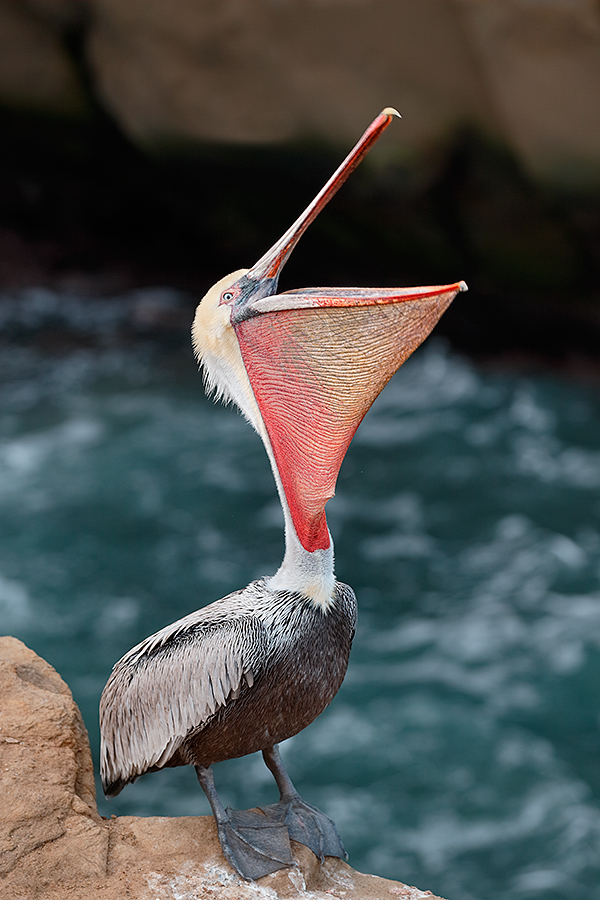
|
|
This image was created at La Jolla, CA with the hand held Canon EF 100-400mm f/4.5-5.6L IS II USM lens (at 234mm) and the rugged Canon EOS-1D X. ISO 400. Evaluative metering at zero: 1/320 sec. at f/6.3.
A single AF point that was three AF points up and one to the left of the center AF point (Manual selection)/AI Servo/Rear Focus AF as framed was active at the moment of exposure (as is always best when hand holding). I should have been in Surround or at least Expand… Click here to see the latest version of the Rear Focus Tutorial. Click on the image to see a larger version.
Brown Pelican head throw
|
The Elusive Head Throw Image…
I tried and tried to create a really good head throw image on the IPT. I taught others what to look for and how best to succeed. I had one really good chance and choked by failing to zoom out wide enough and cut off the tip of the bill. Don’t you hate when that happens? On my last Friday, the day before the exhibit opened, I was shooting at the cliffs with some friends. It was late in the morning and most of the pelicans had left so I made my way out to the end of the rocks and was able to shoot down on a few birds on a lower shelf. I like this one a lot. The key factor here is the fact that it was cloudy; had the sun been out this image would have been horribly side-lit.
An instant after I made this image a pelican photo-bombed the sequence by flying right through the frame in front of the subject; six good frames were ruined. Just think: with the 5DS R only three frames would have been lost. 🙂
Soon I will post an image showing how I wound up with a single AF point that was three AF points up and one to the left of the center AF point (Manual selection) and explaining why I was so lucky here and why Surround or at least Expand would likely have been better in this situation.
|
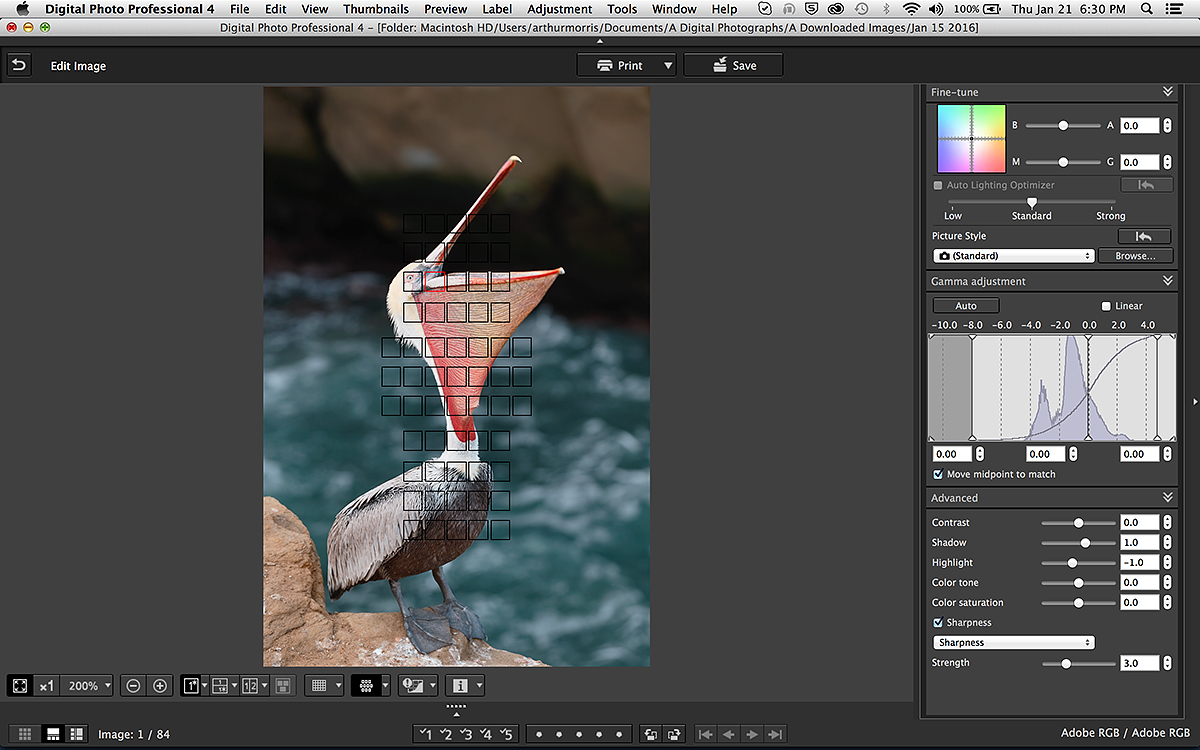
|
The DDP 4 Screen Capture
|
The DDP 4 Screen Capture
Above, you have to strain your eyes a bit to see the active AF point that is illuminated in read. It is just forward of the eye. You might think me clairvoyant to have selected that single AF point but that was not the case. The explanation will follow in a blog post in a day or two.
It’s funny that with subjects with black and right white how often I wind up with the the Shadow slider set one to the right and the Highlight slider at -1. I do not hesitate to use higher values but for many such images I wind up as shown here.
|
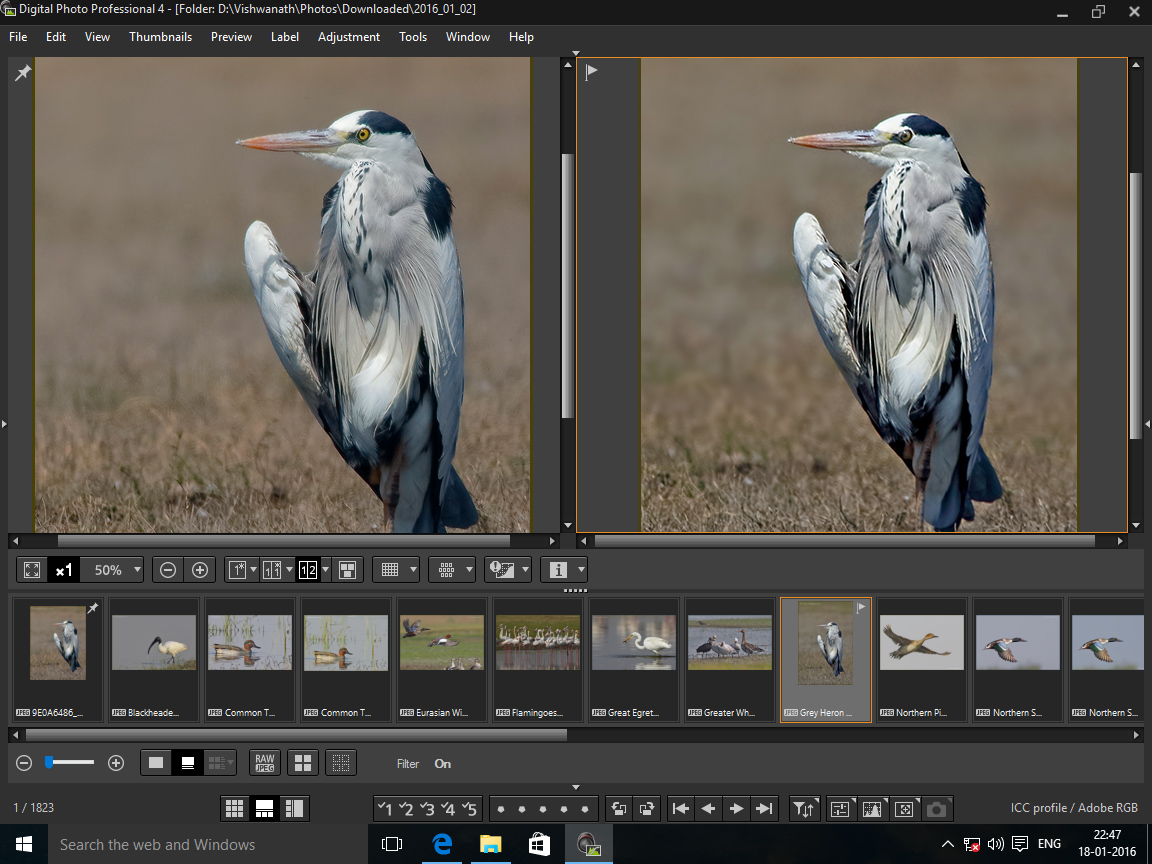
|
Another DDP 4 Screen Capture
Courtesy of and Copyright 2016: Vishwanath Bhagwat
|
DPP 4 RAW Conversion Guide Kudos
Via e-mail from Vishwanath Bhagwat
Hi to Artie, Arash and the BAA team.
I had no problems in downloading the DPP 4 guide from the Hightail link in the e-mail.
I couldn’t wait to read it & was immediately able to apply what I was learning as I was using DPP 4 for the first time. My original attempt is on the right & the improved image on the left. Both are JPEG’s – processed, downsized for web & sharpened. I can’t believe the mess I made of the first one that was done before I got the guide. The culprits were “Auto Lighting Optimizer” checked on and using “Unsharp Mask” instead of “Sharpness.”
Thanks a lot for the well written guide. Regards, Vishwanath.
Comments and a question for Vishwanath
Vish-bhai, The improved version looks great. It looks as if you toned down the lights nicely with the Highlight slider (and brought the shadows up a bit as well). What other improvements did you note when you enlarged the view?
Lastly, it sure looks as if you did some Eye Doctor work on this image. Is that correct?
|

|
|
You can order your copy of “The Photographers’ Guide to Canon Digital Photo Professional 4.0” (aka the DPP 4 Raw Conversion eGuide) by Arash Hazeghi and Arthur Morris by clicking here.
|
The DPP 4 eGuide (PDF)
Learn how and why I and many other discerning photographers choose and use only DPP 4 to convert their Canon RAW files in the DPP 4 RAW Conversion Guide by Arash Hazeghi and yours truly. The latest version supports all of the newer Canon camera bodies and several older models including the EOS-7D and the EOS-1D Mark IV. The DPP IV Guide is the ideal companion to the 7D Mark II User’s Guide, a runaway best seller.
The DPP 4 eGuide (PDF) Updated for 1D Mark IV and the original 7D
The DPP 4 eGuide was recently updated to include the luminance and chrominance noise reduction values for both the 1D Mark IV and the original 7D. If you purchased your copy from BAA please e-mail Jim and request the DPP 4 1D IV/7D update. Please be sure to cut and paste page 1 of the guide into your e-mail as proof of purchase.
Please Remember to use our Affiliate Links 🙂
To show your appreciation for my continuing efforts here, we ask, as always, that you get in the habit of using my B&H affiliate links on the right side of the blog for all of your photo and electronics purchases. Please check the availability of all photographic accessories in the BIRDS AS ART Online Store, especially the Mongoose M3.6 tripod heads, Gitzo tripods, Wimberley heads and plates, LensCoats and accessories, and the like. We sell only what I have used, have tested, and can depend on. We will not sell you junk. We know what you need to make creating great images easy and fun. And we are always glad to answer your gear questions via e-mail. I just learned that my account was suspended during my absence; it should be up and running by Monday at the latest.
I would of course appreciate your using our B&H affiliate links for all of your major gear, video, and electronic purchases. For the photographic stuff mentioned in the paragraph above we, meaning BAA, would of course greatly appreciate your business. Here is a huge thank you to the many who have been using our links on a regular basis and visiting the BAA Online store as well.
Facebook
Be sure to like and follow BAA on Facebook by clicking on the logo link upper right. Tanks a stack!
Typos
In all blog posts and Bulletins, feel free to e-mail or to leave a comment regarding any typos or errors. Just be right 🙂
January 21st, 2016 What’s Up?
Yesterday I answered more than 140 e-mails, many dealing with Used Photo Gear stuff; the Used Gear page here has really been hopping. I did, however, have time for a chilly swim–the pool was down to 71 degrees yesterday, some core exercises, and an ice bath.
If…
If what you read below inspires you to purchase a Canon EOS 5DS R I would of course greatly appreciate your using my B&H affiliate link for your purchase; it won’t cost you a penny more and is the best way to thank me for the work that I put into the blog every day. This blog post took well more than four hours to assemble.
The Streak
In spite of having been buried by travel, teaching, the exhibit, and several major writing projects for the last two months, today’s blog post marks 79 days in a row with a new educational blog post. Again, please remember to use our B&H links for your major gear purchases. Your doing so is always greatly appreciated. 🙂
|
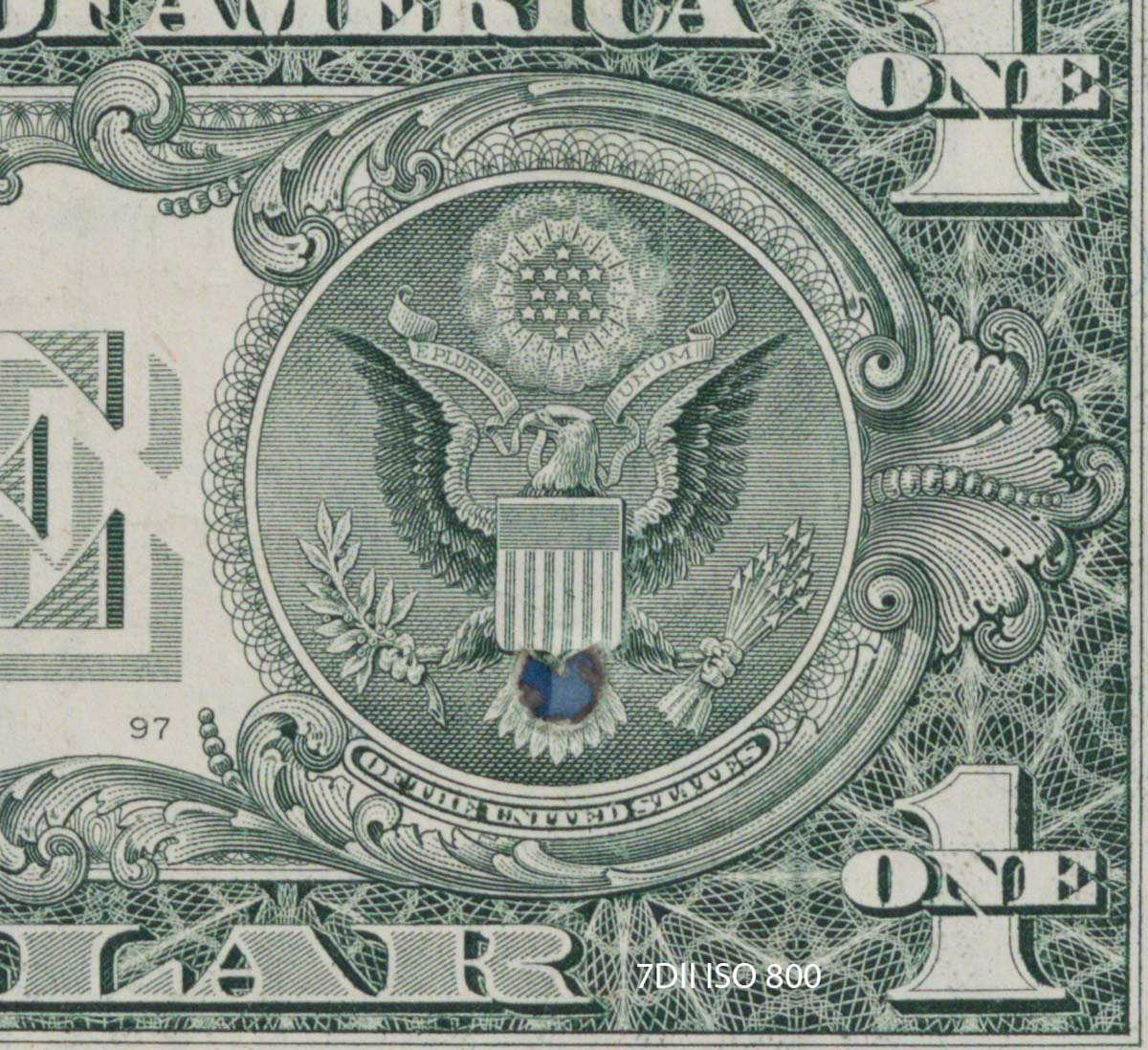
|
Canon 7D Mark II sharpness test image courtesy of and copyright Patrick Sparkman
|
Bill Lloyd Was Right: Canon EOS 5DS R versus EOS 7D Mark II
With regard to the side by side comparison image in yesterday morning’s blog post here, the left hand image–see the JPEG above–was made under stringent testing condition by good friend Patrick Sparkman with the Canon EOS 7D Mark II. The right hand image–see the JPEG below–was of course also made under stringent testing condition by good friend Patrick Sparkman with the Canon EOS 5DS R.
Here is Bill Lloyd’s comment on the original post: 5DS R on the right, 7DII on the left, betcha.
Kudos to Bill. 🙂
|
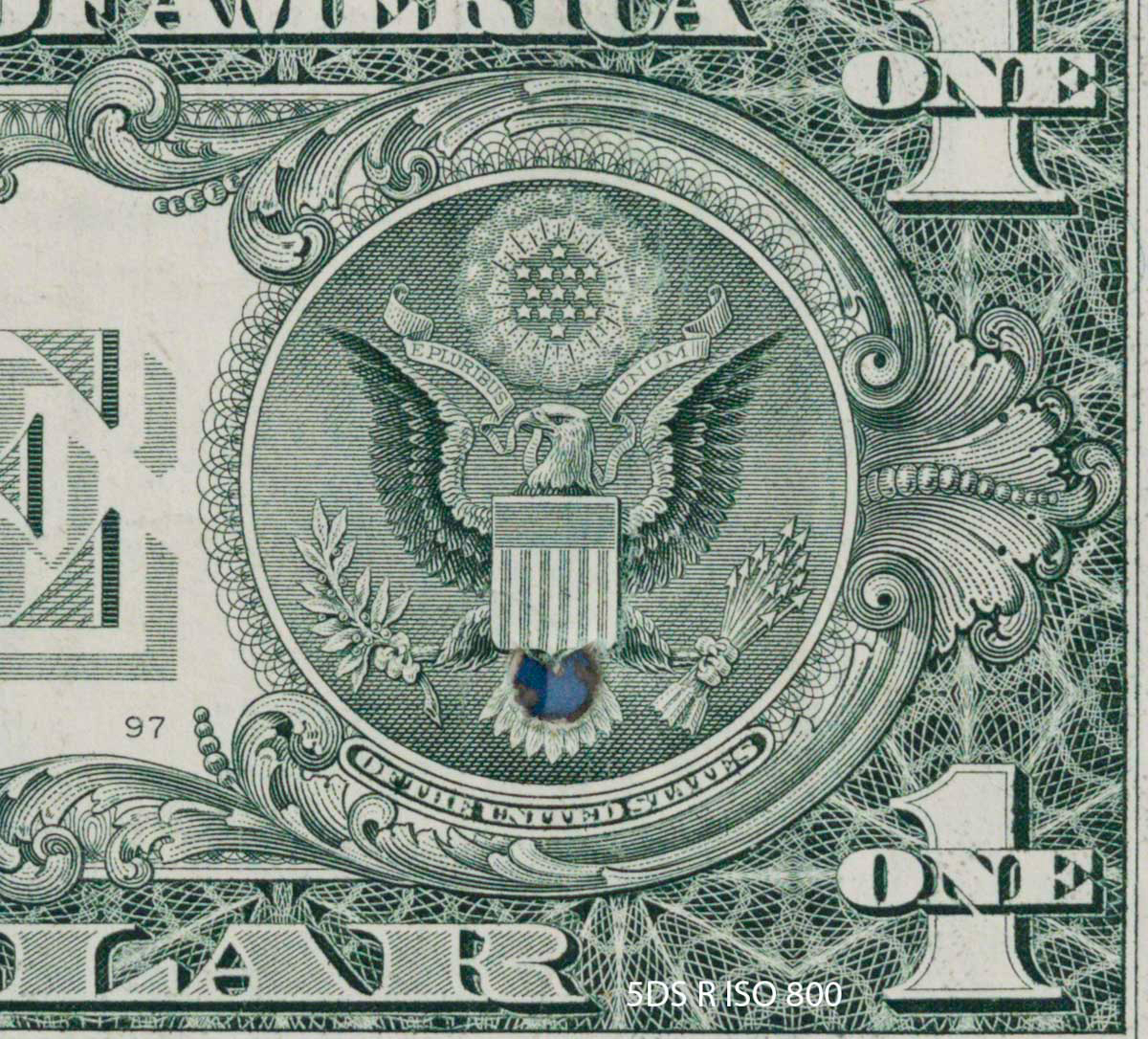
|
Canon EOS 5DS R sharpness test image courtesy of and copyright Patrick Sparkman
|
The Results
Nearly all who commented felt that the right hand image was dramatically better on all counts.
These two comments summed up the consensus:
Lance Krueger: In answer to your five questions, the image on the right is dramatically better.
Jim Amato: Right photograph: Sharper, cleaner, higher degree of pleasing contrast, best image quality. Dramatic difference: Much sharper, tonal differences, more contrast with all tones. Letter E shadow and “lace” work more defined and pronounced. That is my 100 cents worth.
Patrick and I agree, but only 100%.
Patrick’s Testing Protocol
The camera body test was set up as follows: Tripod-mounted Canon 600 f/4L IS II, Mongoose Head locked down.
I clamped the dollar bill target to the Michael Tapes Lens Align calibration set-up mounted on a sturdy on a tripod to ensure True Parallel alignment.
The target was illuminated by ambient indoor light and was approximately 30 feet from the lens.
The lens had Image Stabilization and autofocus turned off. WB was set to 4200K. The lens was focused manually using Live View at the highest magnification, and was refocused for each camera body but was not moved otherwise. The images were created using manual exposure. Large RAW, 10-second with mirror lockup.
The images were processed in DPP 4, and all the of the settings were left at zero except for setting Sharpness at 3, and checking the boxes for Peripheral Illumination and Chromatic Aberration correction.
Each image was then similarly cropped to a 1200 pixel square; this approximated a 100% crop that was easily duplicated for each image. After the identical RAW conversions in DDP 4 the TIFFs were imported into Lightroom where I used the export utility to create a JPEG. No sharpening was applied; file sizes were limited to < 300kb.
Patrick’s Initial Reaction
After completing the test Patrick called my cell and said, “The results are amazing. The 7D II images look as if they were photographed through a fog filter when compared to the 5DS R images. The big thing is the improved contrast but the sharpness differences are astounding as well.
Simplifying Things
Let’s say that I am standing right next to you with the same lens photographing the same bird at the same distance and that our sharpness techniques are equal. I am using a 5DS R and you are using a 7D II. Your bird will of course be larger in the frame. But when I crop my image so that the bird is the same size in the frame as your bird, my image will be sharper with more pleasing contrast and be of overall higher quality. And those differences will be just as dramatic as they were in Patrick’s tests.
I am pretty sure that this statement is correct: the two images–your original and my cropped to the same subject size–will have virtually the same pixel dimensions. Please feel free to correct me if my understanding here is not correct.
Patrick pointed out the following: in the situation above if the bird flaps the guy (or gal) with the 7D II will clip the wings while the person with the 5DS R will get the shot.
More Thoughts From Patrick via e-mail
In my opinion, while the image quality of the 5DS R is certainly a bonus over the 7DII, the great advantage for my photography comes from the ability to have the equivalent of a 1.6 ratio zoom on the l600 II (or any lens) as compared to the 7DII. When I use the 600 with a 1.4 teleconverter, I will have an 840-1344 zoom versus the 7DII where I have only 1344. This will in fact greatly aid flight shooting; I can work with the 600 alone, be able to acquire AF on the subject easier due to the full frame view at 600mm, and then crop down to the equivalent 960mm of the 7DII (or to any effective focal length in between 960 and 600. All that while getting better image quality than we have ever had before. And when I can get closer to the birds image quality will be off the charts.
Thanks for loaning me the camera for the test.
My Original Gut Feelings
Right from the get-go I was floored by the quality of the 5DS R images. I have long claimed not to have a great eye for fine detail and that remains the case. But when I looked at the 5DS R images I knew that they were sharper, that they offered far more fine detail, and that the image quality was far superior to anything I had ever seen before. I did not, however, realize that the increase in pleasing contrast was a huge contributing factor (even though in retrospect that seems to be obvious).
In short, I was extremely gratified that the results of Patrick’s test confirmed my gut feelings.
The Big Question is Why?
So why are the 5DS R images so much better than the 7D II images? As far as I can figure, there several possibilities:
1-the softness and low contrast look of the 7D II images might be due to the low pass anti-aliasing filter that is immediately in front of the sensor. The converse with the 5DS R might be that the cancellation of the low-pass filter effect allows for sharper, higher quality image files with greater fine detail.
2-it is possible that the sensor (and thus the quality of the pixels) on the 5DS and the 5DS R cameras is much better than on the 7D II.
3-some combination of 1 and 2.
The bummer is that a friend in San Diego had a 5DS that could have been loaned to Patrick for the tests…
From Rudy Winston
I asked Rudy Winston, one of Canon USA’s most knowledgeable technical folks, why the 5DS R images were so superior to the 7D II images. He had lots of interest to say:
Assuming when you say “images were cropped to the same size on the dollar bill,” you mean that the same (or virtually the same) number of actual pixels were used to record both files, I’m not stunned by what you see here.
The absence of a low-pass filter will indeed give a somewhat sharper initial result, out of the camera. There are other things I don’t know about these files (in-camera JPEGs? If RAW files, how processed? etc.), but again, assuming equivalent handling, right off the bat, that’ll give a 5DS R file an edge in terms of how crisply it renders fine detail.
To some degree, that difference can be minimized for an EOS 5DS, EOS 7D Mark II, or other camera body shooters by using sharpening like Unsharp Mask to counter the impact of the softening from the low-pass filter immediately in front of the sensor on those cameras (and nearly all others in our line).
Here is another equalizer that–to some degree–many folks by-pass: the Digital Lens Optimizer feature that can be accessed when RAW images from a recent EOS camera and a compatible (i.e., recently-introduced) lens are processed in Canon’s DPP software. Digital Lens Optimizer is an optional form of “smart sharpening” (my choice of words, not Canon’s), that applies specific sharpening based on lens parameters for each individual image. When truly minute detail is needed/desired, it’s an interesting tool to try on a Canon RAW file.
Finally, in at least some situations, the mechanics of the 5DS series are designed to minimize the impact of mirror shock, and so on — which can contribute to slight changes in image quality when viewed extremely critically. I know you said that these were shot with mirrors locked-up and so on, which probably neutralized most if not all differences between the architecture of these two cameras, but it’s something to keep in the back of one’s mind when making other real-world comparative evaluations.
To your question about the sensors of 7D Mark II vs. the 5DS series: they’re definitely not the same, in terms of being identical, although the pixel size on each is VERY similar. Canon hasn’t revealed precisely what differences may exist at the sensor level between the 5DS and 7D II sensors, but it’s clear that they’re not exact twins at the pixel level. Any differences that might be contained within the full-frame 5DS-series sensor would, of course, be on top of the impact of no low-pass filter which we get on files from the 5DS R. But we’re not claiming any specific, quality-based differences at this granular level.
And, just to reiterate something I’m sure you have already been made aware of: the CMOS image sensor on the EOS 5DS and 5DS R *are* identical. The only difference is the cancellation of the low-pass filter effect, immediately in front of the sensor itself on the 5DS R.
Hope this is helpful to you! — Rudy Winston
What About Frame Rate (and other 5DS R negatives)?
Yes, the 5DS R is much slower than the 1D X and the 7D II. At times I will miss those higher frame rates but not nearly as much as you might think. Why? regular readers know that I have never been a hold-the-hammer-down type of shooter. For flight photography I rarely take more than two or rarely three at most images when the bird passes through the ideal zone. I will most miss the high frame rates of the 1D X and the 7D II during intense high interactions such as bird altercations or copulations. But for me the trade-off in image quality is well worth it. Remember also that my great skill is in designing gorgeous images of static subjects. With birds in flight and in action ? Not so good.
The only other 5DS R negative is the fact that if you are doing any video or Live View work you need to have an extra battery or two in your pocket or vest. Heck, that is recommended even if you are just having a great morning. In an effort to save weight, I have stayed away from the vertical battery grip with the 5DS R.
And yes, the 5DS R is a bit on the pricey side for hobbyists.
Am I Serious?
Very. Yesterday I ordered a second 5DS R. When I head to Japan it will be with two 5DS R bodies and a single 1D X as a back-up.
What about the cameras that I already own?
Please remember that images from all previous Canon cameras are fully capable of producing outstanding, high quality images that have been honored many hundreds of times in prestigious international photography contests. Many of my images have done so over the past 13 years. But the fact is that images from the 5DS R are simply better.
That said, please understand that your skills, your vision, your heart and determination, are of far greater importance to the quality of your images than either your lens or camera body choices. I have long railed against the fact that many folks believe that if they go out and buy a $12,000 lens and a $6000 camera body that they will instantly become a better photographer. Nothing could be further from the truth. To become a better shooter you need to study, practice, look at as many great images as possible every week (can you say BPN?) and subscribe to the BAA Blog :).
|

|
birds as art: The Avian Photography of Arthur Morris/The Top 100
The companion e-book to the solo exhibit at TheNat, San Diego, California
The new e-book on CD is available for $23 here. And it is also available via convenient download for $20 by clicking here.
|
birds as art: The Avian Photography of Arthur Morris/The Top 100
If you missed the announcement of the new e-book click here for complete info that includes details on getting a signed copy.
Feedback Requested
If you ordered via download or have already received your CD, I would love to hear what you think. Please do leave a comment.
Please Remember to use our Affiliate Links 🙂
To show your appreciation for my continuing efforts here, we ask, as always, that you get in the habit of using my B&H affiliate links on the right side of the blog for all of your photo and electronics purchases. Please check the availability of all photographic accessories in the BIRDS AS ART Online Store, especially the Mongoose M3.6 tripod heads, Gitzo tripods, Wimberley heads and plates, LensCoats and accessories, and the like. We sell only what I have used, have tested, and can depend on. We will not sell you junk. We know what you need to make creating great images easy and fun. And we are always glad to answer your gear questions via e-mail. I just learned that my account was suspended during my absence; it should be up and running by Monday at the latest.
I would of course appreciate your using our B&H affiliate links for all of your major gear, video, and electronic purchases. For the photographic stuff mentioned in the paragraph above we, meaning BAA, would of course greatly appreciate your business. Here is a huge thank you to the many who have been using our links on a regular basis and visiting the BAA Online store as well.
Facebook
Be sure to like and follow BAA on Facebook by clicking on the logo link upper right. Tanks a stack!
Typos
In all blog posts and Bulletins, feel free to e-mail or to leave a comment regarding any typos or errors. Just be right 🙂
January 20th, 2016

B&H
B&H was the primary exhibition sponsor. Thank them (and me, for the work I do on the blog) by clicking on the logo link above to shop.
What’s Up with Used Gear Info Requests?
I spent a good part of Tuesday and Wednesday catching up on Used Gear-related e-mails. I think that I am pretty much caught up now. If I missed yours, please shoot me an e-mail reminding me of what I missed, and do include a copy of your original e-mail.
Selling Your Used Gear Through BIRDS AS ART
Selling your used (or like-new) photo gear through the BAA Blog or via a BAA Online Bulletin is a great idea. We charge only a 5% commission. One of the more popular used gear for sale sites charges a minimum of 20%. Plus assorted fees! Yikes. The minimum item price here is $500 (or less for a $25 fee). If you are interested please e-mail with the words Items for Sale Info Request cut and pasted into the Subject line :). Stuff that is priced fairly–I offer free pricing advice, usually sells in no time flat. In the past few months, we have sold just about everything in sight. Do know that prices on some items like the EOS-1D Mark IV, the old Canon 500mm, the EOS-7D, and the original 400mm IS DO lens have been dropping steadily. You can see all current listings by clicking here or by clicking on the Used Photo Gear tab on the yellow-orange tab on the right side of the menu bar above.
Douglas Bolt sold his Tamron SP 150-600mm f/5-6.3 Di VC USD Zoom lens for Canon in like-new condition for $699, Diane Miller sold her 300mm f/2.8L IS lens, the old three, for $2899, and Roberta Olenick sold her Canon EOS-1D Mark IV camera body in excellent condition for $1279 USD, all within the last week.
And I just learned minutes ago that the sale of IPT veteran Brent Bridges’ 300mm f/2.8L IS lens for $4599 is pending.
New Listings
Canon EF 200-400mm f/4L IS Lens with Internal 1.4 Extender
Friend and multiple-IPT veteran Phil Frigon is offering a used Canon EF 200-400mm f/4L IS lens with Internal Extender in excellent condition for the record-low BAA price of $8995. The sale includes the lens trunk, the original leather front lens cover, a RRS lens foot (installed), the original Canon foot with all the screws, and insured ground shipping via UPS to US addresses only. Your item will not ship until your check clears unless other arrangements are made.
Please contact Phil via e-mail.
This is the world’s best lens for a trip to Africa. It kills also in the Galapagos and in South Georgia, the Falklands, and Antarctica. And I use mine a lot at Bosque and other dusty places where the built-in TC helps to keep your sensor clean. The lens sells new at B&H right now for $10,999. You can save $2004 by grabbing Phil’s lens. artie
Canon EF 400mm f/2.8L IS II USM Lens
Friend and multiple-IPT veteran Phil Frigon is also offering a used Canon EF 400mm f/2.8L IS II lens in excellent condition for the record-low-by-far BAA price of $7800. The sale includes the lens trunk, the original leather front lens cover, a RRS lens foot (installed), the original Canon foot with all the screws, and insured ground shipping via UPS to US addresses only. Your item will not ship until your check clears unless other arrangements are made.
Please contact Phil via e-mail.
This lens sells new for $9,999 so Phil’s is priced to sell and save you $2,199. If you do sports or large mammals this is the lens for you. I do know of a few competent photographers who do great on birds with this lens; it kills with either the 1.4X or the 2X III TC. artie
Canon 70-200mm f/4L IS USM Lens
Mark Hodgson is offering a used Canon 70-200mm f/4L IS USM lens in very good plus condition for a BAA record-low $599. The sale includes everything that came with the lens when it was new including packaging, pouch, lens hood and caps, and manual. It also includes a 67mm B&W F-PRO MRC UV filter that has been on it from the start as well as a 67mm B&W F-PRO MRC circular polarizing filter. The lens was just cleaned and checked by Canon Professional Services and hasn’t been used since. Insured ground shipping via major courier is included. Your item will not ship until your check clears unless other arrangements are made.
Please contact Mark by e-mail or by phone at 904-607-2827 (Eastern time).
I owned and loved this lightweight version of the 70-200mm for several years. It is a downright tiny lens. I used it both for flight and tame birds. As an L lens, it is of course very sharp.
Tamron SP AF 180mm f/3.5 Di LD Macro 1:1 lens for Canon mount
Mark Hodgson is also offering a used a used Tamron SP AF 180mm f/3.5 Di LD Macro 1:1 lens for Canon mount in like-new condition for the crazy low price of $399. The sale includes everything that came with the lens when new including packaging, pouch, and lens hood and caps. Mark is also including a 72mm B&W F-Pro MRC circular polarizing filter. Insured ground shipping by major courier is also included. Your item will not ship until your check clears unless other arrangements are made.
Please contact Mark by e-mail or by phone at 904-607-2827 (Eastern time).
|

|
birds as art: The Avian Photography of Arthur Morris/The Top 100
The companion e-book to the solo exhibit at TheNat, San Diego, California
The new e-book on CD is available for $23 here. And it is also available via convenient download for $20 by clicking here.
|
birds as art: The Avian Photography of Arthur Morris/The Top 100
If you missed the announcement of the new e-book click here for complete info that includes details on getting a signed copy.
Feedback Requested
If you ordered via download or have already received your CD, I would love to hear what you think. Please do leave a comment.
Please Remember to use our Affiliate Links 🙂
To show your appreciation for my continuing efforts here, we ask, as always, that you get in the habit of using my B&H affiliate links on the right side of the blog for all of your photo and electronics purchases. Please check the availability of all photographic accessories in the BIRDS AS ART Online Store, especially the Mongoose M3.6 tripod heads, Gitzo tripods, Wimberley heads and plates, LensCoats and accessories, and the like. We sell only what I have used, have tested, and can depend on. We will not sell you junk. We know what you need to make creating great images easy and fun. And we are always glad to answer your gear questions via e-mail. I just learned that my account was suspended during my absence; it should be up and running by Monday at the latest.
I would of course appreciate your using our B&H affiliate links for all of your major gear, video, and electronic purchases. For the photographic stuff mentioned in the paragraph above we, meaning BAA, would of course greatly appreciate your business. Here is a huge thank you to the many who have been using our links on a regular basis and visiting the BAA Online store as well.
Facebook
Be sure to like and follow BAA on Facebook by clicking on the logo link upper right. Tanks a stack!
Typos
In all blog posts and Bulletins, feel free to e-mail or to leave a comment regarding any typos or errors. Just be right 🙂
January 20th, 2016 What’s Up?
On Monday I started doing my core exercises and took my first ice bath in nearly three months. On Tuesday I did the same and got back in the pool for the first time since mid-October. I did an easy 1/4 mile as opposed to my usual easy 1/2 mile. Though the water was a chilly 72 degrees it felt great. Without the ice baths I rarely slept more than an hour without having to get up for a pit stop. I am seriously considering green light laser prostate surgery. Those who have done that procedure are invited to shoot me an e-maildetailing their experience.
E-book sales were brisk with many opting for the download rather than the CD itself.
A Big Decision
Yesterday I opted not to make the trip to Greece. I sent this e-mail to the four IPT participants.
Dear Sheila, Adit, Mike, and Anita,
After much soul-searching I am writing—with apologies–to let you know that I will not be making the Greece IPT out of concerns for my long term health. As most of you know, I recently had a run of upper respiratory infections that persisted for more than eleven weeks and am finally feeling pretty good. Having just returned from San Diego and with a scheduled trip to Japan leaving on February 7, it does not make sense for me as I approach age 70 to travel 7 time zones to the east and then travel 10 time zones in the opposite direction a week after my return. A relapse at this point might prove to be most problematic.
I apologize for not having thought this through more clearly in advance and having painted myself into this corner. I have of course let Denise Ippolito know of my decision. I can assure you that she will provide you with beyond top-notch instruction both in the field and during your informal image review and Photoshop sessions.
Later and love, artie
In a follow-up e-mail to good friend Mike Gotthelf I wrote:
I wanted you to know that I am truly sorry that I had to cancel but as a doctor, you know that making both trips would have been totally stupid, not to mention potentially suicidal: death by travel and time zone stress.
artie

B&H
B&H contributed generously as the primary SDNHM exhibition sponsor. Thank them (and me for the blog) by clicking on the logo link above to shop.
Used Gear Apologies
Apologies to those who have written recently asking about selling their used gear through BAA. I did a lot of catching up last night and will finish this morning–Wednesday, January 20. I have been swamped with the travel, the San Diego IPT, the exhibit, last Saturday’s morning program, and several writing projects.:)
Selling Your Used Gear Through BIRDS AS ART
Selling your used (or like-new) photo gear through the BAA Blog or via a BAA Online Bulletin is a great idea. We charge only a 5% commission. One of the more popular used gear for sale sites charges a minimum of 20%. Plus assorted fees! Yikes. The minimum item price here is $500 (or less for a $25 fee). If you are interested please e-mail with the words Items for Sale Info Request cut and pasted into the Subject line :). Stuff that is priced fairly–I offer free pricing advice, usually sells in no time flat. In the past few months, we have sold just about everything in sight. Do know that prices on some items like the EOS-1D Mark IV, the old Canon 500mm, the EOS-7D, and the original 400mm IS DO lens have been dropping steadily. You can see all current listings by clicking here or by clicking on the Used Photo Gear tab on the yellow-orange tab on the right side of the menu bar above.
Douglas Bolt sold his Tamron SP 150-600mm f/5-6.3 Di VC USD Zoom lens for Canon in like-new condition for $699, Diane Miller sold her 300mm f/2.8L IS lens, the old three, for $2899, and Roberta Olenick sold her Canon EOS-1D Mark IV camera body in excellent condition for $1279 USD, all within the last week.
New Listing
Canon EF 600mm f/4L IS II Lens
Donald Mullaney is offering his Canon EF 600mm f/4L IS II lens in mint condition for the record-low BAA price of $9499. The sale includes an AquaTech Soft Cap, a black LensCoat, a Kirk lens plate, the lens trunk and the original leather front lens cover, the lens strap, and insured ground shipping to US addresses only. This lens was purchased on Bought 2/24/14 and used less then a dozen times. Your item will not ship until your check clears unless other arrangements are made.
Please contact Don via e-mail.
The 600 II is the world’s premier super-telephoto lens. It is super-sharp and features Canon’s amazing four-stop Image Stabilization system. This, the current version, weighs more than 3 pounds less than the previous model. When I am not weight-restricted, the 600 II is my first choice in super-telephoto lenses. I use it at Bosque, at Nickerson Beach, and from my car on a BLUBB when working down by the lake near my house. When you need maximum reach, the 600 II is the only way to go. As the lens currently sells new at B&H for $11,499, you can save $2,000 by grabbing Don’s lens right now. artie
|
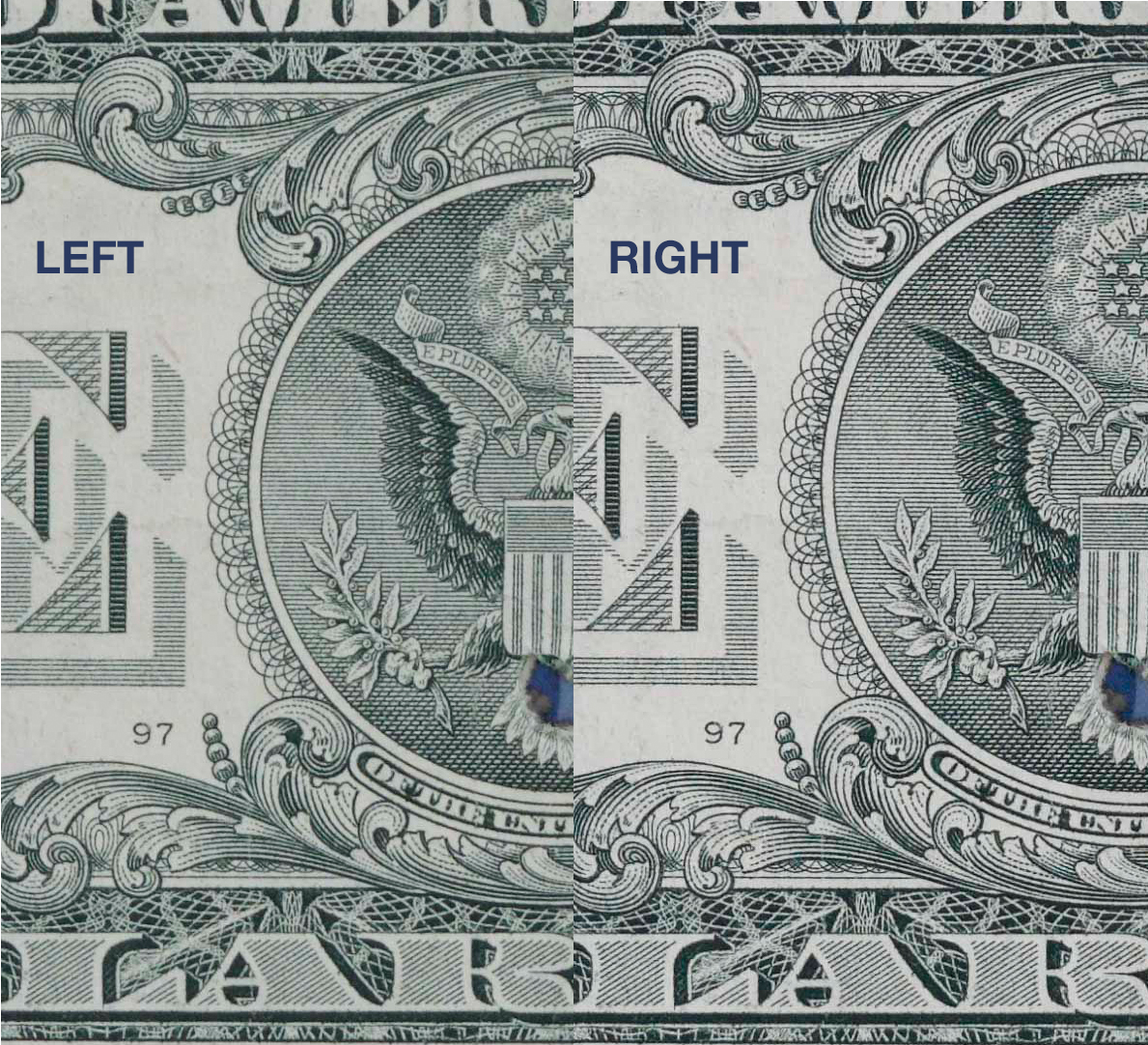
|
Side by side image comparison
Images courtesy of and copyright 2016: Patrick Sparkman
|
Four Simple Questions
Which image is sharper?
Which image appears cleaner to you?
Which image offers a higher degree of pleasing contrast?
Which shows the best image quality?
Would you say that the differences are dramatic, subtle, or non-existent?
Please Remember to use our Affiliate Links 🙂
To show your appreciation for my continuing efforts here, we ask, as always, that you get in the habit of using my B&H affiliate links on the right side of the blog for all of your photo and electronics purchases. Please check the availability of all photographic accessories in the BIRDS AS ART Online Store, especially the Mongoose M3.6 tripod heads, Gitzo tripods, Wimberley heads and plates, LensCoats and accessories, and the like. We sell only what I have used, have tested, and can depend on. We will not sell you junk. We know what you need to make creating great images easy and fun. And we are always glad to answer your gear questions via e-mail. I just learned that my account was suspended during my absence; it should be up and running by Monday at the latest.
I would of course appreciate your using our B&H affiliate links for all of your major gear, video, and electronic purchases. For the photographic stuff mentioned in the paragraph above we, meaning BAA, would of course greatly appreciate your business. Here is a huge thank you to the many who have been using our links on a regular basis and visiting the BAA Online store as well.
Facebook
Be sure to like and follow BAA on Facebook by clicking on the logo link upper right. Tanks a stack!
Typos
In all blog posts and Bulletins, feel free to e-mail or to leave a comment regarding any typos or errors. Just be right 🙂
January 19th, 2016
|

|
birds as art: The Avian Photography of Arthur Morris/The Top 100
The companion e-book to the solo exhibit at TheNat, San Diego, California
The new e-book on CD is available here.
|
birds as art: The Avian Photography of Arthur Morris/The Top 100
My latest e-book, created on a wing and a prayer in less than two weeks–see Harebrained Scheme here–includes the 67 spectacular images that hung in the Ordover Gallery at the San Diego Natural History Museum in a career-retrospective solo exhibition in 2017. In addition, there are an additional 33 images in the spectacular e-book that barely missed making the show.
This exhibition companion e-book makes it possible for everyone to “visit” TheNAT gallery retrospectively — and, in addition, to enjoy seeing my then-top one hundred bird photographs under one roof. Each image includes a title, the species name, the location, relevant EXIF data, and an anecdotal caption.
birds as art: The Avian Photography of Arthur Morris/The Top 100: $23 for the professionally produced CD (includes shipping to US addresses only)
Please click here to purchase the CD. As above, your purchase price includes shipping to all US addresses. If you would like your CD signed on the inside cover with a black Sharpie, you will need to place your order by phone and request a signed copy: 863-692-0906. For our Canadian friends we are offering the CD for $28 with shipping to Canada via phone orders only: 863-692-0906. Those who purchase the CD are advised to copy the file to their computers and then archive the CD.
To purchase via convenient download for $20, click here.
|
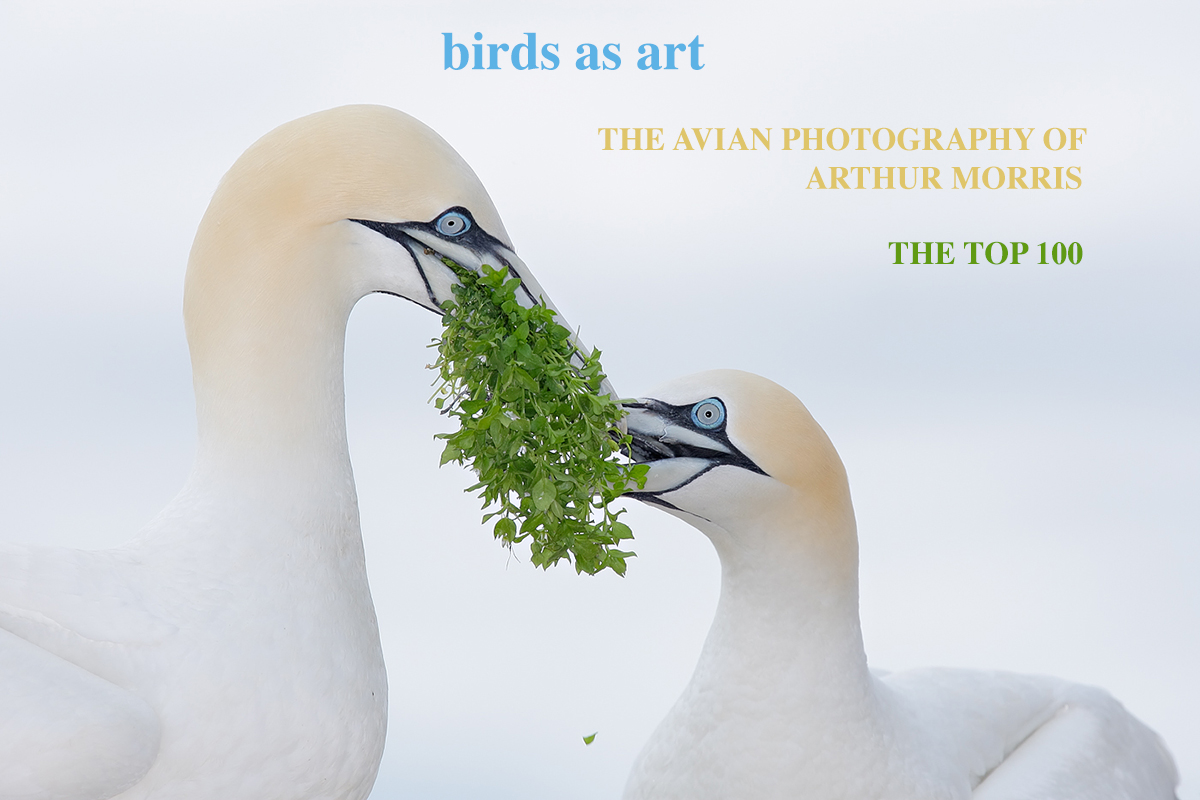
|
|
The new e-book via is also available via convenient download for $20 by clicking here.
|
birds as art: The Avian Photography of Arthur Morris/The Top 100: $20 via convenient download.
Overseas folks, and anyone else as well, can purchase the e-book via convenient download for $20 by clicking here.
Notate Bene
Please share this e-book only with your spouse or significant other. If a friend asks you to share a copy with them, please direct them either to this blog post or to the appropriate link in the BAA Online Store as above. All of the images and text are protected by international copyright law and may not be copied or printed without written permission from the photographer/author. Many thanks for honoring these requests.
You will–of course–need Adobe Acrobat Reader or another PDF player to view the PDF.
|
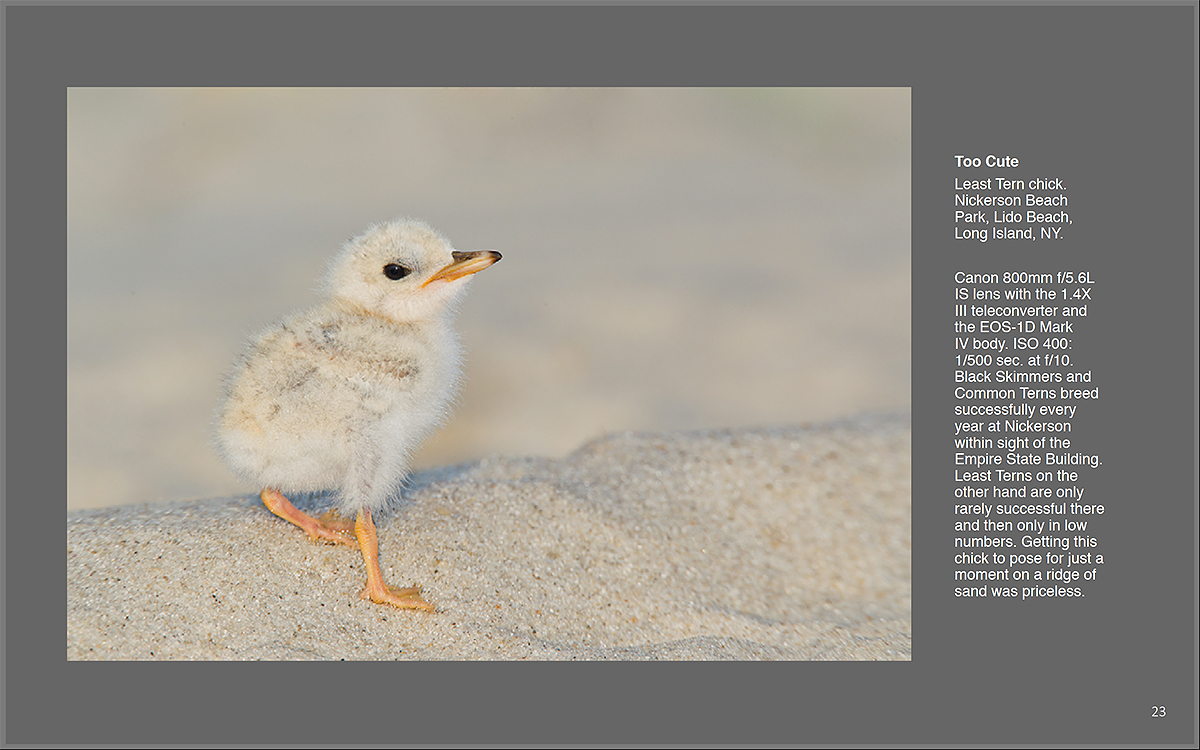
|
|
Sample page from birds as art: The Avian Photography of Arthur Morris/The Top 100.
|
Adobe Acrobat Reader Tip
To maximize your viewing pleasure, click Command + L on a Mac, or Control + L on a PC to view the e-book full screen. And then press Esc to exit full screen.
The 800 f/5.6L IS
I was amazed by how many of the exhibit images were created with the 800 f/5.6L IS… If you need maximum reach and would like to add this great lens to your gear bag consider the great buy below. You can see the complete Used Photo Gear listings here.
Canon 800mm f/5.6L IS USM Lens
Andres Leon is offering a used Canon 800mm f/5.6L IS lens in Very Good Plus condition for the very low price of $7899. The lens has clean glass and is in perfect working order but has a few scratches on the finish. Feel free to request photos of the lens. The sale includes the lens trunk and keys, a LensCoat, the front leather cover, the rear cap, a Wimberley P-40 lens plate, and insured ground shipping via FED-EX Ground. Your item will not ship until your check clears unless other arrangements are made. Please contact Andres via e-mail or by phone at 1-954-621-6678 (eastern time).
I used this lens, often with a 1.4X TC, as my main super-telephoto lens for close to five years. It is a superb lens that offers lots of reach for those working with birds that are skittish. It is great from the car. I was astounded that about 15 of the 67 images in the exhibit were created with my 800. I often miss it terribly. As the lens sell new at B&H for $12,999 Andres’s lens is a superb buy; grab it now and save more than $5K! artie
Please Remember to use our Affiliate Links 🙂
To show your appreciation for my continuing efforts here, we ask, as always, that you get in the habit of using my B&H affiliate links on the right side of the blog for all of your photo and electronics purchases. Please check the availability of all photographic accessories in the BIRDS AS ART Online Store, especially the Mongoose M3.6 tripod heads, Gitzo tripods, Wimberley heads and plates, LensCoats and accessories, and the like. We sell only what I have used, have tested, and can depend on. We will not sell you junk. We know what you need to make creating great images easy and fun. And we are always glad to answer your gear questions via e-mail. I just learned that my account was suspended during my absence; it should be up and running by Monday at the latest.
I would of course appreciate your using our B&H affiliate links for all of your major gear, video, and electronic purchases. For the photographic stuff mentioned in the paragraph above we, meaning BAA, would of course greatly appreciate your business. Here is a huge thank you to the many who have been using our links on a regular basis and visiting the BAA Online store as well.
Facebook
Be sure to like and follow BAA on Facebook by clicking on the logo link upper right. Tanks a stack!
Typos
In all blog posts and Bulletins, feel free to e-mail or to leave a comment regarding any typos or errors. Just be right 🙂
January 18th, 2016 What’s Up?
I woke very early and well before the alarm to pack for my nonstop flight from San Diego to Orlando. I am at the gate as I begin this blog post. If all goes well, right-hand man Jim Litzenberg should be picking me up at MCO at about 6:30pm Sunday evening.
Thanks for all of the congratulatory comments on the San Diego exhibit both here on the blog and on Facebook; they made my special day even more special. a
The Streak
In spite of having been buried by travel, teaching, the exhibit, and several major writing projects for the last two months, today’s blog post marks 75 days in a row with a new educational blog post. Please remember to use our B&H links for your major gear purchases.
|
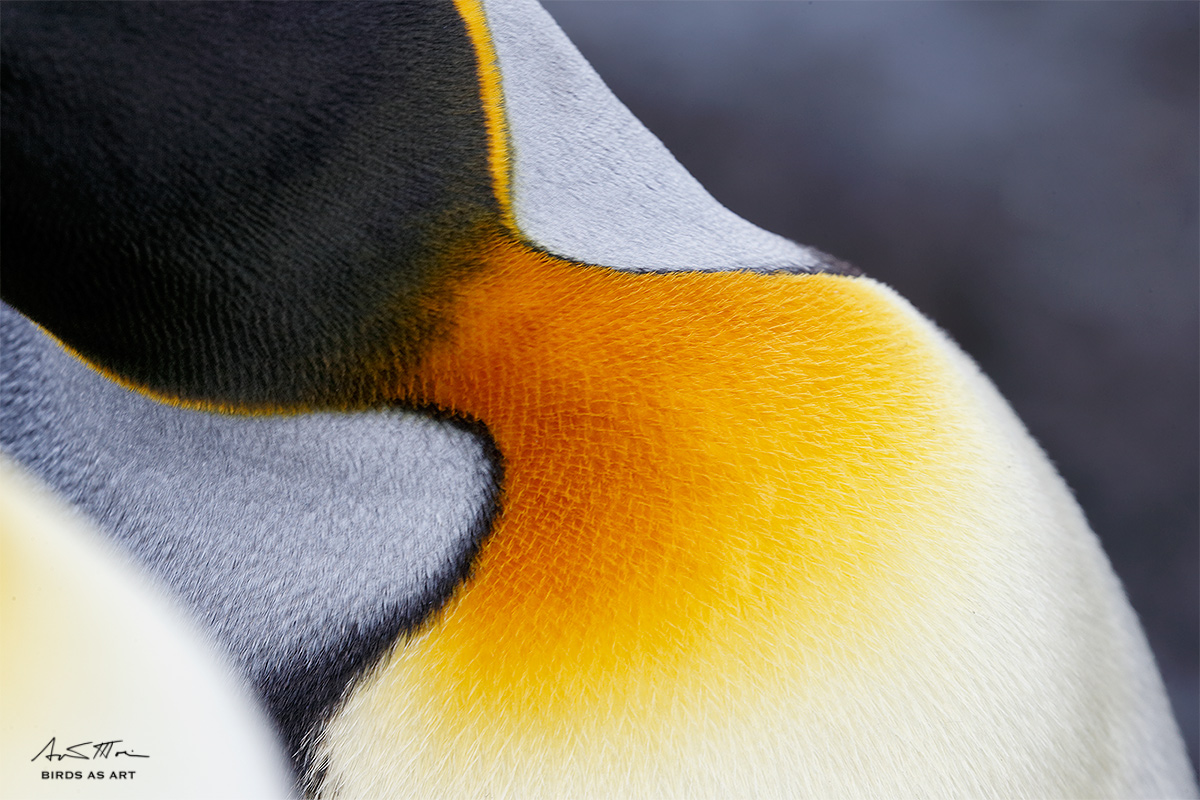
|
|
This image was created at Salisbury Plain on South Georgia on our last day of landings on the memorable 2015 Cheesemans’ South Georgia Expedition with the Induro GIT 304L tripod/Mongoose M3.6-mounted Canon EF 100-400mm f/4.5-5.6L IS II USM lens, the Canon Extender EF 1.4X III (at 560mm), and the rugged Canon EOS-1D X. ISO 400. Evaluative metering +1/3 stop: 1/200 sec. at f/16. AWB.
Center AF point (Manual selection)/AI Servo/Rear Focus AF as framed was active at the moment of exposure. Click here to see the latest version of the Rear Focus Tutorial. Click on the image to see a larger version.
King Penguin neck abstract
|
Image Design Answer
In the blog post here, I asked if folks liked the photo-bombing penguin in the lower left corner. Most did not. I must admit that I did not like it much at first but over time it grew on me.
The 100-400 II
Most of you know how much I love this great lens. See lots more on that below. Many folks have been asking “Which super-tele best fits with the new 1-4? Read on to learn my thoughts.
I have received more than a few e-mails recently from folks who already own the 100-400II and wish to enter the world of super-telephoto photography. One such e-mail from retired Tennessee State Senator Doug along with my reply should help most folks in the same boat make this difficult decision.
AM: Hi Doug, It is good to hear from you. Love your closing, “Reformed Senator and struggling photographer.”
re:
DJ: I recently found your blog and videos. Great resource. I really appreciate your willingness to share knowledge.
AM: Thanks. That has been my specialty for a while. 🙂
DJ: You have motivated me to venture into bird and travel photography in my new retirement. I do have a 600mm non-IS; it is very old and very heavy but sharp.
AM: Been there, done that 🙂
|
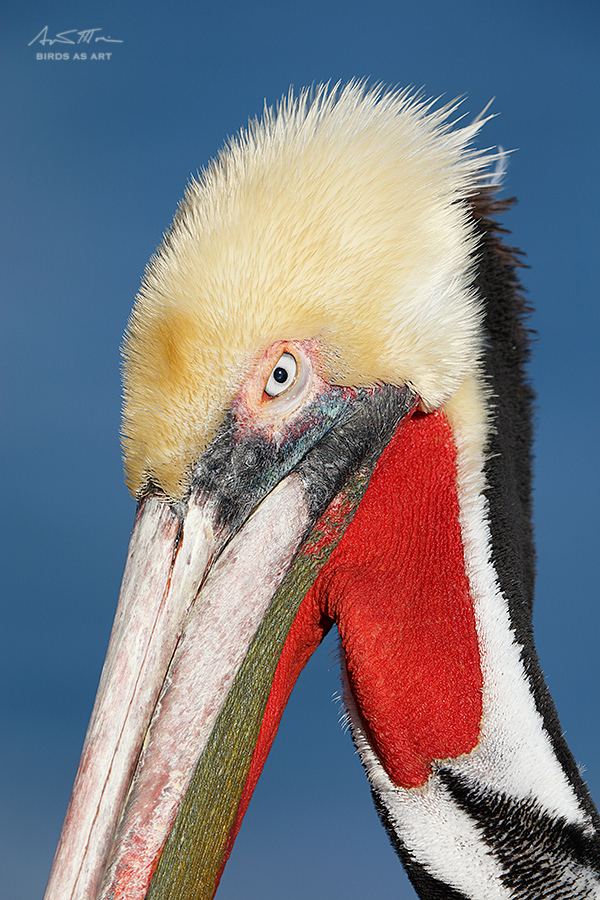
|
|
This image was created at La Jolla, CA on the last morning of the hugely successful 2016 San Diego IPT with the Induro GIT 304L/Mongoose M3.6-mounted Canon EF 500mm f/4L IS II USM lens, the Canon Extender EF 2X III, and the Canon EOS 5DS R. ISO 400: 1/640 sec. at f/11. AWB.
Center AF point (by necessity)/AI Servo Expand/Rear Focus AF as originally framed was active at the moment of exposure. This is a very, very, small crop from the left and the top. Click here to see the latest version of the Rear Focus Tutorial. Click on the image to see the incredible fine feather detail in a larger version.
Brown Pelican bill pouch detail
|
The 500 II
The 500 II gives me 1000mm of full frame reach with the 2X TC and 700 with the 1.4X; a perfect fit for the 100-400 II unless you need the reach of the 600 II plus TCs…
The e-mail conversation continued…
DJ: I have planned to purchase two new lenses and have narrowed the search down to three. The new 100-400II L IS the Canon EF 400mm f/4 DO IS II USM lens, and the Canon EF 500mm f/4L IS II USM lens
AM: Assuming that you have ruled out the 600 II as too bulky and too heavy, your choice is an easy one: go with the 100-400mm II and the 500 II. They were both in my gear bag for San Diego and will be for the Greece trip as well. Note, however, that when I am traveling to places where weight is somewhat of a premium and the birds are tame, I will opt for the 100-400II/400 DO II/combo in part because I am so proficient with the 2X III TC and the Canon EF 400 DO II; folks like me who can consistently make sharp images with an f/4 lens and the 2X III TC will then have a nice 100-400 and 560/800 combo to work with.
DJ: It’s a big decision and I would value your opinion.
AM: Understood and it was wise of you to ask me.
DJ: Which combo would you recommend for wildlife and travel?
AM: See above.
I have always wanted the Canon EF 400mm f/4 DO IS II lens but the new 100-400 a seems to be such a versatile lens.
AM: It is an amazingly versatile lens and I absolutely love the close focus as well as its amazing sharpness and 4-stop Image Stabilization system. Understand that the 400mm DO II somewhat counterfeits the 100-400 unless–as noted above–you are skilled at making sharp images with the 400mm f/4 DO IS II and the 2X III TC. Of note is the fact that the 1-4 II is so versatile that many have gone away from the 200-400 with internal Extender. That one still remains at the top of the list for Africa in part because of its versatility and in part because the built-in TC is a big plus in extremely dusty environments.
|
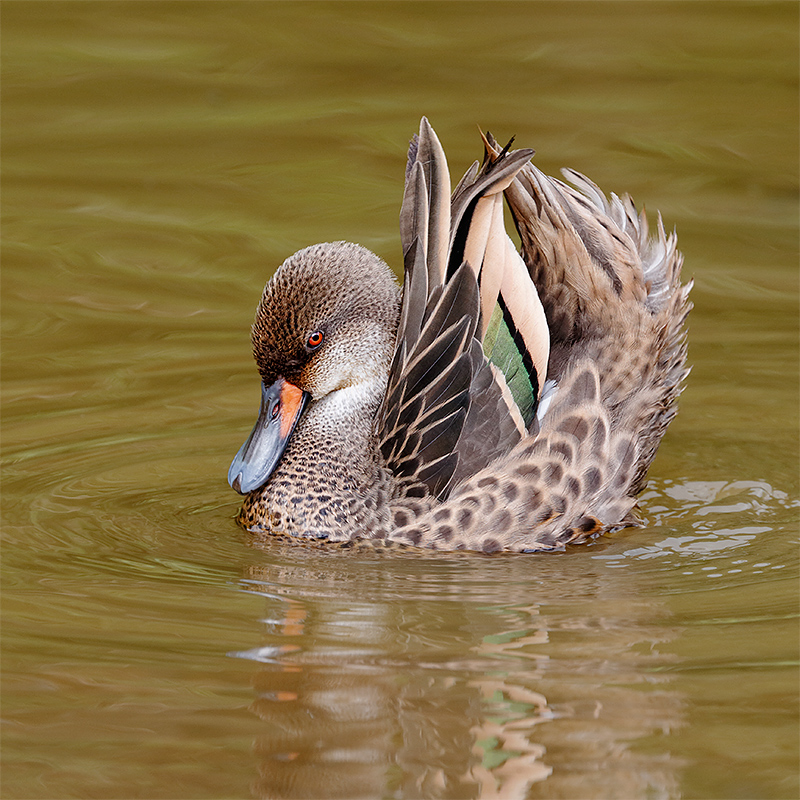
|
|
This image was created at the highlands of Puerto Ayora at 8:55am on July 21, Day 8 of the 2015 Galapagos Photo Cruise. I used the tripod-mounted Canon EF 400mm f/4 DO IS II USM lens with the Canon Extender EF 1.4X III and the Canon EOS-1D X. ISO 800: Evaluative metering at zero: 1/500 sec. at f/10 in Av mode.
Center AF point/Spot AF/Shutter Button AI Servo AF was active at the moment of exposure as is pretty much mandatory with moving subjects. The selected bird’s folded wing as originally framed. Click on the image to see a larger version.
Image #1: Galapagos White-cheeked Pintail displaying male
|
The 400 DO II
When working with tame birds or when I wish to travel light, the 400 DO II serves as my big super-telephoto lens, most often on a tripod with the 2X III TC.
The e-mail conversation continued…
DJ: Would the portability of the 400mm DO II make it a better choice than a 500mm II IS? BTW, I will purchase these through your web site.
AM: As above, only in very certain circumstances; I routinely travel to places like the Southern Ocean and the Galapagos with 400 DO II/100-400II combo. On some of those trips the Canon EF 70-200mm f/2.8L IS lens comes along for the ride. That old favorite was very useful in several low light situations in San Diego.
DJ: I shoot a 7D2 and a 5DSR.
AM: Good luck 🙂 This will probably shock the world but I may be selling all of my camera bodies and going only with 5DS Rs… Thanks to dear friends Patrick Sparkman it will soon–via a coming blog post–be easy to see and absolutely clear how much better the 5DS R is than anything that Canon offers at present.
DJ: I am planning to book a trip with you this year. I am going to Kenya and France this year with a fellow Tennessean, Jim Zuckerman. I too bought a 5DSR. Seeing your images, I feel it was a good decision–Jim is not so sure. Large, super high-res monitors are coming.
AM: Jim is somewhat of a friend and someone who has my great respect. My 5DS R images look mighty fine on my Macbook Pro with Retina Display. I will ask a favor: when the 5DSR Image Quality Superiority blog post is published, please send a link to Jim.
To simplify your shopping, here are my affiliate links for the two lenses discussed above:
Canon EF 500mm f/4L IS II USM Lens
Canon EF 400mm f/4 DO IS II USM Lens
Please let me know if you have any additional questions. If you want to chat further about your gear choices give me a buzz at home at 863-692-2806 next week. I will be home late Sunday.
Please let me know if you need any additional product specific links and please shoot me your B&H receipt when you are done shopping.
later and love and be sure to subscribe to the blog.
artie
The 600 II
I continue to own and use the Canon EF 600mm f/4L IS II USM lens when I need every bit of reach, when I can easily get the lens to a given location, and when I do not have to walk long distances.
The 600 II is numero uno when working from my car off a BLUBB. I ship it to Bosque every year so that I can use it to photograph single cranes and single geese in flight. I managed to get it to Japan on my last trip there and to the UK as well for the puffins in flight. It is, however, a bear to travel with.
The 100-400II
Right now, the Canon EF 100-400mm f/4.5-5.6L IS II USM lens just might be my favorite-ever Canon lens. As regular readers know, and as above, I love it for it amazing close focus (.98 meters!) as well as for its superb sharpness and its 4-stop Image Stabilization system. Not to mention its great versatility and focal length range as well as its light weight and hand holdability. If you photograph birds, wildlife, or nature and do not own this great lens, you should!
Please Remember to use our Affiliate Links 🙂
To show your appreciation for my continuing efforts here, we ask, as always, that you get in the habit of using my B&H affiliate links on the right side of the blog for all of your photo and electronics purchases. Please check the availability of all photographic accessories in the BIRDS AS ART Online Store, especially the Mongoose M3.6 tripod heads, Gitzo tripods, Wimberley heads and plates, LensCoats and accessories, and the like. We sell only what I have used, have tested, and can depend on. We will not sell you junk. We know what you need to make creating great images easy and fun. And we are always glad to answer your gear questions via e-mail. I just learned that my account was suspended during my absence; it should be up and running by Monday at the latest.
I would of course appreciate your using our B&H affiliate links for all of your major gear, video, and electronic purchases. For the photographic stuff mentioned in the paragraph above we, meaning BAA, would of course greatly appreciate your business. Here is a huge thank you to the many who have been using our links on a regular basis and visiting the BAA Online store as well.
Facebook
Be sure to like and follow BAA on Facebook by clicking on the logo link upper right. Tanks a stack!
Typos
In all blog posts and Bulletins, feel free to e-mail or to leave a comment regarding any typos or errors. Just be right 🙂
January 17th, 2016

B&H
B&H was the primary exhibition sponsor. Thank them (and me, for the work I do on the blog) by clicking on the logo link above to shop.
|
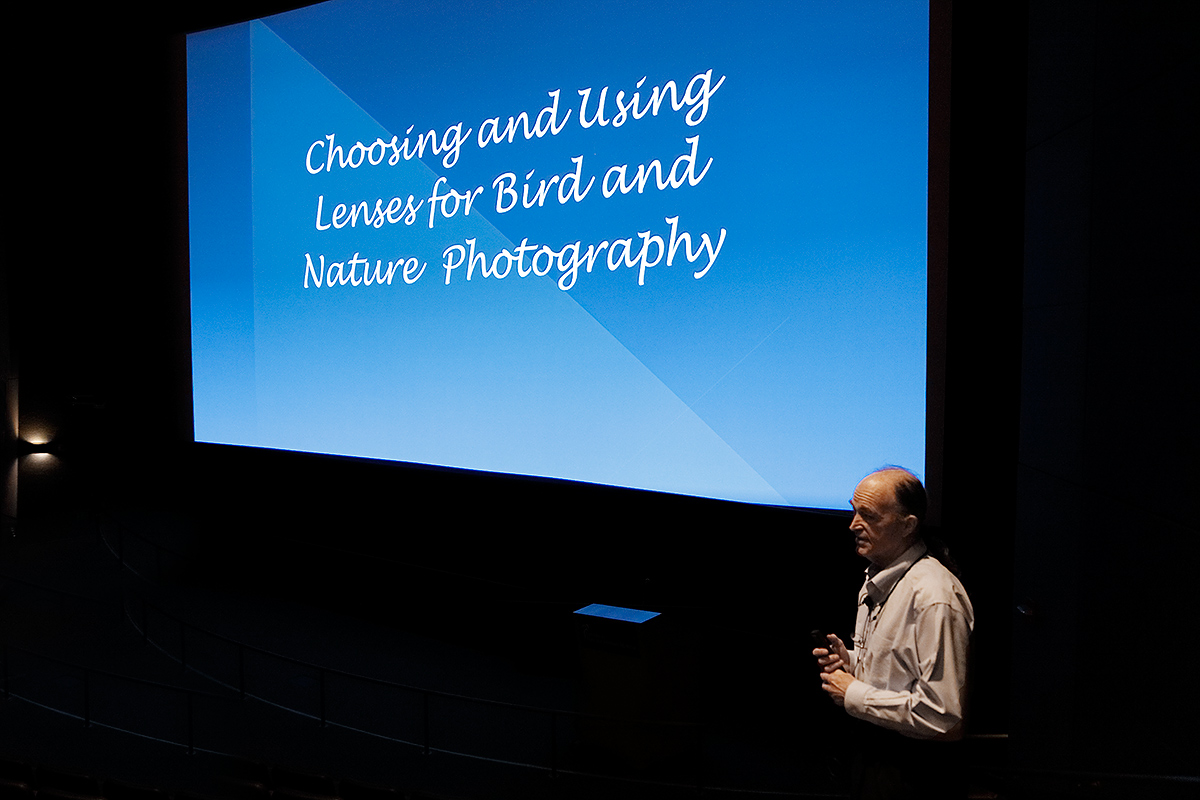
|
artie’s NATtalk. Photo courtesy of and copyright 2016: Bob Allen
|
|
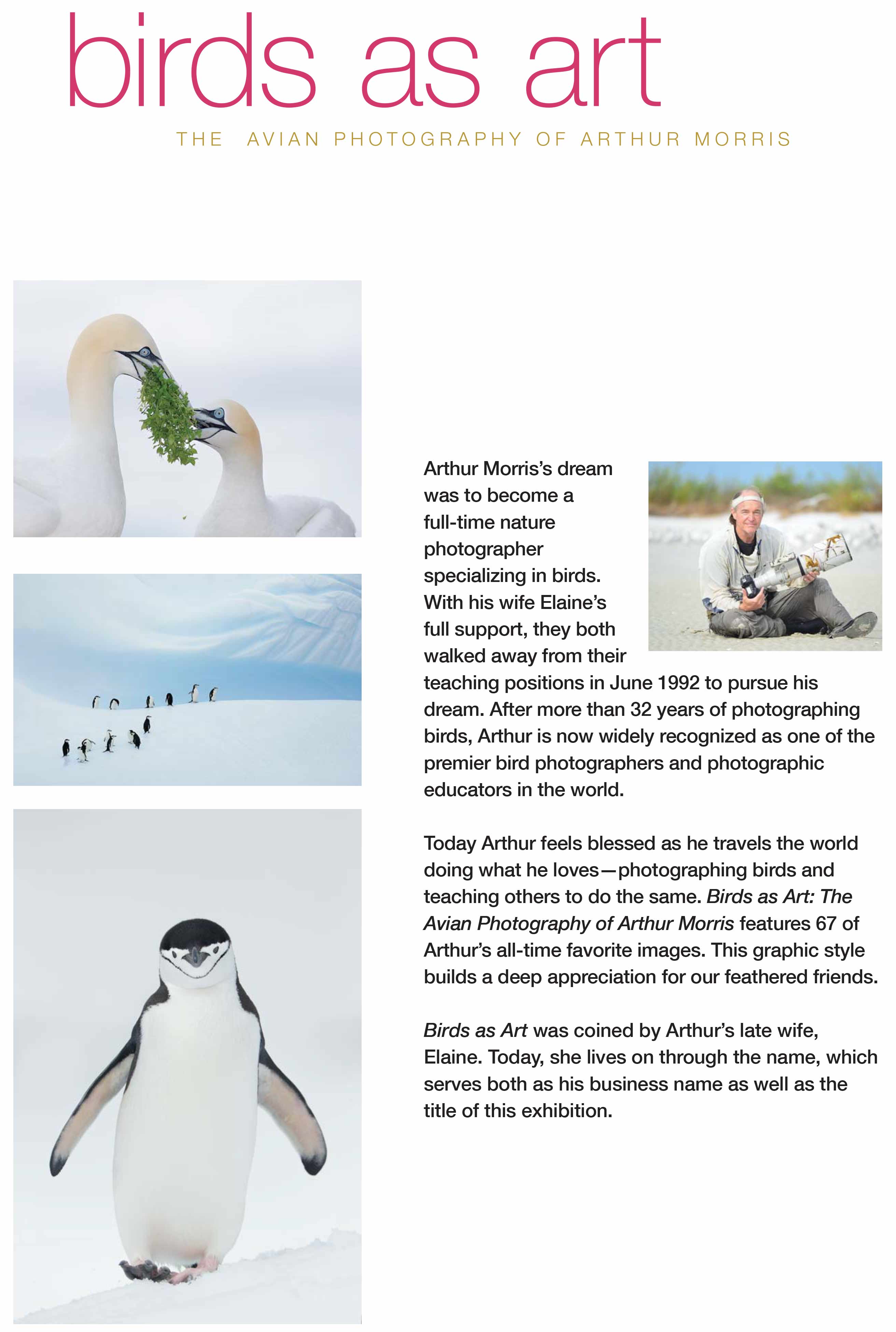
|
Exhibit Intro Panel: design by Mary Lou Morreal (SDNHM)
|
What’s Up?
After arriving early to get the projector set up and do a sound check, I went up to the exhibition space with a few friends. As I had not seen the prints I was a tiny bit nervous. Everyone–including and especially me–was blown away by the quality and color fidelity of the images. Mark Lukes and his staff at Fine Print Imaging in Fort Collins, CO simply knocked it out of the park. Many folks asked where the prints were made.
The experience of walking through the images in such a spectacular setting was a surreal one. To see the work of 32 years laid bare on the walls for all to see was a daunting one. I could not have felt more proud.
Locals who missed the opening and those who will be visiting San Diego in the next few months can learn more about the SDNHM gallery exhibition here.
|
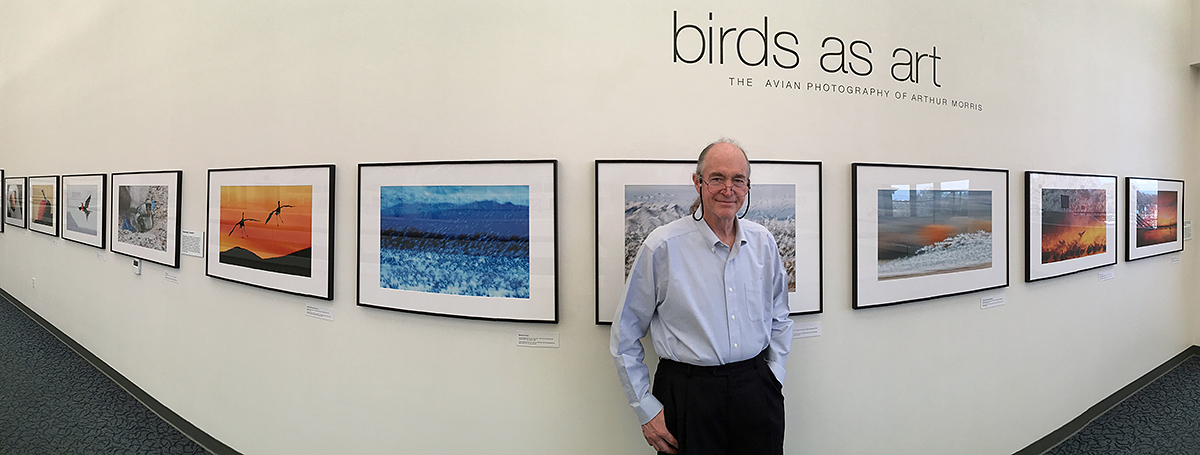
|
iPhone pano of artie and framed images. Courtesy and copyright 2016: Cliff Oliver.
|
|
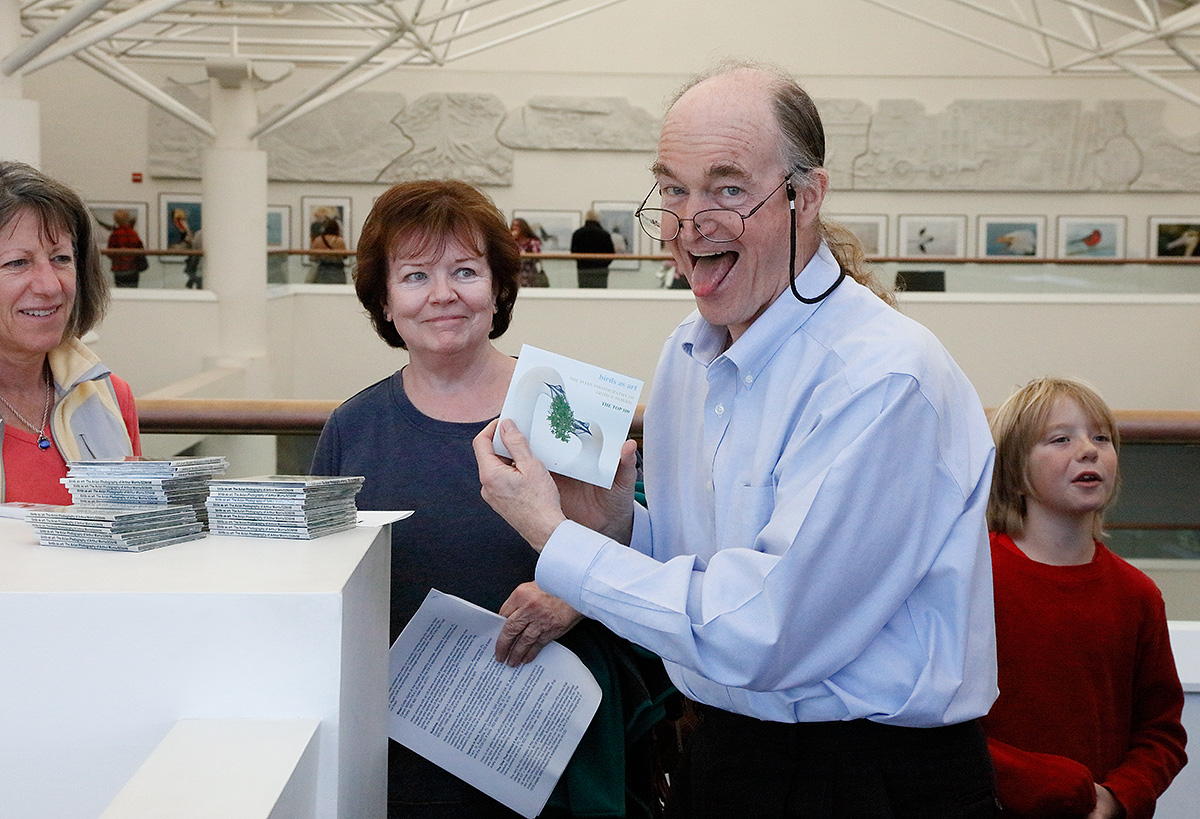
|
CD Sales at the opening were brisk. Photo courtesy of and copyright 2016: Bob Allen
|
|
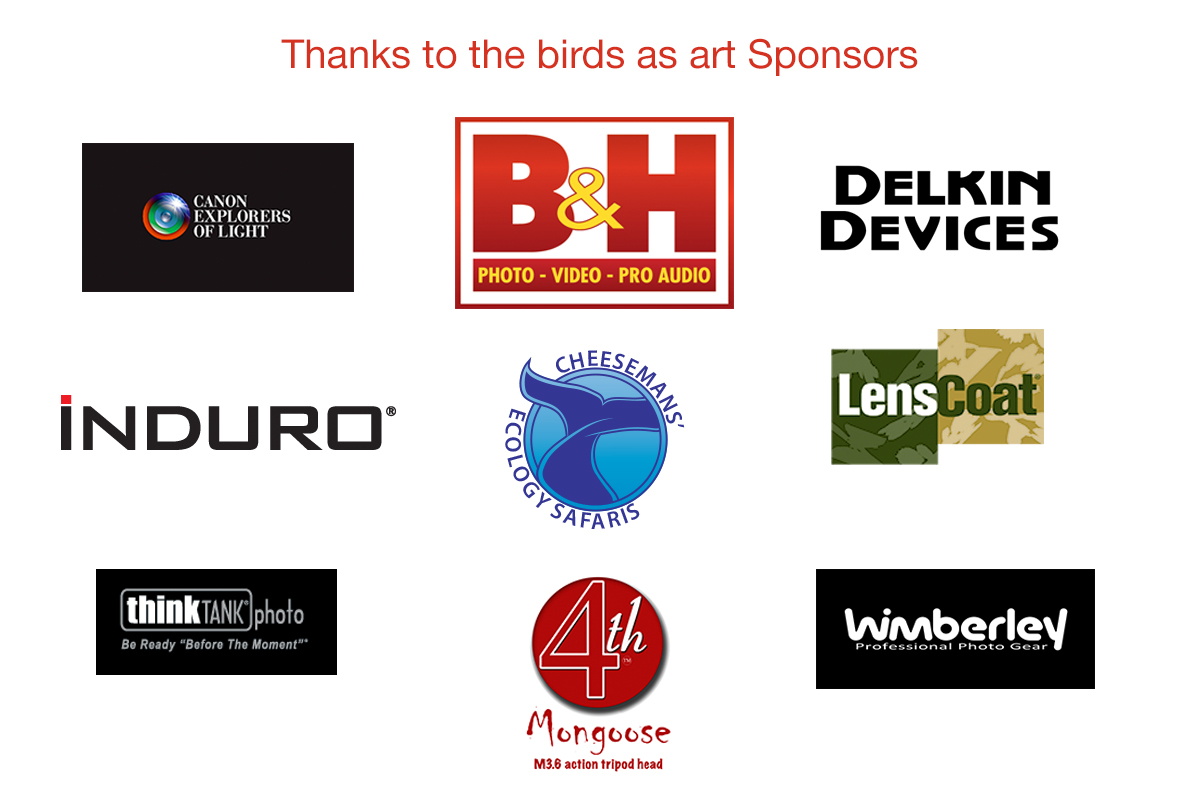
|
SDNHM Exhibit Sponsors
|
|
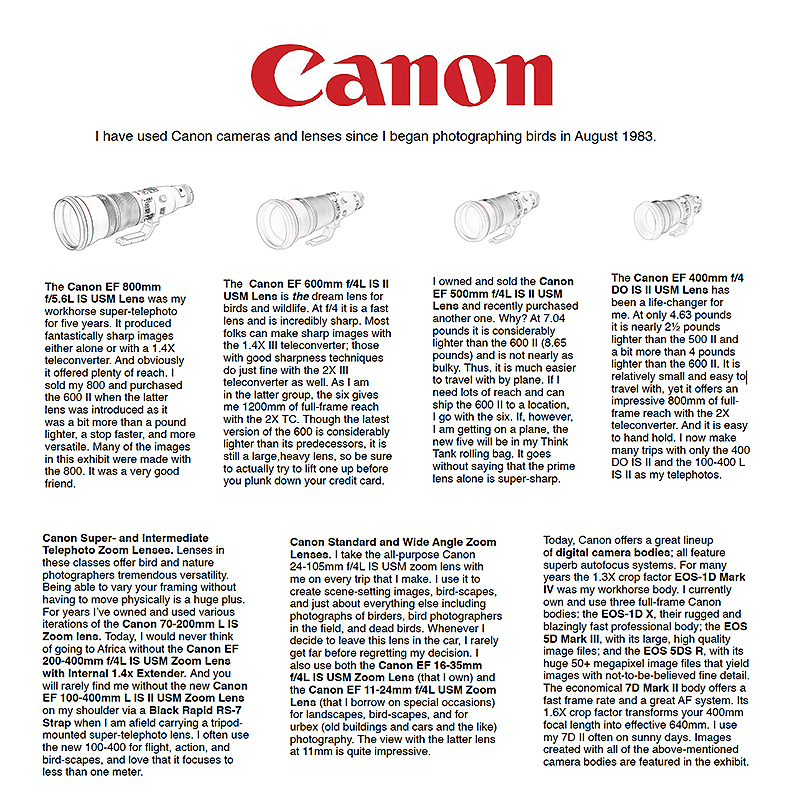
|
My Canon Gear Summary Panel
|
January 16th, 2016 What’s Up?
Six of us enjoyed a last morning at the cliffs. There were not a lot of pelicans but those that remained after a big group took off were quite tame… Muriel McClellan graciously treated everyone to a fine lunch at The Crab Catcher. In the afternoon I put the finishing touches on my Saturday morning program–see yesterday’s blog–and headed up to Carlsbad for dinner and INSPIRE: The Power of Story. Cliff Oliver’s mentor, Dr. Paul Brenner, the father of alternative medicine in the US, is one of four featured speakers.
If today’s blog post inspires you to join the BAA group for the OCT/NOV 2016 Cheesemans’ South Georgia/Falklands Expedition please scroll down for details.
Clemens Van der Werf Blog Post
If you enjoy good photography, you will want to check out Clemens’ Adventure in South Georgia blog post here. In addition to some good writing you will find a dazzling array of images including lots of scenics, some killer black and whites, and some excellent people in nature stuff.
In addition to being a good friend Clemens is one of (if not the) top BIRDS AS ART students.
Free Relevant Excerpt from the Southern Ocean Photography Guide
Elsehul
On my 2015 trip we landed the next morning at Elsehul after being faced with wind and snow on our landing at Undine Harbor the day before. Cheesemans’ had sent out a scout team to search for Grey-headed Albatross nests and reported by walkie talkie that in addition to the hike being steep in spots and tough (both as usual) that the only nest they had found was quite a distance from the landing site, about 1 ½ miles.
The day was quite lovely and though you can never count on such conditions to last long on South Georgia, many folks decided to make the trek. For me, with my problematic left knee, the decision not to try the hike was an easy one. On the beach you can expect the same birds and animals as noted for Undine Harbor.
Knowing that most of the folks in my group would not be making the long difficult hike I was keen to see if we might find a spot to photograph some Grey-headed Albatross in flight. That search did not take long. In fact, as we landed I noted a headland to the right of the landing site. Both grey-headeds and light mantled sootys were flying by on a fairly regular basis. Bingo I thought.
I asked permission from a staff member to make the gentle climb up the top of the headland and hang out for a while. It was granted. I took my time and the climb was not too difficult at all. Some folks in the BAA group joined me. At first the birds simply stopped flying. I was 100% positive that that was purely coincidental and that the birds in flight were in no way affected by our presence. After a while, I would be proven right.
One group member got bored too quickly and left. Others who had faith in their leader stuck it out. And after about 45 minutes they were rewarded. We had birds of both species flying above us and below us, some so close that you had to duck. In addition, we had some good chances with a few Giant Petrels that were exploring the hillside below us for nest sites.
I enjoyed on and off action for about four hours as other group members came and went. When it comes to flight photography, my determination serves me well. Be on the lookout for nice scenics anywhere at this location: on the ridges, on the beach, from the zodiacs, and even from the ship. Heck, the same applies to pretty much all of South Georgia with its spectacular mountains and related geology. The best lens for scenics might range from a fish eye or wide angle to an intermediate telephoto and would include everything in between.
As always for flight photography we worked in Manual mode. We used one exposure for the Grey-headed Albatrosses and went one shutter speed click lighter for the overall slightly darker Light Mantled Sooty Albatrosses. If you are confused by the above please see Exposure Simplified in The Art of Bird Photography II (ABP II: 916 pages, 900+ images on CD only). Learn more in the “A Brush-up Tutorial on Working in Manual Mode” blog post here. Learn which is the best shooting mode in the “At Long Last, As Promised: the Greatest, Most Educational Blog Post Ever? Manual… Av… Tv… Program… Which is The Best Shooting Mode?” blog post here.
Southern Ocean Photography Guide
The Southern Ocean Photography Guide is a work in progress. I hope to have it finished as soon as possible. If you are headed to the Southern Ocean and would like to purchase a pre-publication version please shoot me an e-mail.
|
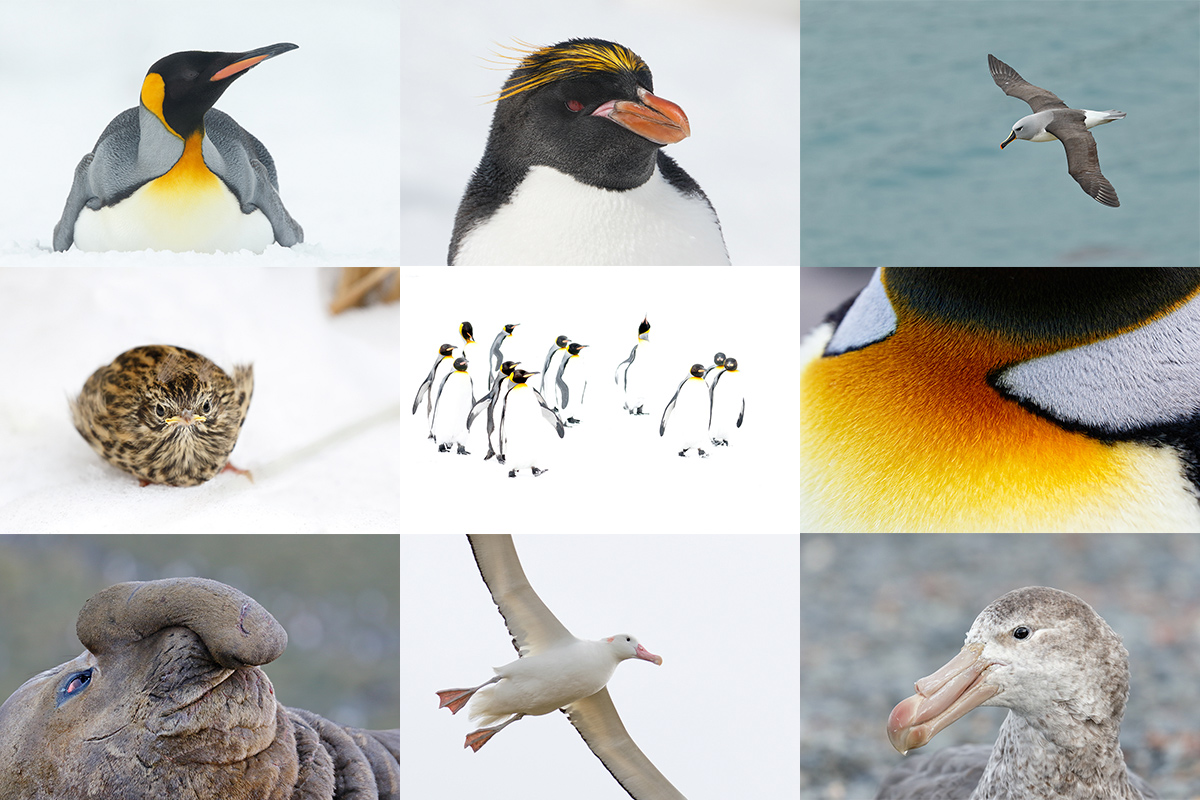
|
|
All images on the card were created on the 2015 Cheesemans’ South Georgia Expedition. From top left clockwise to center: King Penguin resting on Snow, Fortuna Bay; Macaroni Penguin in snow, Cooper Island; Grey-headed Albatross, Elsehul; King Penguin neck abstract, Godthul; Northern Giant Petrel, Undine Harbor; adult Wandering Albatross, Prion Island; Elephant Seal, Undine Harbor; South Georgia Pipit fledgling/thanks Joe Kaplan! Fortuna Bay; high key King Penguins in snow, Fortuna Bay.
Card design and all images copyright 2015: Arthur Morris/BIRDS AS ART
|
Hard to Believe: An End to the Best…
I have been to the Southern Ocean five times, the last four with Cheesemans’ Ecology Safaris (CES). It is common knowledge that they offer the finest ship-based photographic expeditions to South Georgia and the Falklands. Nobody else is close. They will make landings in tough conditions. Always. Their experienced staff and crew of zodiac drivers will get you on and off safely. You will enjoy so much time on a given landing that you will often want to head back to the ship early! Sorry, not me (though I did go back to the ship an hour early on our 2015 St. Andrews Bay landing. I quit after only 12 1/2 hours to go back to the ship on the 5pm zodiac when I could have stayed till 6pm…. My excuse? I could not raise my lens anymore.)
I learned recently that their October 22-November 6 (on the Sea Spirit) will be their last trip down to wildlife heaven on earth. Here is what Ted Cheeseman had to say:
The 2016 October/November expedition will be our last to South Georgia. Market changes, regulation changes, and as big of a part of our lives as it has been, we realize this next will indeed be the last.
When I asked him if he was sure that the 2016 trip would be the last, he replied:
To be honest, we have been known to go back on our statement of ‘last trip ever’. But for South Georgia, I don’t see how we could do it in the future. We want to continue but the costs are skyrocketing, regulation is threatening in a way that I think after 2016 may very well make it impossible to have free roaming folks ashore, i.e. possibly guided groups only – no thank you. So though I am loathe to say it, the Oct/Nov 2016 trip will be our last. If we do another before the end of 2018, I’ll see to it that you get free passage aboard. How’s that for a commitment?
BIRDS AS ART and the 2016 Cheesemans’ South Georgia/Falklands Expedition
When I got off the Ortelius at Stanley and told Ted that the just concluded voyage would be my last to the Southern Ocean, I meant it. But once I heard that the 2016 trip would be their last, I realized that I had to make the trip. As soon as I sign up a single participant for the expedition’s BAA group, I will be sending my deposit check.
If you would like to join me on what will be an amazing trip to a wondrous place, please shoot me an e-mail with the words “Cheesemans’ Last South Georgia Expedition” cut and pasted into the Subject Line.
|
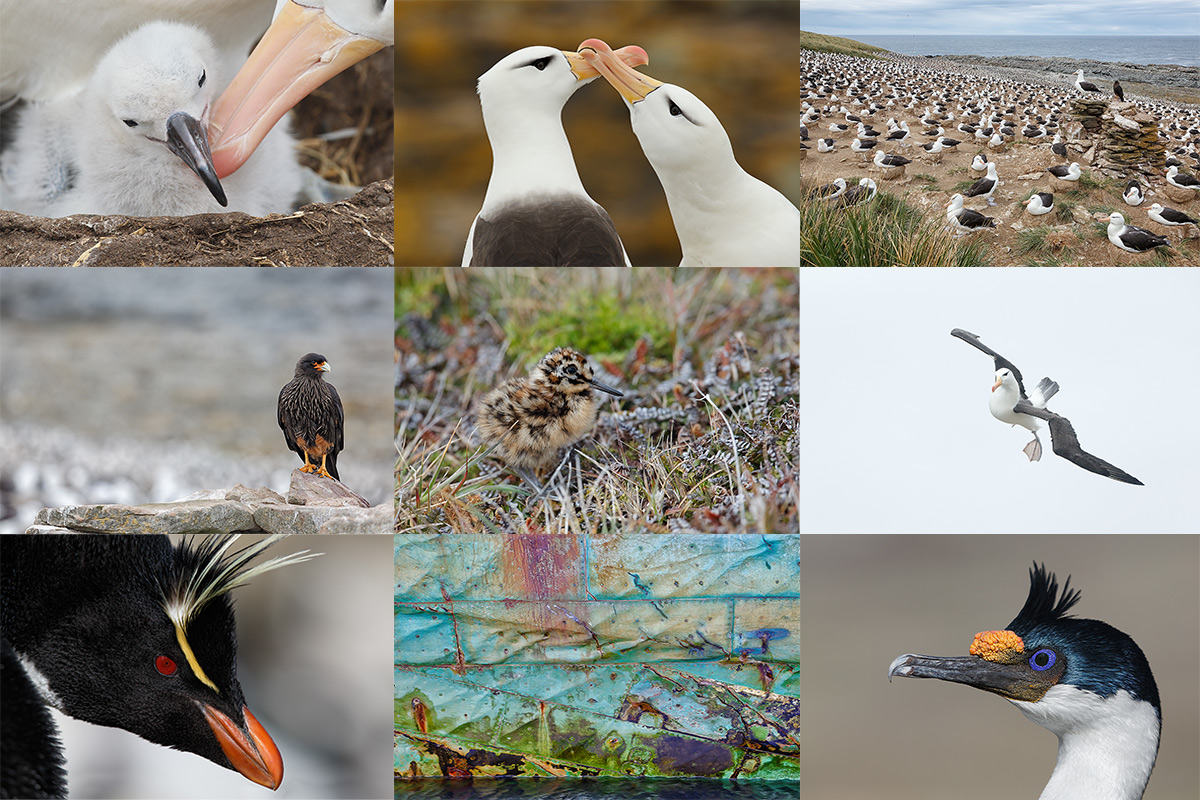
|
|
All of the images on this card were created in the Falklands on the 2014 Cheesemans’ Southern Oceans Expedition. From top left clockwise to center: Black-browed Albatross tending chick, Steeple Jason Island; Black-browed Albatross courting pair, New Island; the Black-browed Albatross colony at Steeple Jason Island; Black-browed Albatross landing, New Island; King Cormorant head portrait, New Island; hull detail/derelict minesweeper, New Island; Rockhopper Penguin head portrait in bright sun, New Island; Striated Caracara, Steeple Jason Island; Magellanic Snipe chick, Sea Lion Island.
|
An Expedition Overview
Experience the vibrant spring of South Georgia, a true Antarctic wildlife paradise. Observe and photograph wildlife behaviors seldom seen beneath the towering, snow blanketed mountains (see image below) that dominate the island’s landscape. Southern Elephant Seal bulls fight for breeding rights while females nurse young, overlook vast colonies of loafing King Penguins, watch Macaroni Penguins cavort in the snow, photograph handsome Gray-headed Albatrosses in flight or attending to their cliffside nests and awkward Wandering Albatrosses attempting first flight. The itinerary includes six landing days on South Georgia and three landing days in the Falklands to observe too cute Rockhopper Penguins, Magellanic Penguins standing watch at their nesting burrows, and more Black-browed Albatrosses than you could ever imagine. To commemorate Shackleton’s famous self-rescue crossing South Georgia, CES also offers an optional trek retracing his steps. With Cheesemans’ twenty years of experience in the Antarctic region, they commit to an in-depth exploration of one of the densest wildlife spectacles found anywhere in the world, and with only 100 passengers, they routinely give you the opportunity to completely immerse yourself on each landing.
Two of the scheduled Falklands landings, New Island and especially Steeple Jason Island, rival the best locations on South Georgia. Those will likely include Salisbury Plain, St. Andrews Bay, Elsehul, Fortuna Bay, and either Cooper Island or Hercules Bay (for Macaroni Penguins).
Why Sign Up Through BIRDS AS ART?
If you have been thinking and dreaming of finally visiting South Georgia, this is the trip for you. There will likely never be another trip like this as the best outfit in the Southern Oceans business will not be returning after 2016…. Quit dreaming and act now. Though I will not be an expedition staff member on this trip, those who have traveled with me know that I cannot help but teach. And I will be doing a introductory photography program for the entire ship on our crossing to South Georgia. All who sign up via BAA will receive a free copy the new Southern Ocean Photography Guide (a $100 value) that I am currently working on. It will include pre-trip gear and clothing recommendations and a ton of info that you will find to be invaluable.
I will hold informal pre-landing briefings aboard ship so that when you land you know exactly what to expect and where to go. I will be available on the ship to review your images, answer your questions, and conduct informal over-the shoulder Photoshop sessions. And best of all, everyone who signs up under the auspices of BAA are invited to tag along with me on the landings where I will be glad to offer invaluable in-the-field advice. And the same goes for the shipboard birds in flight and marine mammal photographic sessions.
Again, if you would like to join me on what will truly be a once in a lifetime opportunity to a wondrous place, please shoot me an e-mail with the words “Cheesemans’ Last South Georgia Expedition,” cut and pasted into the Subject Line.
You can learn more about the trip here. If you sign up on your own be sure to mention that you would like to be part of the BAA Group. I’d be glad to answer any and all question via e-mail or by phone at 863-692-0906.
Important Notes
#1: If you fail to e-mail me as noted directly above, and register directly with CES you MUST let them know that you would like to be part of the BIRDS AS ART group.
#2: Joining the BIRDS AS ART group as above will not cost you one penny.
The Sea Spirit
The Sea Spirit is an “all suite” luxury vessel built for sailing in ice with an ice-strengthened hull and retractable fin stabilizers, the latter deliver smooth sailing to make your polar expedition enjoyable and safe. All cabins have a private, en-suite bathroom, a lounge area, and ample storage. The cabins have unobstructed exterior views via portholes, picture windows, or a private balcony. The ship is outfitted with a presentation room for on-board lectures as well as a gym, library, game room, lounge, bar with bartender, and dining lounge with chef-prepared meals. The Sea Spirit provides warm and comfortable accommodation for 100 passengers, the expedition staff, and the ship’s crew. The Sea Spirit carries a fleet of ten Zodiacs. The Zodiac loading area, located at the rear of the ship, provides a safe and relatively sheltered place from which to embark on our adventures.
Best of all, the Sea Spirit does 14 knots, a huge step above the other ships that I have been on; each crawled along at 11 knots…
Going Light
On recent trips I found myself going with shorter lenses and lighter gear than on my previous Southern Ocean Expedition. It is completely conceivable that you could do the entire trip with either the new Canon EF 100-400mm L IS II lens or a Canon EF 70-200mm f/2.8L IS II USM lens with both teleconverters. Nikon folks could go with the Nikon AF-S NIKKOR 80-400mm G ED VR lens or the Nikon AF-S NIKKOR 70-200mm f/2.8G ED VR II lens and the Nikon TC-14E II 1.4x Teleconverter for D-AF-S & AF-I lenses ONLY. We do not recommend the Nikon 2X TCE.
A good crop factor camera body like the Canon EOS-7D Mark II makes makes life (and landings!) much easier.
Cheesemans’ Well Deserved Kudos
I know from personal experience that if you are a photographer who is going to invest in Southern Ocean voyage, you will want to put your money on Cheesemans’. No other tour company goes as far out of their way to ensure making every possible safe landing. And no other tour company will have you spending more time on land. Michael Viljeon from South Africa was aboard the Ortelius on a Southern Oceans voyage that preceded the Cheesemans’ trip that we were both on. As we headed back to Ushuaia, he said, “The folks that ran that first trip were pathetic. Too rough. No landing today. Surf too high today. No landing. Wind wrong direction. No landing. Cheesemans’ routinely and safely gets folks on land in conditions where the leaders of other tour companies do not even bother getting out of their bunks.”
Here, from the” Way to Go CES! (Cheeseman’s Ecology Safaris)” blog post here, is one of my favorite Cheesemans’ stories:
The landing at Bailey Head, Antarctica, was especially rewarding to me as I had been sitting in a zodiac 100 yards off shore on my 2007 trip when the zodiac in front of mine swamped and the captain of the ship called off the landing…. Early that day it looked as if my weather Karma might not be working. Ted’s “Good morning shipmates” was followed by the news that we would not be able to land at Bailey Head that morning as the swell was too big. The beach there is sloped tremendously and the sea strives to pull the zodiacs back into the ocean before folks have gotten off with their gear. Tom Murphy had said to me several days before, “We will get you on the beach at Bailey Head.” Ted concluded his morning greetings by saying, “We are sending out a scout team to see if landing is possible.”
After breakfast I was thrilled to hear Ted’s voice again on the PA, “We will be landing at 8am.” Afterwards folks noted that it was the calmest landing ever at this amazingly beautiful spot. My good weather Karma (courtesy of late-wife Elaine) had come through one last time. Along with St. Andrews Bay, it was one of my two favorite super-great once-in-a-lifetime days of the trip. And we even got to enjoy three additional hours at Hannah Point, Antarctica before calling it a wrap and heading for the feared Drake Passage. All thanks to Cheesemans’ Ecology Safaris.
If you’d like to join me on the OCT/NOV 2016 expedition to South Georgia and the Falklands, please shoot me an e-mail with the words “Cheesemans’ Last South Georgia Expedition” cut and pasted into the Subject Line.
Facebook
Be sure to like and follow BAA on Facebook by clicking on the logo link upper right. Tanks a stack!
Typos
In all blog posts and Bulletins, feel free to e-mail or to leave a comment regarding any typos or errors. Just be right :).
January 15th, 2016 What’s Up
I photographed with friends at the cliffs on Thursday morning and made a conscious effort to do as few pelicans as possible. I had a ton of fun and created only a very few pelican images. I concentrated on gulls–primarily adult westerns, Brandt’s Cormorants, and Brown Boobies.
In the afternoon I did an in-the-field duck-shop (with apologies to E.J. Peiker) at Santee Lakes for a Delkin-sponsored group of seven photographers at Santee Lakes. When I invited them to the trunk of the car to watch me set up and explain a few things, I am pretty sure that they all thought me daft. After nearly 3 hours of learning about exposure in the shade and exposure in the sun, about flight photography, and about creating pleasing blurs, they were all hugs and kisses and doing selfies with me. 🙂 Needless to say we had fun and they all learned a ton.
Diane Miller’s old 300mm f/2.8L IS sold yesterday; you can see all the Used Photo Gear offerings here.
|

|
|
The Exhibit Companion CD Book Cover.
|
BIRDS AS ART: The Avian Photography of Arthur Morris
At TheNat, San Diego, California
Show Time is Near!
If you live within two hours driving time of San Diego and you enjoy nature photography you should be in your car early Saturday morning heading to TheNAT for my 9am program. The opening of my solo exhibit, birds as art, The Avian Photography of Arthur Morris, will follow the program at about 10:30am. The exhibit will feature 67 of my very favorite images. There are four film images. The remaining 63 images were all captured and recorded on Dekin e-Film compact flash cards.
Copies of the exhibit companion CD include the 67 images that will hang at TheNAT until April 16, 2016 plus 33 additional images. The CD will be available at the program for $20 and should be up on our website no later than this coming Tuesday.To avoid the hassles of using international mail we will also be offering the e-book via download for our overseas friends. We recently sent two copies of the original The Art of Bird Photography to Chile: took only seven weeks to get there…
My Saturday morning NATtalk Choosing and Using Lenses for Bird and Nature Photography will include about 300 images. The main theme will be that lenses are simply tools and that the longest lens is not always the best for a given job. We will visit many of my favorite spots on the planet and learn about the images that I have created with focal lengths ranging from 8mm through 1200mm.
Learn more about the gallery show here. Learn about the opening NATtalk, Choosing and Using Lenses for Bird and Nature Photography, here.
|
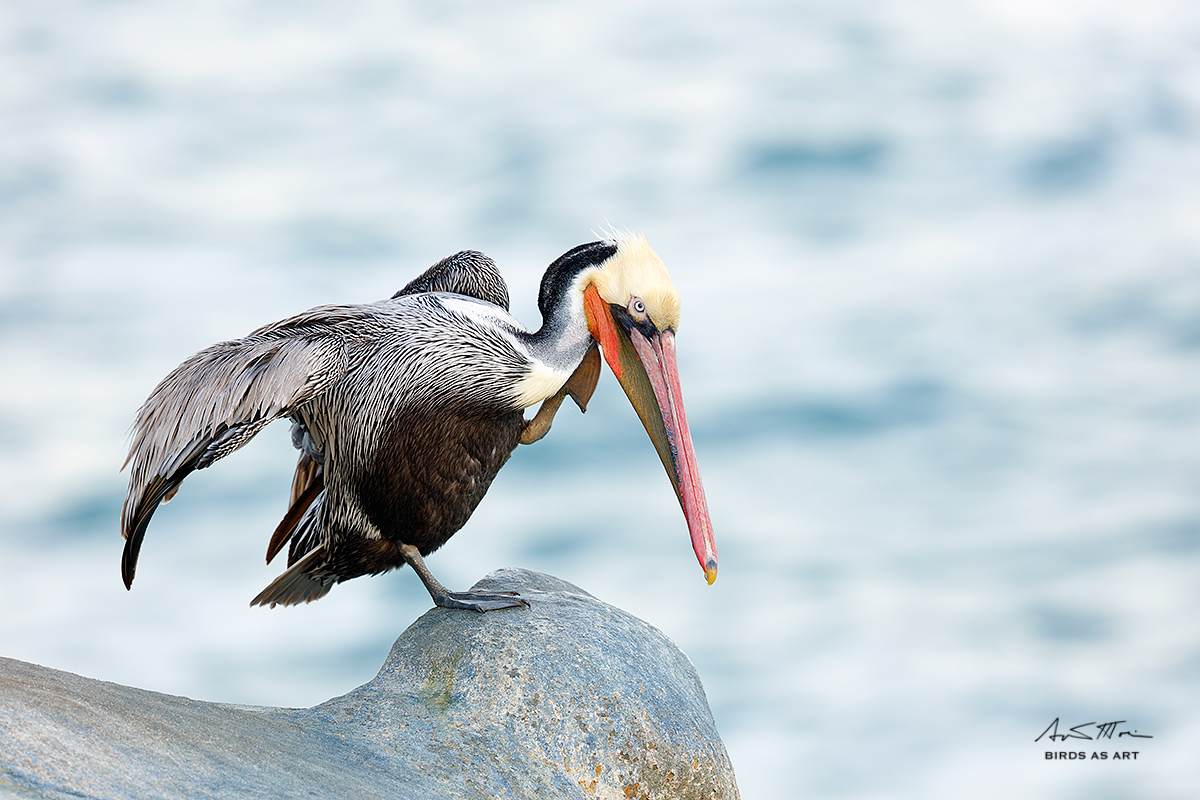
|
|
Here is another one that was created at La Jolla, CA on Day 2 of the 2016 San Diego IPT, this one with the Induro GIT 304L/Mongoose M3.6-mounted Canon EF 500mm f/4L IS II USM lens and the Canon EOS 5DS R. ISO 500. Evaluative metering +1 2/3 stops: 1/250 sec. at f/5.6. Cloudy WB.
Center AF point (Manual selection)/AI Servo Expand/Rear Focus AF as originally framed was active at the moment of exposure. This is a very small crop from the right and the bottom. The active AF point was on the spot where the gray of the neck meets the white. Click here to see the latest version of the Rear Focus Tutorial. Click on the image to see the incredible fine feather detail in a larger version.
Brown Pelican scratching
|
In the recent 5DS R & Canon 500mm f/4L IS II Lens = Breathtaking Image Files… blog post here, I wrote, If you see any evidence of Photoshop hanky panky please let us know what you think I did and offer your proof.
Warren Robb amazed me by leaving this comment: A very nice image, Artie. In order to make your point, I believe nothing was done in Photoshop, not even your usual detail extraction on the head or Eye Doctor work.
He nailed everything. I noted with this image and others that even a 20% opacity layer of my NIK COlor Efex Pro 50/50 recipe actually made them photos look worse rather than improving them. The image as posted was straight out of camera but for a tiny crop to improve the image design.
Well done Rob.
Tuesday’s blog post generated lots of interesting comments and led to my airing of some dirty laundry in yesterday’s blog post. You can see a huge crop of the 5DS R image above and another in that post here.
With regards to that dirty laundry, I received this e-mail from a friend who shall remain unnamed:
That person certainly hasn’t a clue what he’s talking about and probably posted the comment from where he lives – in his parent’s basement. Is he a photographer? Probably not. Did he take the time & trouble to get out onto the La Jolla cliffs and photograph, then share images and tips with the world? Certainly not.
As you know, image quality of a jpeg image is always less than the master RAW or TIFF image. One cannot properly compare the sharpness of a 388K jpeg version posted to the web against the original super-hi-res image. By doing so, he’s proven that (a) he doesn’t understand file types and resolution and (b) he’s one of those “internet critics” that we all know and loathe.
Note his typical “internet critic” phrase: “My guess is that…”. This translates to “I don’t know anything but am so important that I must provide my opinion”
I love your subtle humor in changing his initials to BM! I hope other people caught that.
“Brown Pelican scratching” is awesome. Period. One can see enough detail in the jpeg to know that the original file has a ton more detail. For me, the evidence is in the clearly overlapping feathers – we can even see detail in the feathers beneath them!
I also dig the element of humor in it: a pelican scratching itself like a cat, while standing one-footed on the edge of a rocky precipice above a stormy sea. My favorite wildlife images are those that tell a story about its life, like this one does.
Just breathe and remember this:
“Great spirits have always encountered violent opposition from mediocre minds.” – Albert Einstein
See you soon.
My comments: Nice catch on the “BM.” It could stand for a few things… I do not really understand all the resolution and pixel math stuff but I am pretty sure that I know a good image when I see it. As for the story-telling aspect of the image, thanks for opening up my eyes to that. See you soon. And thanks!
While some felt that it is impossible to judge image quality and fine detail from relatively small JPEGs, Tony Botelho echoed my thoughts exactly when he wrote, I have a good monitor, and I have to say that this photo has a razor cutting sharpness to it like no other! I feel I could just touch the pelican. I love the feel of this image, and how relaxed the pelican is. I don’t know if he is scratching, or just taking a break and waving to the photographers.
Thanks Tony. He was scratching.
The San Diego Site Guide
Whether you are visiting San Diego for photography for the first time or live in the area and have done the pelicans many dozens of times, you will learn a ton by studying the San Diego Site Guide. Why spend days stumbling around when you can know exactly where and when to be depending on the wind direction and sky conditions? In addition to the pelican primer, there is great info on the best beaches for the gorgeous gulls, on Marbled Godwit, on the lower cliffs, Lesser Scaup, and Wood and Ring-necked Ducks as well.
Learn more or purchase your copy here.
Please Remember to use our Affiliate Links 🙂
To show your appreciation for my continuing efforts here, we ask, as always, that you get in the habit of using my B&H affiliate links on the right side of the blog for all of your photo and electronics purchases. Please check the availability of all photographic accessories in the BIRDS AS ART Online Store, especially the Mongoose M3.6 tripod heads, Gitzo tripods, Wimberley heads and plates, LensCoats and accessories, and the like. We sell only what I have used, have tested, and can depend on. We will not sell you junk. We know what you need to make creating great images easy and fun. And we are always glad to answer your gear questions via e-mail. I just learned that my account was suspended during my absence; it should be up and running by Monday at the latest.
I would of course appreciate your using our B&H affiliate links for all of your major gear, video, and electronic purchases. For the photographic stuff mentioned in the paragraph above we, meaning BAA, would of course greatly appreciate your business. Here is a huge thank you to the many who have been using our links on a regular basis and visiting the BAA Online store as well.
Facebook
Be sure to like and follow BAA on Facebook by clicking on the logo link upper right. Tanks a stack!
Typos
In all blog posts and Bulletins, feel free to e-mail or to leave a comment regarding any typos or errors. Just be right 🙂
January 14th, 2016 What’s Up?
I photographed the entire morning at the cliffs with just the 100-400 II hand held. And enjoyed a nice stroll on one of my favorite La Jolla beaches with no birds and a pretty nice sunset. I am nearly finished with my Saturday morning program.
The Streak
In spite of having been buried by travel, teaching, and several major writing projects for the last two months, today’s blog post marks 71 days in a row with a new educational blog post. Please remember to use our B&H links for your major gear purchases.
Important Note
Please understand that if you are up in the air about selling any old gear that the price of your item is dropping every day….
Used Gear Apologies
Apologies to those who have written recently asking about selling their used gear through BAA. I will get back to y’all no later than next Monday (if not before) as I have been swamped with the IPT, the exhibit, and the Saturday morning program 🙂
Selling Your Used Gear Through BIRDS AS ART
Selling your used (or like-new) photo gear through the BAA Blog or via a BAA Online Bulletin is a great idea. We charge only a 5% commission. One of the more popular used gear for sale sites charges a minimum of 20%. Plus assorted fees! Yikes. The minimum item price here is $500 (or less for a $25 fee). If you are interested please e-mail with the words Items for Sale Info Request cut and pasted into the Subject line :). Stuff that is priced fairly–I offer free pricing advice, usually sells in no time flat. In the past few months, we have sold just about everything in sight. Do know that prices on some items like the EOS-1D Mark IV, the old Canon 500mm, the EOS-7D, and the original 400mm IS DO lens have been dropping steadily. You can see all current listings by clicking here or by clicking on the Used Photo Gear tab on the yellow-orange tab on the right side of the menu bar above.
New Listings
Canon EF 300mm f/4L IS USM
Caleb Putnam is offering a used Canon EF 300mm f/4L IS USM lens in very good plus condition with pristine glass for $649. The sale includes the original boxes with all the original contents: manuals and lens case, front and rear caps, cords, CD roms, etc., and insured ground shipping via major courier. Your item will not ship until your check clears unless other arrangements are made.
Please contact Caleb by e-mail or phone at 616-826-2098 (central time zone).
The 300 f/4 makes a great starter lens for all beginning nature photographers. As it is an image stabilized lens and you get all AF points with a 1.4X TC I consider this lens better than my beloved toy lens, the old 400mm f/5.6L lens. Even better, the close focus of the 300 f/4IS makes it great for large bugs and butterflies and medium- and large-sized flowers. artie
Caleb Putnam is also offering a used Canon 60D body in excellent condition for $349. The sale includes the original boxes with all the original contents and insured ground shipping via major courier. Your item will not ship until your check clears unless other arrangements are made.
Please contact Caleb by e-mail or phone at 616-826-2098 (central time zone).
Canon 800mm f/5.6L IS USM Lens
Andres Leon is offering a used Canon 800mm f/5.6L IS lens in Very Good Plus condition for the very low price of $7899. The lens has clean glass and is in perfect working order but has a few scratches on the finish. Feel free to request photos of the lens. The sale includes the lens trunk and keys, a LensCoat, the front leather cover, the rear cap, a Wimberley P-40 lens plate, and insured ground shipping via FED-EX Ground. Your item will not ship until your check clears unless other arrangements are made. Please contact Andres via or by phone at 1-954-621-6678 (eastern time).
I used this lens, often with a 1.4X TC, as my main super-telephoto lens for close to five years. It is a superb lens that offers lots of reach for those working with birds that are skittish. It is great from the car. I was astounded that about 15 of the 67 images in the exhibit were created with my 800. I often miss it terribly. As the lens sells new at B&H for $12,999, Andres’s lens is a superb buy; grab it now and save more than $5K! artie
|
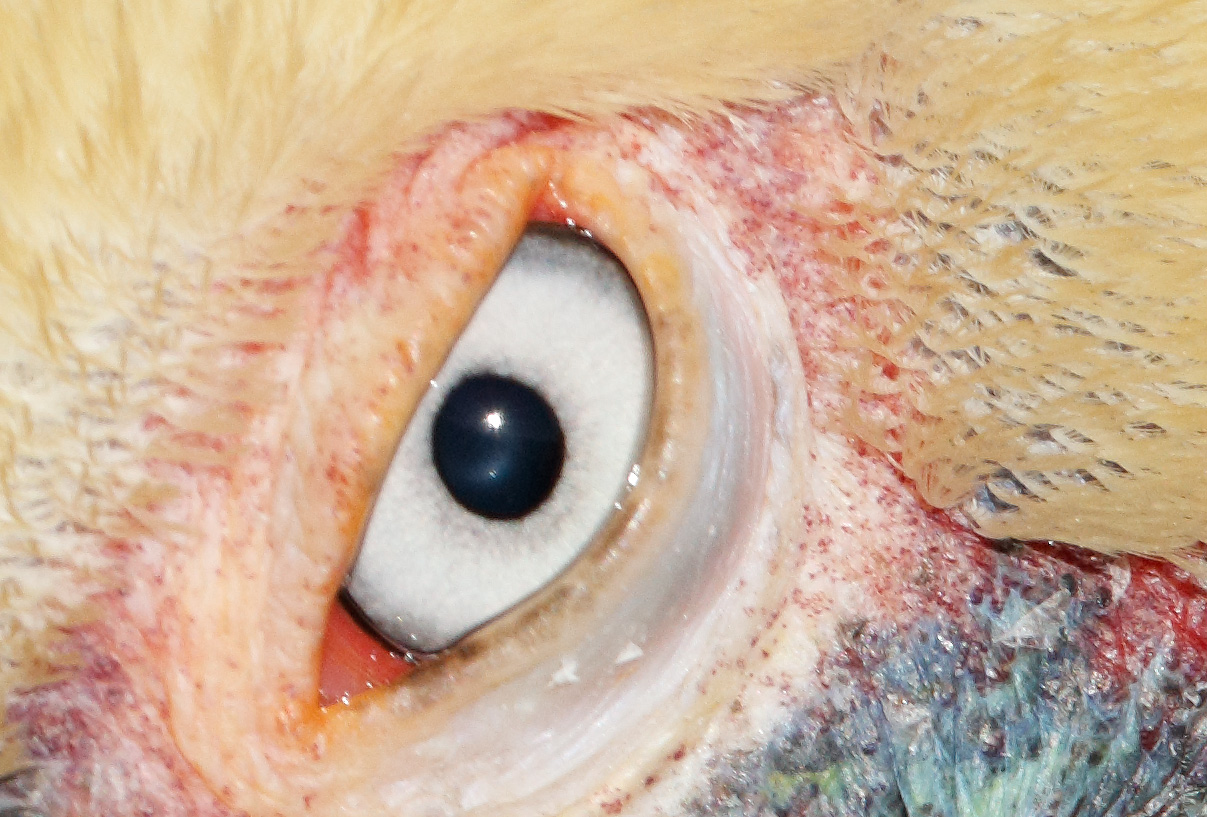
|
|
This image was created at La Jolla, CA on the last morning of the hugely successful 2016 San Diego IPT with the Induro GIT 304L/Mongoose M3.6-mounted Canon EF 500mm f/4L IS II USM lens, the Canon Extender EF 2X III, and the Canon EOS 5DS R. ISO 400: 1/640 sec. at f/11. AWB.
Center AF point (by necessity)/AI Servo Expand/Rear Focus AF as originally framed was active at the moment of exposure. This is a very, very, small crop from the left and the top. Click here to see the latest version of the Rear Focus Tutorial. Click on the image to see the incredible fine feather detail in a larger version.
Tight Crop of Brown Pelican bill pouch detail image
|
Two 100% 5DS R Crops
Presented here today are two tight crops of 5DS R images from recent previous blog posts. I am not quite sure if they are true 100% crops but here is how I made them. I cropped the unsharpened master TIFF file approximately to 1200 pixels wide by 800 pixels tall and saved those as JPEGs. Then they were optimized to < 395kb and then presented as 800 wide JPEGs here on Word Press.
I am quite impressed by the fine feather detail and sharpness.
Mud on Your Shoes?
A guest comes to your home with mud on their shoes. You ask him or her to remove their shoes before coming in. They proceed to walk all over your new white carpet. In general, such folks would not be invited back again.
The blog is my home.
|
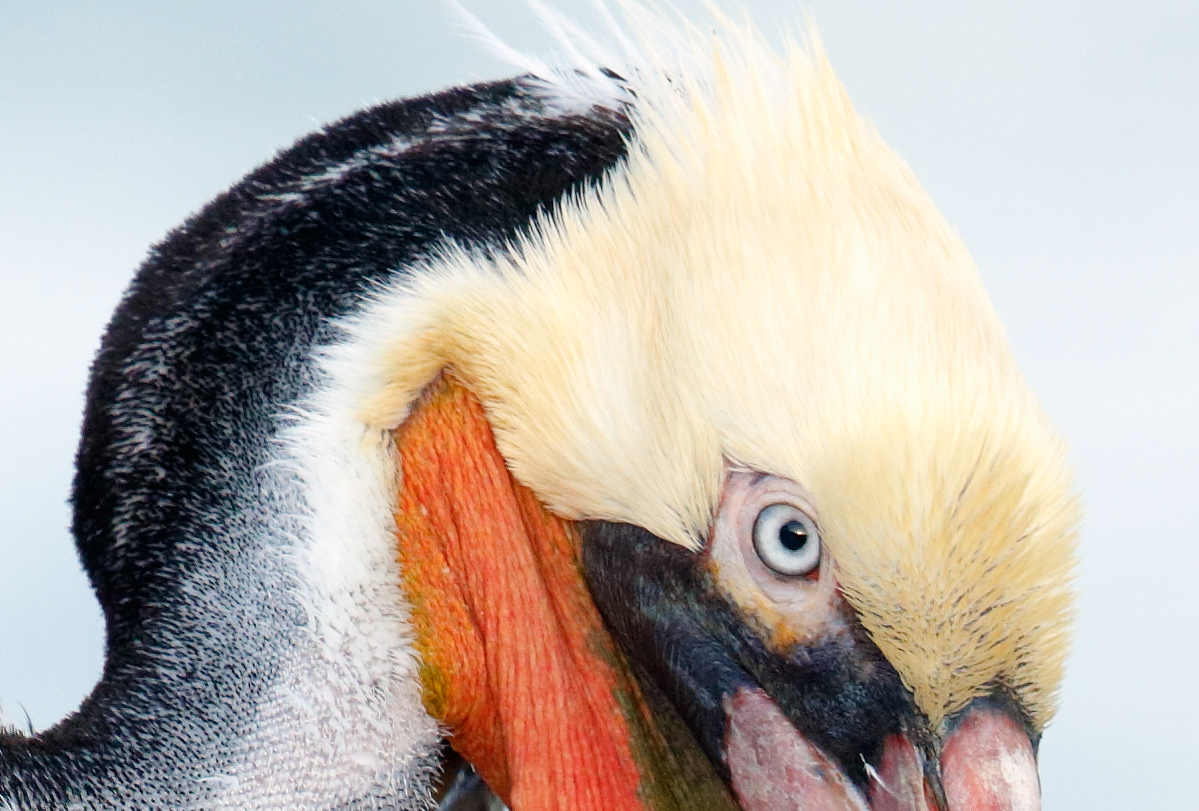
|
|
Here is another one that was created at La Jolla, CA on Day 2 of the 2016 San Diego IPT, this one with the Induro GIT 304L/Mongoose M3.6-mounted Canon EF 500mm f/4L IS II USM lens and the Canon EOS 5DS R. ISO 500. Evaluative metering +1 2/3 stops: 1/250 sec. at f/5.6. Cloudy WB.
Center AF point (Manual selection)/AI Servo Expand/Rear Focus AF as originally framed was active at the moment of exposure. This is a very small crop from the right and the bottom. The active AF point was on the spot where the gray of the neck meets the white. Click here to see the latest version of the Rear Focus Tutorial. Click on the image to see the incredible fine feather detail in a larger version.
Tight crop of Brown Pelican scratching image
|
Airing Some Dirty Laundry
Some of you may have caught part or all of this exchange in the comments section of the blog post here. The initials have been changed to protect the guilty.
BM: Ok,I’ll put my two cents in, but reluctantly. I think Jon’s comment, “The image looks fine to me” is just the kind of faint praise this image deserves. I’m looking at it on my iPad Air 2 with Retina display which has a pixel density of about 400ppi and frankly I’ve seen much sharper (more detail) from my 7D II. My guess is that those 50MPs are of little value unless your going to make very large blowups or need to severely crop. I’m also fully aware that two cent opinions are almost always worthless to the recipient.
First, please realize that most folks would simply delete the comment above. My gut feeling that BM was at least trying to bait me. I for one have never seen a 7D II image that looked half as good as the pelican scratching image for fine detail and image quality. But I cut the guy some slack and posted this:
Maybe your i-pad is defective or you need new glasses, or perhaps I don’t know jack-_ _ _ _ about nature photography. If not, you are way over-rating the value of your opinion at 2 cents. For me, this image screams sharp and detailed off my monitor and is far superior to anything I have ever created with a 7D II.
In short order BM wrote back:
Sadly Art, your response is even more acerbic than I predicted.
To me, it was quite obvious that BM had been intentionally nasty in his original post. Why else would he have expected a nasty reaction from me?
Acerbic (adjective): harsh or severe, as of temper or expression.
I spammed him immediately for walking on my white carpet with mud on his shoes.
Please do not take this to mean that I will bear no criticism here on the blog. Folks who offer honest criticisms are welcome. I have learned a bunch from such comments over the years.
Not knowing that he had been spammed, BM wrote:
Art – It was you that asked for opinions, but when I offered mine you respond with a personal attack. I’m sure a 50mp full frame has many advantages over a cropped 20mp, but responding with such vitriol if far from enlightening.
I would point out to BM that I did not attack him personally. I did not, for example, call him a stupid idiot. I am 100% sure that BM’s original post was intended to raise my hackles. In that he succeeded. He is, however, no longer welcome as guest in my house.
“The faint praise that this image deserves…” Please. How’d that work out?
The San Diego Site Guide
Whether you are visiting San Diego for photography for the first time or live in the area and have done the pelicans many dozens of times, you will learn a ton by studying the San Diego Site Guide. Why spend days stumbling around when you can know exactly where and when to be depending on the wind direction and sky conditions? In addition to the pelican primer, there is great info on the best beaches for the gorgeous gulls, on Marbled Godwit, on the lower cliffs, Lesser Scaup, and Wood and Ring-necked Ducks as well.
Learn more or purchase your copy here.
Please Remember to use our Affiliate Links 🙂
To show your appreciation for my continuing efforts here, we ask, as always, that you get in the habit of using my B&H affiliate links on the right side of the blog for all of your photo and electronics purchases. Please check the availability of all photographic accessories in the BIRDS AS ART Online Store, especially the Mongoose M3.6 tripod heads, Gitzo tripods, Wimberley heads and plates, LensCoats and accessories, and the like. We sell only what I have used, have tested, and can depend on. We will not sell you junk. We know what you need to make creating great images easy and fun. And we are always glad to answer your gear questions via e-mail. I just learned that my account was suspended during my absence; it should be up and running by Monday at the latest.
I would of course appreciate your using our B&H affiliate links for all of your major gear, video, and electronic purchases. For the photographic stuff mentioned in the paragraph above we, meaning BAA, would of course greatly appreciate your business. Here is a huge thank you to the many who have been using our links on a regular basis and visiting the BAA Online store as well.
Facebook
Be sure to like and follow BAA on Facebook by clicking on the logo link upper right. Tanks a stack!
Typos
In all blog posts and Bulletins, feel free to e-mail or to leave a comment regarding any typos or errors. Just be right 🙂
January 13th, 2016 What’s Up?
Wow: what a finish!
When we arrived at the cliffs there were no pelicans. And there were none in sight. And then they came, and came, and came, and landed right in front of us. We had some great flight chances. Some of the participants concentrated on head throws and I joined them for a while. But since one bird was more beautiful than the next, and they were all just sitting there set against gorgeous blue water Pacific Ocean backgrounds, I soon succumbed, grabbed my 500 II with the 2X III TC and the EOS 5DS R, and went to work doing what I love to do best: make clean, tight, and graphic images.
Participants began leaving to head home as early as 9:30am and trickled away for the next hour. There were lots of thanks and hugs all around. It really was a wonderful group. As usual, we had about 60% recidivists. I always take that as a good sign; if folks return for another IPT it is a indication that you are doing things right. Many thanks to co-leader Denise Ippolito who did her usual stellar job; it is amazing how perfectly our teaching skills mesh. And huge thanks to all who joined us.
By 10:30am there was just one pelican left. And only one photographer. And you can guess who that was…
birds as art: The Avian Photography of Arthur Morris
At TheNat–the San Diego Natural History Museum, San Diego, California
Learn more here. Learn about the opening NATtalk, Choosing and Using Lenses for Bird and Nature Photography, here.
The Streak
In spite of having been buried by travel, teaching, and several major writing projects for the last two months, today’s blog post marks 70 days in a row with a new educational blog post. Please remember to use our B&H links for your major gear purchases.
Important Note
Please understand that if you are up in the air about selling any old gear that the price of your item is dropping every day….
Used Gear Apologies
Apologies to those who have written recently asking about selling their used gear through BAA. I will get back to y’all no later than next Monday (if not before) as I have been swamped with the IPT, the exhibit, and the Saturday morning program 🙂
Selling Your Used Gear Through BIRDS AS ART
Selling your used (or like-new) photo gear through the BAA Blog or via a BAA Online Bulletin is a great idea. We charge only a 5% commission. One of the more popular used gear for sale sites charges a minimum of 20%. Plus assorted fees! Yikes. The minimum item price here is $500 (or less for a $25 fee). If you are interested please e-mail with the words Items for Sale Info Request cut and pasted into the Subject line :). Stuff that is priced fairly–I offer free pricing advice, usually sells in no time flat. In the past few months, we have sold just about everything in sight. Do know that prices on some items like the EOS-1D Mark IV, the old Canon 500mm, the EOS-7D, and the original 400mm IS DO lens have been dropping steadily. You can see all current listings by clicking here or by clicking on the Used Photo Gear tab on the yellow-orange tab on the right side of the menu bar above.
Things have been heating up on the Used Gear page lately.
- With three offers on the day his lens was listed the sale of Mike Quigley’s Canon 500mm f/4L IS lens (the old five) sold in early January.
- Bill Ellison sold his 100-400 for $650 in early January, 2016.
- Alice Garland sold her Canon 500mm f/4L IS Lens for $3999 in late December 2015.
- Doug Rogers sold his Canon 100–400mm L IS zoom lens (the old 1-4) for $649 in late December 2015.
- Troy Duong sold his Canon 500mm f/4L IS II lens for $7500.00 in late December 2015.
- Walt Anderson sold his used Canon 1D X for $3000 in late December to a BAA friend before it was even listed!
- Larry Master sold his Canon EOS-1D Mark IV in excellent condition for $1399 in mid-December 2015.
- Melissa Hahn sold her Canon 400mm f/2.8L IS II lens in mint condition now for $8299 in early December, 2015.
- Monte Brown sold his 300mm f/2.8L II lens in near-mint condition for $4499 two days after it was listed in mid-December, 2015.
- Stephen Zarate sold his used Canon 100-400mm L IS zoom lens very quickly in early December for $650, the original asking price.
New Listings
Canon 800mm f/5.6L IS USM Lens
Andres Leon is offering a used Canon 800mm f/5.6L IS lens in Very Good Plus condition for the very low price of $7899. The lens has clean glass and is in perfect working order but has a few scratches on the finish. Feel free to request photos of the lens. The sale includes the lens trunk and keys, a LensCoat, the front leather cover, the rear cap, a Wimberley P-40 lens plate, and insured ground shipping via FED-EX Ground. Your item will not ship until your check clears unless other arrangements are made. Please contact Andres via e-mail or by phone at 1-954-621-6678 (eastern time).
I used this lens, often with a 1.4X TC, as my main super-telephoto lens for close to five years. It is a superb lens that offers lots of reach for those working with birds that are skittish. It is great from the car. I was astounded that about 15 of the 67 images in the exhibit were created with my 800. I often miss it terribly. As the lens sells new at B&H for $12,999, Andres’s lens is a superb buy; grab it now and save more than $5K! artie
Canon 300mm f2.8L IS USM Lens
Roberta Olenick is offering a used Canon 300mm f/2.8L IS USM lens in near-mint condition for $2950 USD. The sale includes the original lens trunk with keys, the leather front lens cover, the rear lens cap, and insured ground shipping via UPS Ground to either the US or Canada. Your item will not ship until your check clears unless other arrangements are made. Please contact Roberta by e-mail (preferred) or by phone at 604-224-0724 (Pacific time).
I met Jake Levin on a recent IPT about a year ago. He just completed his second IPT here in San Diego. He was and is obsessed with image sharpness. He purchased an old 300mm f/2.8 from the Used Gear listings and is now thrilled with his images. This makes a great workhorse telephoto lens when used either naked or with either TC and a 7D Mark II. Roberta’s is priced to sell. artie
Canon EOS-1D Mark IV
Roberta Olenick is also offering a used Canon EOS-1D Mark IV camera body in excellent condition for $1279 USD. The sale includes the Really Right Stuff camera plate B1DMKIII, three batteries (the original and two spares), the original charger, the stereo AV cable, the cable protector with attaching screw, gridded focusing screen Ec-D and the original focusing screen (these two are interchangeable), the never-used original lens strap still in the package, the front cap, printed manuals in English and French, original box, and insured ground shipping via UPS within US or Canada. Your item will not ship until your check clears unless other arrangements are made. Please contact Roberta by e-mail (preferred) or by phone at 604-224-0724 (Pacific time).
As regular readers know, two 1D IVs served as my workhorse professional camera bodies for about four years. They are fast, rugged, and dependable and produce high quality image files when in the hands of a competent photographer. artie
|

|
|
This image was created at La Jolla, CA on the last morning of the hugely successful 2016 San Diego IPT with the Induro GIT 304L/Mongoose M3.6-mounted Canon EF 500mm f/4L IS II USM lens, the Canon Extender EF 2X III, and the Canon EOS 5DS R. ISO 400: 1/640 sec. at f/11. AWB.
Center AF point (by necessity)/AI Servo Expand/Rear Focus AF as originally framed was active at the moment of exposure. This is a very, very, small crop from the left and the top. Click here to see the latest version of the Rear Focus Tutorial. Click on the image to see the incredible fine feather detail in a larger version.
Brown Pelican bill pouch detail
|
Eye-opening Image!
This breeding plumage Pacific race Brown Pelican was in peak condition and as clean and as bright as any I have ever seen. I was fixated on his red bill pouch so I went to 1000mm. The problem was that as the bird preened its neck it refused to open its eye. He did once for one second and I was thrilled to come up with a sharp, dramatic image with a perfect head angle; you could say that I was one for one.
The San Diego Site Guide
Whether you are visiting San Diego for photography for the first time or live in the area and have done the pelicans many dozens of times, you will learn a ton by studying the San Diego Site Guide. Why spend days stumbling around when you can know exactly where and when to be depending on the wind direction and sky conditions? In addition to the pelican primer, there is great info on the best beaches for the gorgeous gulls, on Marbled Godwit, on the lower cliffs, Lesser Scaup, and Wood and Ring-necked Ducks as well.
Learn more or purchase your copy here.
Please Remember to use our Affiliate Links 🙂
To show your appreciation for my continuing efforts here, we ask, as always, that you get in the habit of using my B&H affiliate links on the right side of the blog for all of your photo and electronics purchases. Please check the availability of all photographic accessories in the BIRDS AS ART Online Store, especially the Mongoose M3.6 tripod heads, Gitzo tripods, Wimberley heads and plates, LensCoats and accessories, and the like. We sell only what I have used, have tested, and can depend on. We will not sell you junk. We know what you need to make creating great images easy and fun. And we are always glad to answer your gear questions via e-mail. I just learned that my account was suspended during my absence; it should be up and running by Monday at the latest.
I would of course appreciate your using our B&H affiliate links for all of your major gear, video, and electronic purchases. For the photographic stuff mentioned in the paragraph above we, meaning BAA, would of course greatly appreciate your business. Here is a huge thank you to the many who have been using our links on a regular basis and visiting the BAA Online store as well.
Facebook
Be sure to like and follow BAA on Facebook by clicking on the logo link upper right. Tanks a stack!
Typos
In all blog posts and Bulletins, feel free to e-mail or to leave a comment regarding any typos or errors. Just be right 🙂
January 12th, 2016 What’s Up?
In the morning, co-leader Denise Ipplito took several pelican loving participants back to the cliffs for more while co-leader Arthur Morris escorted the duck-hungry folks back to Santee Lakes. In the afternoon we headed to another of my favorite beaches and pretty much struck out on birds. Many folks hung with me photographing patterns in the sandstone rocks while learning and utilizing my flower technique: Av mode with Live View for mirror lock and 2-second self timer and either AEB or in-camera HDR. Lots of folks stayed with Denise and photographed the big pier. We all got together to photograph the meg-sunset we had been hoping for. It was well worth the wait.
|

|
|
Here is another one that was created at La Jolla, CA on Day 2 of the 2016 San Diego IPT, this one with the Induro GIT 304L/Mongoose M3.6-mounted Canon EF 500mm f/4L IS II USM lens and the Canon EOS 5DS R. ISO 500. Evaluative metering +1 2/3 stops: 1/250 sec. at f/5.6. Cloudy WB.
Center AF point (Manual selection)/AI Servo Expand/Rear Focus AF as originally framed was active at the moment of exposure. This is a very small crop from the right and the bottom. The active AF point was on the spot where the gray of the neck meets the white. Click here to see the latest version of the Rear Focus Tutorial. Click on the image to see the incredible fine feather detail in a larger version.
Brown Pelican scratching
|
5DS R & Canon 500mm f/4L IS II Lens = Breathtaking Image Files…
If you are on a decent monitor please click on the image to enlarge it and let me know what you think of the image quality. When I have used my 500 II on this trip I have been using the 5DS R exclusively.
Photoshop Hanky Panky?
If you see any evidence of Photoshop hanky panky please let us know what you think I did and offer your proof.
The San Diego Site Guide
Whether you are visiting San Diego for photography for the first time or live in the area and have done the pelicans many dozens of times, you will learn a ton by studying the San Diego Site Guide. Why spend days stumbling around when you can know exactly where and when to be depending on the wind direction and sky conditions? In addition to the pelican primer, there is great info on the best beaches for the gorgeous gulls, on Marbled Godwit, on the lower cliffs, Lesser Scaup, and Wood and Ring-necked Ducks as well.
Learn more or purchase your copy here.
Please Remember to use our Affiliate Links 🙂
To show your appreciation for my continuing efforts here, we ask, as always, that you get in the habit of using my B&H affiliate links on the right side of the blog for all of your photo and electronics purchases. Please check the availability of all photographic accessories in the BIRDS AS ART Online Store, especially the Mongoose M3.6 tripod heads, Gitzo tripods, Wimberley heads and plates, LensCoats and accessories, and the like. We sell only what I have used, have tested, and can depend on. We will not sell you junk. We know what you need to make creating great images easy and fun. And we are always glad to answer your gear questions via e-mail. I just learned that my account was suspended during my absence; it should be up and running by Monday at the latest.
I would of course appreciate your using our B&H affiliate links for all of your major gear, video, and electronic purchases. For the photographic stuff mentioned in the paragraph above we, meaning BAA, would of course greatly appreciate your business. Here is a huge thank you to the many who have been using our links on a regular basis and visiting the BAA Online store as well.
Facebook
Be sure to like and follow BAA on Facebook by clicking on the logo link upper right. Tanks a stack!
Typos
In all blog posts and Bulletins, feel free to e-mail or to leave a comment regarding any typos or errors. Just be right 🙂
January 11th, 2016 What’s Up?
It was cloudy with a light mist on the morning of Day 3 of the San Diego IPT. We did well at the cliffs with lots of nice pelicans and more chances on the pair of Brown Boobies. We had a great lunch at The Crab Catcher in La Jolla. As reported the Wood Ducks at Santee were nowhere near up to par but we did have lots of drake and hen Ring-necked Ducks along with a (finally) cooperative male Ruddy Duck in winter plumage.
|
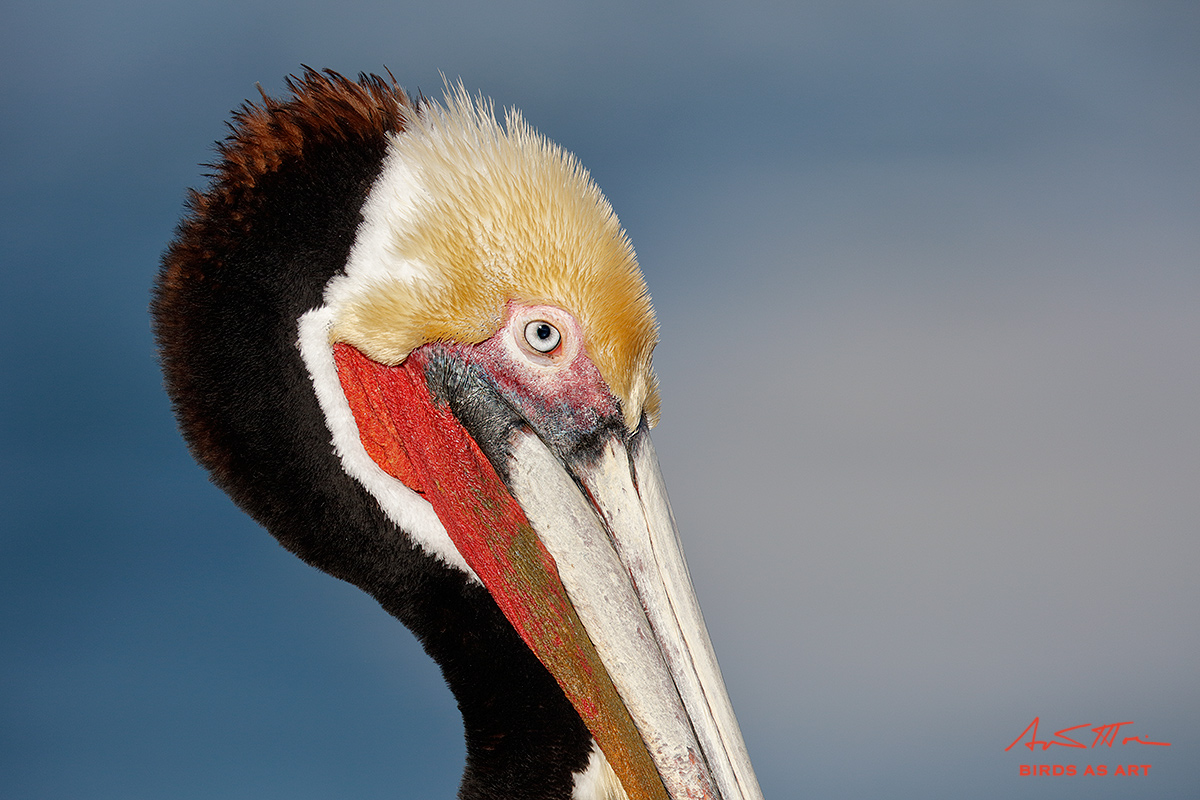
|
|
Like yesterday’s peregrine image, this image was created at La Jolla, CA on Day 2 of the 2016 San Diego IPT with the Induro GIT 304L/Mongoose M3.6-mounted Canon EF 500mm f/4L IS II USM lens, the Canon Extender EF 2X III, and the Canon EOS 5DS R. ISO 400: 1/1250 sec. at f/9. AWB.
Center AF point (by necessity)/AI Servo Expand/Rear Focus AF as originally framed was active at the moment of exposure. This is a very small crop from the left and the bottom. Click here to see the latest version of the Rear Focus Tutorial. Click on the image to see the incredible fine feather detail in a larger version.
Brown Pelican face detail
|
Dealing With My New 1000mm Lens and the Canon 5DS R…
Going back to the 7D II and long effective focal lengths, I had the gut feeling that lens shake was more of a factor than with previous camera bodies and assumed that what I was sensing was because of the higher mega-pixel counts. Most folks disagreed but I was still sure that with a 7D II, and more recently with the 5DS R, that one had better keep the lens perfectly still in order to create sharp images.
As it turns out, it looks as if I was both wrong and right. Right about my gut feeling that lens shake was more of a factor with both the 7D II and the 5DS R than with previous camera bodies, and wrong about the reason. Below are selected quotes from an e-mail from good friend and many multiple IPT veteran Alan Lillich.
First a definition. Pixel pitch the distance from the center of one pixel to the center of the next pixel measured in microns, millionths of a millimeter.
Here is my take, derived from basic principles. Remember that pixel pitch is just the spacing of the pixels. All of my body-to-body comparisons assume the same lens–side by side, the same aperture and shutter speed, at the same subject distance. The visibility of shake is measured by viewing at 100%, looking at the sharpness of the finest subject details.
With a given camera body, lens, tripod,tripod head, wind, shutter speed, and level of operator skill there will be a certain amount of shake during the exposure. Physically this shake means the image moves across the sensor during the exposure. How much it moves is a just a distance. How visible it is depends on the pixel spacing. (And probably on the AA filter, Bharat’s comment in the previous post on this subject is interesting.) I have no idea what the actual shake amount is in any situation, nor exactly how much the AA filter (on all the bodies but the 5DS R) smears things. We do know the pixel spacing for specific bodies, but for this discussion all that matters is the ratio of shake to pixel spacing.
If the shake is less than the distance between pixels then it will be invisible. The more pixels it covers, the more visible it is. It is hard to compare given the span of time and changes like the improvements in IS with the Series II super-telephotos. With each new camera the same sensor size with more pixels means tighter pixel spacing (smaller pixel pitch); the same shake will cover more pixels and be more visible.
Let’s compare the 7D II to the 1D IV. The 7D II has a pixel pitch of 4.1 microns, the 1D IV has a pixel pitch of 5.7 microns. So a 12 micron shake would cover about 3 pixels on a 7D II and about 2 pixels on the 1D IV. In other words, the shake should be 50% more visible on the 7D II than on the 1D IV. You have to be that much more careful with the 7D II than with the 1D IV.
The 5DS and the 5DS R have a pixel pitch of 4.14 microns. I’m getting these numbers from quick web searches. So I’m confident they are accurate, but don’t know how precise. The 7D II number I saw was just 4.1, with no hundredths digit. Let’s just say the 7D II and 5DS have the same pixel pitch. So the 12 micron shake mentioned above would also cover 3 pixels on the 5DS and the shake has the same effect as on the 7D II. So you need to use the same care with the 7DF II and the 5DS.
Again, this is with same lens, side by side, same subject. Another way to look at this, especially relevant to 100% examination, is the effect on subject detail. The projected image on the sensor has a size determined by the lens and subject distance. A bird’s eye or feather details will be a certain physical size on the sensor. So a certain amount of shake will affect a certain fraction of the most detailed features. How visible those features are depends on the pixel size.
Now let’s consider the anti-aliasing (AA) filter on all cameras but the 5DS R. As Bharat’s comment pointed out, it blurs things so will hide some degree of shake.
What this means is that you need more care with a 5DS R than with a 5DS or 7D II.
Bottom line, better technique will get you better photos in general. The smaller the pixels and the tighter the pixel pitch, the better technique you need. Pixel count alone is not relevant. All of this of course in a theoretical same lens side by side situation. Suppose you and I are sitting side by side on the lower shelf at the Cave Store cliffs shooting tight portraits of pelicans. We have the same lens, but you have a 5DS and I have a 7D II. You can’t get closer without scaring the birds, I can’t move back because of the cliff. So we can’t get the same framing but do get the same pixel coverage of subject features. So we need equal technique for equal sharpness as seen at 100%. With you owning and using the 5DS R, you actually need to take a bit more care as there is no AA filter to blur the effects of lens shake.
Though you many not previously have understood all the technical stuff above, I think you have grasped all of it inherently given the magic you do with super-telephoto lenses used with either teleconverter at slow shutter speeds…
So Yeah…
So yeah, when working with the 5DS R at long effective focal lengths, I do need to take extra care in order to create super sharp images. With today’s featured image, a fast shutter speed did the trick. With yesterday’s peregrine image made at a much slower shutter speed, I made sure that the tripod legs were firmly planted in the soft hillside earth, made sure to press my face against the back of the camera, made sure to tighten both the horizontal and vertical panning knobs on the Mongoose M3.6, and made sure to steady the lens with my left hand. Most of the time I support the lens barrel from below with my left hand while my forearm rests near the tripod platform; at other times I place my left hand atop the lens barrel. Which I do depends on the situation and is not anything that I could put into words. It is more of that gut feeling stuff.
The San Diego Site Guide
Whether you are visiting San Diego for photography for the first time or live in the area and have done the pelicans many dozens of times, you will learn a ton by studying the San Diego Site Guide. Why spend days stumbling around when you can know exactly where and when to be depending on the wind direction and sky conditions? In addition to the pelican primer, there is great info on the best beaches for the gorgeous gulls, on Marbled Godwit, on the lower cliffs, Lesser Scaup, and Wood and Ring-necked Ducks as well.
Learn more or purchase your copy here.
Please Remember to use our Affiliate Links 🙂
To show your appreciation for my continuing efforts here, we ask, as always, that you get in the habit of using my B&H affiliate links on the right side of the blog for all of your photo and electronics purchases. Please check the availability of all photographic accessories in the BIRDS AS ART Online Store, especially the Mongoose M3.6 tripod heads, Gitzo tripods, Wimberley heads and plates, LensCoats and accessories, and the like. We sell only what I have used, have tested, and can depend on. We will not sell you junk. We know what you need to make creating great images easy and fun. And we are always glad to answer your gear questions via e-mail. I just learned that my account was suspended during my absence; it should be up and running by Monday at the latest.
I would of course appreciate your using our B&H affiliate links for all of your major gear, video, and electronic purchases. For the photographic stuff mentioned in the paragraph above we, meaning BAA, would of course greatly appreciate your business. Here is a huge thank you to the many who have been using our links on a regular basis and visiting the BAA Online store as well.
Facebook
Be sure to like and follow BAA on Facebook by clicking on the logo link upper right. Tanks a stack!
Typos
In all blog posts and Bulletins, feel free to e-mail or to leave a comment regarding any typos or errors. Just be right 🙂
January 10th, 2016 What’s Up?
Even before I left for San Diego I felt as if I might be losing my voice. Dr. Oliver suggested that I get some Dr. King’s Sore Throat & Laryngitis spray by King Bio. I had it delivered to the hotel. Wow; it worked wonders. I have felt just fine for the past few days. That is a very good feeling after being under the weather for more than 10 weeks.
|
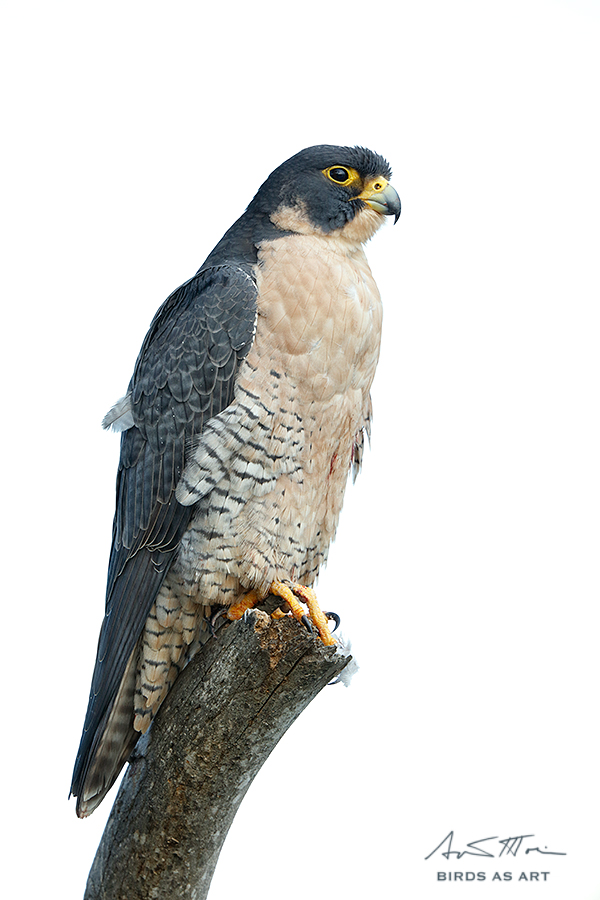
|
|
This image was created at La Jolla, CA on Day 2 of the 2016 San Diego IPT with the Induro GIT 304L/Mongoose M3.6-mounted Canon EF 500mm f/4L IS II USM lens, the Canon Extender EF 2X III, and the Canon EOS 5DS R. ISO 800: 1/160 sec. at f/10 (to the point of significant blinkies on the sky). AWB.
Center AF point (Manual selection)/AI Servo Expand/Rear Focus AF on the bird’s eye and re-compose. Click here to see the latest version of the Rear Focus Tutorial. Click on the image to see a larger version.
Peregrine Falcon, perched female
|
La Jolla Treasure: Bird Name Starting With P–Not a Pelican…
Several folks in the group had asked about Peregrine Falcon. “We see them pretty regularly at La Jolla but I have never had a really good chance with them.” That is, until the morning of Saturday, January 9, 2016. We were working the pelicans but with the improving weather and the weekend crowd of photographers there were fewer by far than there had been the previous two days. We had some excitement earlier in the morning when co-leader Denise Ippolito relocated the Brown Booby that she has seen the day before. Several of us made some not-too-great images of this rare La Jolla visitor.
A birder called out “peregrine” and pointed to the lovely lady perched in a pine tree on the hillside behind us. An hour later all but one of the participants had photographed the heck out of her. Including yours truly. It was a great teaching situation as we were able to go over exposure settings, help folks with their tripod handling and sharpness techniques, and comment on image design.
The lone participant who passed on the peregrine did so because he was completely fixated on the beauty and the colors of the Brown Pelicans.
The San Diego Site Guide
Whether you are visiting San Diego for photography for the first time or live in the area and have done the pelicans many dozens of times, you will learn a ton by studying the San Diego Site Guide. Why spend days stumbling around when you can know exactly where and when to be depending on the wind direction and sky conditions? In addition to the pelican primer, there is great info on the best beaches for the gorgeous gulls, on Marbled Godwit, on the lower cliffs, Lesser Scaup, and Wood and Ring-necked Ducks as well.
Learn more or purchase your copy here.
Please Remember to use our Affiliate Links 🙂
To show your appreciation for my continuing efforts here, we ask, as always, that you get in the habit of using my B&H affiliate links on the right side of the blog for all of your photo and electronics purchases. Please check the availability of all photographic accessories in the BIRDS AS ART Online Store, especially the Mongoose M3.6 tripod heads, Gitzo tripods, Wimberley heads and plates, LensCoats and accessories, and the like. We sell only what I have used, have tested, and can depend on. We will not sell you junk. We know what you need to make creating great images easy and fun. And we are always glad to answer your gear questions via e-mail. I just learned that my account was suspended during my absence; it should be up and running by Monday at the latest.
I would of course appreciate your using our B&H affiliate links for all of your major gear, video, and electronic purchases. For the photographic stuff mentioned in the paragraph above we, meaning BAA, would of course greatly appreciate your business. Here is a huge thank you to the many who have been using our links on a regular basis and visiting the BAA Online store as well.
Facebook
Be sure to like and follow BAA on Facebook by clicking on the logo link upper right. Tanks a stack!
Typos
In all blog posts and Bulletins, feel free to e-mail or to leave a comment regarding any typos or errors. Just be right 🙂
|
|































